|
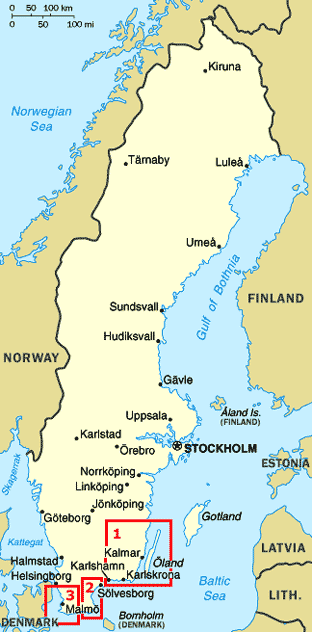 CAMPING
IN SWEDEN 2013 - Baltic Island of Öland, Kalmar, Karlskrona, Kristianstad, Åhus,
Kivik, Stenshuvud National Park, SW coast
of Skåne,
Ystad,
Falsterbo peninsula, Malmö, Öresund Bridge for
return to Denmark and UK: CAMPING
IN SWEDEN 2013 - Baltic Island of Öland, Kalmar, Karlskrona, Kristianstad, Åhus,
Kivik, Stenshuvud National Park, SW coast
of Skåne,
Ystad,
Falsterbo peninsula, Malmö, Öresund Bridge for
return to Denmark and UK:
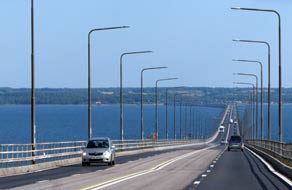 The
island of Öland: at
Kalmar we crossed the 6km long, high-arching toll-free bridge over the Kalmar
Sound to the Baltic Island of Öland which was to be our home for the next 5 days
(see left). The slender island is one long limestone plateau, scoured by the
last Ice Age's retreating ice, leaving a unique geology and flora. Öland had
been a royal hunting ground from the mid-16th century until 1801, ruled with
scant regard for its native peasant farmers who were barred from chopping wood,
hunting animals or selling their produce on the open market. Danish attacks
added to the Ölanders' miseries, and a series of disastrous harvests in
mid-19th century led to a quarter of the population emigrating to seek a new
life in America. Wooden windmills dating from the 18th century still cover Öland, and as we drove northwards from the bridge towards the
island's main town of Borgholm, we passed a number of these conserved by the
roadside. The
island of Öland: at
Kalmar we crossed the 6km long, high-arching toll-free bridge over the Kalmar
Sound to the Baltic Island of Öland which was to be our home for the next 5 days
(see left). The slender island is one long limestone plateau, scoured by the
last Ice Age's retreating ice, leaving a unique geology and flora. Öland had
been a royal hunting ground from the mid-16th century until 1801, ruled with
scant regard for its native peasant farmers who were barred from chopping wood,
hunting animals or selling their produce on the open market. Danish attacks
added to the Ölanders' miseries, and a series of disastrous harvests in
mid-19th century led to a quarter of the population emigrating to seek a new
life in America. Wooden windmills dating from the 18th century still cover Öland, and as we drove northwards from the bridge towards the
island's main town of Borgholm, we passed a number of these conserved by the
roadside.
|
Click on 3 highlighted area of map for
details of
Öland and Sweden's SW coast |
 |
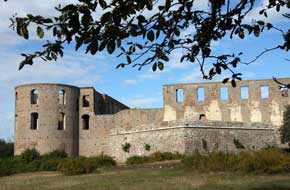 Borgholm Castle: the surviving ruins of Borgholm Slott (Castle)
were silhouetted on the cliff tops as we approached the southern end of the town
(see right). Construction of the original fortress was begun in the late 12th
century by King Knut Eriksson, and when Gustav Vasa secured Swedish independence
in 1523 he strengthened the huge castle to protect his new realm, and his sons
prettified it as a Renaissance palace. In the mid-17th century Tessin the Elder
further enlarged the royal palace, but by the 18th century the disused castle
fell into ruins, finally being destroyed by fire in 1806. Today the roofless
ruins still stand proudly atop the cliffs near to one of the Swedish royal
family's summer residences, and we walked around the stark towers and redoubts
among scrub-covered meadows (Photo 1 - The ruins of Borgholm Castle). Borgholm Castle: the surviving ruins of Borgholm Slott (Castle)
were silhouetted on the cliff tops as we approached the southern end of the town
(see right). Construction of the original fortress was begun in the late 12th
century by King Knut Eriksson, and when Gustav Vasa secured Swedish independence
in 1523 he strengthened the huge castle to protect his new realm, and his sons
prettified it as a Renaissance palace. In the mid-17th century Tessin the Elder
further enlarged the royal palace, but by the 18th century the disused castle
fell into ruins, finally being destroyed by fire in 1806. Today the roofless
ruins still stand proudly atop the cliffs near to one of the Swedish royal
family's summer residences, and we walked around the stark towers and redoubts
among scrub-covered meadows (Photo 1 - The ruins of Borgholm Castle).
 Wikegårds
Camping overlooking the Baltic shore-line: in
the northern outskirts of Borgholm we turned off to find the Bronze Age 3m high,
40m diameter burial mound of Blå Rör, tucked away in a sheep paddock, then
continued north on Route 136 passing some of Öland's distinctive exposed
limestone escarpments and the dry-stone walls criss-crossing the bare limestone
plateau landscape. Reaching the village of Högby, we turned off onto a
single-track lane leading across to the island's east coast to find tonight's
campsite, Wikegårds Camping. Set on a 19th century croft-farm with the camping
areas spread among the former pasture land, it was truly delightful place, but
with a tragic history so typical of the desperately hard life endured by Öland's
crofting families many of whom emigrated: the mother died early and the eldest
daughter brought up her younger siblings while father worked the farm. The 5
younger children eventually emigrated and Alma the eldest daughter
maintained the farm until she died in 1959, and the farm became a campsite in 1980. We were
welcomed by the elderly lady owner who, speaking in limited English suggested we
camp in the shelter of large juniper bushes from the brisk Öland wind, looking
out to the Baltic shoreline; it was a truly magnificent spot. Dusk was now
falling even earlier and by 8-30pm it was pitch dark; with the only lights being from an array of wind-farms out in the Baltic,
the night sky was studded with a multitude of stars and the Milky Way clearly
visible. Wikegårds
Camping overlooking the Baltic shore-line: in
the northern outskirts of Borgholm we turned off to find the Bronze Age 3m high,
40m diameter burial mound of Blå Rör, tucked away in a sheep paddock, then
continued north on Route 136 passing some of Öland's distinctive exposed
limestone escarpments and the dry-stone walls criss-crossing the bare limestone
plateau landscape. Reaching the village of Högby, we turned off onto a
single-track lane leading across to the island's east coast to find tonight's
campsite, Wikegårds Camping. Set on a 19th century croft-farm with the camping
areas spread among the former pasture land, it was truly delightful place, but
with a tragic history so typical of the desperately hard life endured by Öland's
crofting families many of whom emigrated: the mother died early and the eldest
daughter brought up her younger siblings while father worked the farm. The 5
younger children eventually emigrated and Alma the eldest daughter
maintained the farm until she died in 1959, and the farm became a campsite in 1980. We were
welcomed by the elderly lady owner who, speaking in limited English suggested we
camp in the shelter of large juniper bushes from the brisk Öland wind, looking
out to the Baltic shoreline; it was a truly magnificent spot. Dusk was now
falling even earlier and by 8-30pm it was pitch dark; with the only lights being from an array of wind-farms out in the Baltic,
the night sky was studded with a multitude of stars and the Milky Way clearly
visible.
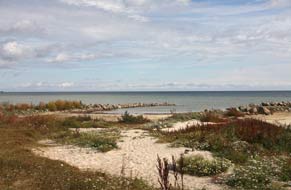 The
gloomy cloud and drizzle had blown itself out over night and with a clear sky
and bright sun we were able to sit out for breakfast looking out across the
pastures enclosed by dry-stone walls to the distant shimmering Baltic (see
above left). One of Öland's post-windmills stood by the farm gateway, and down at the
Baltic shoreline we could gaze out across the calm seascape and spectacular Baltic sky (see right). The
gloomy cloud and drizzle had blown itself out over night and with a clear sky
and bright sun we were able to sit out for breakfast looking out across the
pastures enclosed by dry-stone walls to the distant shimmering Baltic (see
above left). One of Öland's post-windmills stood by the farm gateway, and down at the
Baltic shoreline we could gaze out across the calm seascape and spectacular Baltic sky (see right).
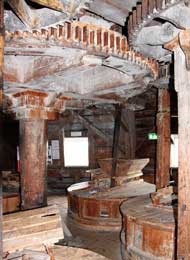 Öland's
windmills: our
exploration of the northern part of Öland began at Sandvik Kvarn (Mill), a
preserved Dutch windmill built originally in 1856 in Småland, transported
piecemeal and reassembled here in 1885 on a 2-storey sandstone base. It
remained in use as a working mill until 1950 when it was converted to a café.
Some 20 Dutch windmills still survive in Öland, with sails attached to a revolving
cap, unlike post-mills where the mill-cabin and sails are turned manually into
the wind on the post-pivot. The smaller post-mills would have served individual
farms, whereas the bigger Dutch mills would have been operated by a miller as a
toll mill with reimbursement made by farmers bringing their grain for grinding.
Today we decided to treat ourselves at the mill to a traditional Öland lunch of Kroppkakor, potato dumplings filled with chopped pork and onion, and
after lunch we clambered up the mill's rickety stairs to admire the intricacies
of
its wooden cog mechanism connecting the sails to the grinding wheels (see left). Öland's
windmills: our
exploration of the northern part of Öland began at Sandvik Kvarn (Mill), a
preserved Dutch windmill built originally in 1856 in Småland, transported
piecemeal and reassembled here in 1885 on a 2-storey sandstone base. It
remained in use as a working mill until 1950 when it was converted to a café.
Some 20 Dutch windmills still survive in Öland, with sails attached to a revolving
cap, unlike post-mills where the mill-cabin and sails are turned manually into
the wind on the post-pivot. The smaller post-mills would have served individual
farms, whereas the bigger Dutch mills would have been operated by a miller as a
toll mill with reimbursement made by farmers bringing their grain for grinding.
Today we decided to treat ourselves at the mill to a traditional Öland lunch of Kroppkakor, potato dumplings filled with chopped pork and onion, and
after lunch we clambered up the mill's rickety stairs to admire the intricacies
of
its wooden cog mechanism connecting the sails to the grinding wheels (see left).
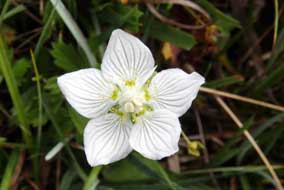 We
moved on to the nearby Knisa Mosse nature reserve, an area of coastal wetlands
once used for cutting reeds and hay but now conserved, where a 500m stretch of
path led from the parking area through an oak copse to a bird observation tower
overlooking the marshes. Crossing the board-walk we found a beautiful patch of
Grass of Parnassus flowers in the moist land (see right); we had seen this
magnificent flower from way up in the Arctic right down to here in the very
south of Scandinavia. Unfortunately there was little bird life to be seen on the
marshes other than a lone grey heron fishing among the reeds. We
moved on to the nearby Knisa Mosse nature reserve, an area of coastal wetlands
once used for cutting reeds and hay but now conserved, where a 500m stretch of
path led from the parking area through an oak copse to a bird observation tower
overlooking the marshes. Crossing the board-walk we found a beautiful patch of
Grass of Parnassus flowers in the moist land (see right); we had seen this
magnificent flower from way up in the Arctic right down to here in the very
south of Scandinavia. Unfortunately there was little bird life to be seen on the
marshes other than a lone grey heron fishing among the reeds.
Källa Gamla
Kyrka (Old Church): Öland is noted for its medieval fortified
churches and a little further south we turned off Route 136 to Föra
village. The first wooden church here, built in the 11th century soon after the
islanders' conversion to Christianity, was replaced by a sturdy stone
church which doubled as a fortress-refuge for the
 local population at times of
attack by raiders from across the Baltic. Further north at Källa, a single-track
lane led down to the harbour where the huge barn-like structure of Källa Gamla
Kyrka (Old Church) stood. This had been a place of worship from ancient times
close to a pagan sacred well near to the east coast port which had long been one of
the most important trading centres on Öland. With frequent attacks on the
harbour by Baltic pirates, the stone church was built in the 12th century to
double as a refuge with a further storey added later above the formerly
barrel-vaulted nave, with defensive windows to resist attackers. When the new Källa church was built in the modern village in the 19th century, the church
furnishings were transferred from the old local population at times of
attack by raiders from across the Baltic. Further north at Källa, a single-track
lane led down to the harbour where the huge barn-like structure of Källa Gamla
Kyrka (Old Church) stood. This had been a place of worship from ancient times
close to a pagan sacred well near to the east coast port which had long been one of
the most important trading centres on Öland. With frequent attacks on the
harbour by Baltic pirates, the stone church was built in the 12th century to
double as a refuge with a further storey added later above the formerly
barrel-vaulted nave, with defensive windows to resist attackers. When the new Källa church was built in the modern village in the 19th century, the church
furnishings were transferred from the old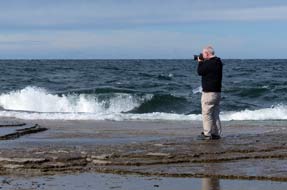 church which fell into disuse and was conserved as a state monument. The elderly
attendant showed us the church's features and told us of its history; without
doubt this was the most impressive of the island's fortress-churches standing so
starkly by the little harbour.
church which fell into disuse and was conserved as a state monument. The elderly
attendant showed us the church's features and told us of its history; without
doubt this was the most impressive of the island's fortress-churches standing so
starkly by the little harbour.
Neptuni Åkrar beach: after visiting another of the fortress-churches
at Högby further north and the fishing harbour of Böda Hamn, we
headed across through the pine forests which cover the island's north to find
tonight's campsite, Tokenäs Camping set by another post-windmill on the NW coast
(see above left). The following morning with a brisk wind blowing off the sea, we set
off to explore the island's northern tip. Just north of the small harbour of Byxelkrok from where summer ferries
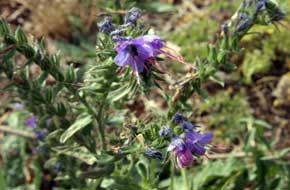 cross
to Oskarhamn on the mainland and to the Kalmar Sound islet of Blå Jungfrau, we
reached the wide rubble-field of Neptuni Åkrar, a barren beach of wave-pounded
rubble-banks above the flat slabs of bed-rock limestone along the waterline. The
flat upper surface of the slabs was scored with linear Orthoceratite
fossils, a marine cephalopod with external tubular shell. Labelled 'Neptune's
Fields' by Linné after his 1741 visit, the 200m wide rubble embankments above
the sea stretch for over 1km. Today the SW gale drove breakers crashing onto the
shoreline of limestone slabs with the bright sun lighting the pounding surf and
blue sea (see above right) (Photo
2 - Waves breaking onto Neptuni Åkrar beach). There was little plant life among the beach's barren rubble
but what did grow here in abundance were the blue-purple-pink flowers of the
spiky-leaved Viper's Bugloss (Photo 3 - Viper's Bugloss - Echium vulgare) and we were soon cross
to Oskarhamn on the mainland and to the Kalmar Sound islet of Blå Jungfrau, we
reached the wide rubble-field of Neptuni Åkrar, a barren beach of wave-pounded
rubble-banks above the flat slabs of bed-rock limestone along the waterline. The
flat upper surface of the slabs was scored with linear Orthoceratite
fossils, a marine cephalopod with external tubular shell. Labelled 'Neptune's
Fields' by Linné after his 1741 visit, the 200m wide rubble embankments above
the sea stretch for over 1km. Today the SW gale drove breakers crashing onto the
shoreline of limestone slabs with the bright sun lighting the pounding surf and
blue sea (see above right) (Photo
2 - Waves breaking onto Neptuni Åkrar beach). There was little plant life among the beach's barren rubble
but what did grow here in abundance were the blue-purple-pink flowers of the
spiky-leaved Viper's Bugloss (Photo 3 - Viper's Bugloss - Echium vulgare) and we were soon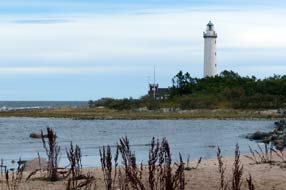 down on hands and knees photographing the curiously attractive flowers (see
left). Not a native of Öland, the seeds are thought to have originated in a
ship-load of gravel landed at Byxelkrok in 1934 which in the absence of
competition spread along the barren limestone rubble of the Neptuni Åkrar beach.
down on hands and knees photographing the curiously attractive flowers (see
left). Not a native of Öland, the seeds are thought to have originated in a
ship-load of gravel landed at Byxelkrok in 1934 which in the absence of
competition spread along the barren limestone rubble of the Neptuni Åkrar beach.
Öland's northern tip and Trollskogen nature
trail: northwards from here, we drove around a single-track
lane leading to the Långe Erik lighthouse which guards Öland's northern tip (see
right). The lane ended at Grankullaviken lagoon enclosed by the 2 arms which
form the island's northern point. Cows plodged in the shallow waters along the
shore-side meadow and cormorants perched out in the bay. A footbridge linked
across to one of a series of islets almost closing off the mouth of the bay
where the lighthouse rose above the trees. Around the far side of the bay, we
turned off to walk the 4.5km nature trail around the Trollskogen peninsula. The
way-marked path led across the peninsula's 0.5km
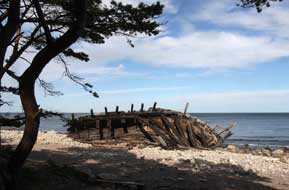 width
through forests of pine and venerable oaks out to the eastern coastline looking
across the Baltic. Sheltered from the brisk SW wind, the sea was peaceful and
lit by bright sunshine; with not a soul in sight, this was a truly beautiful
setting. The path continued northwards along the pine-fringed shingle beach,
reaching the wreck of the wooden schooner Swiks beached here in a storm
in 1926 while sailing from Wismar back to the Ålands, leaving the wreck to moulder
here ever since (see left). The ribbed carcass of the wooden boat stood on the
shingle like a beached whale. The path turned inland from the beach through pine
woods passing a gnarled oak said to be 100s year old and still thriving, and width
through forests of pine and venerable oaks out to the eastern coastline looking
across the Baltic. Sheltered from the brisk SW wind, the sea was peaceful and
lit by bright sunshine; with not a soul in sight, this was a truly beautiful
setting. The path continued northwards along the pine-fringed shingle beach,
reaching the wreck of the wooden schooner Swiks beached here in a storm
in 1926 while sailing from Wismar back to the Ålands, leaving the wreck to moulder
here ever since (see left). The ribbed carcass of the wooden boat stood on the
shingle like a beached whale. The path turned inland from the beach through pine
woods passing a gnarled oak said to be 100s year old and still thriving, and
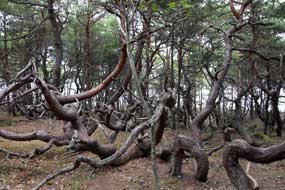 crossed
back towards the eastern shore with the increasingly loud sound of wind-driven
waves on this side; looking across the bay we could see the islets and
lighthouse where we had been earlier. Re-entering the forest, we passed pine
trees twisted into convoluted shapes by wild winds in this exposed area (see
right) (Photo 4 - Wind contorted pines at Trollskogen), and turned back through shore-side woodland meadows to complete the circuit of the
forest nature trail. crossed
back towards the eastern shore with the increasingly loud sound of wind-driven
waves on this side; looking across the bay we could see the islets and
lighthouse where we had been earlier. Re-entering the forest, we passed pine
trees twisted into convoluted shapes by wild winds in this exposed area (see
right) (Photo 4 - Wind contorted pines at Trollskogen), and turned back through shore-side woodland meadows to complete the circuit of the
forest nature trail.
Byrums Raukar sea stacks: to complete our day in the northern part of Öland, we drove back over to the eastern coast to find Byrums Raukar, a series
of sea stacks carved out of the soft coastal limestone bed-rock by wave and wind
action (see below left) (Photo 5 - Byrums Raukar sea stacks). Today the SW gale drove huge white breakers onto the
shore-line as we walked along the top of the continuous series of mini-stacks up
to 5m high eroded from the soft shale-like limestone cliffs
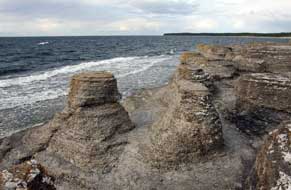 along
the 1 km long stretch of coast. Looking westwards, the low sun cast a long silvery
tail across the sea lighting the silhouetted grey limestone stacks. After our
fulsome day of exploration around northern Öland, we returned
for a second night at Tokenäs Camping and quickly settled in with the SW gale
now blowing up a chill driving drizzle and the windmill silhouetted against the
evening sky
(Photo 6 - Tokenäs Camping post-windmill at sunset). The
following morning we returned to the peacefulness of Wikegårds Camping for a day
in camp, sheltered from the wind behind the juniper bushes and looking out at
the spectacular cloud-scape over the Baltic. along
the 1 km long stretch of coast. Looking westwards, the low sun cast a long silvery
tail across the sea lighting the silhouetted grey limestone stacks. After our
fulsome day of exploration around northern Öland, we returned
for a second night at Tokenäs Camping and quickly settled in with the SW gale
now blowing up a chill driving drizzle and the windmill silhouetted against the
evening sky
(Photo 6 - Tokenäs Camping post-windmill at sunset). The
following morning we returned to the peacefulness of Wikegårds Camping for a day
in camp, sheltered from the wind behind the juniper bushes and looking out at
the spectacular cloud-scape over the Baltic.
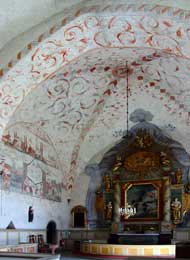 Southern Öland's
medieval fortress-churches: the following morning, after a pause along
the lane to photograph the post windmill,
we returned south through Borgholm to stock up with provisions at the ICA
supermarket, and turned off across the width of the island. The lane running
south down the east coast was a peaceful delight to drive, passing attractive
villages and farms. Our first stop was at the village of Gärdslösa to visit Öland's
best preserved medieval church with its sturdy former defensive tower and
stepped west-end gable. In bright morning sunlight we took our photos of this
beautiful church from under the trees in the carefully tended grave-yard
(Photo 7 - Öland's best preserved medieval church at Gärdslösa).
The interior was notable for its magnificent painted chancel arches (see right),
restored 17th century wall paintings and decorated pulpit carved in the 17th
century by Kalmar craftsmen. Thankfully the interior decoration had been spared
Baroque or 19th century over-elaboration, allowing the glorious simplicity of
medieval and 16~17th century artwork to speak for itself. In the west-end
porch several runic graffiti had been uncovered in the plasterwork, one
translating as 'Johann made me'. Gärdslösa was certainly a good start to today's
ecclesiastical and historical tour of southern Öland, Southern Öland's
medieval fortress-churches: the following morning, after a pause along
the lane to photograph the post windmill,
we returned south through Borgholm to stock up with provisions at the ICA
supermarket, and turned off across the width of the island. The lane running
south down the east coast was a peaceful delight to drive, passing attractive
villages and farms. Our first stop was at the village of Gärdslösa to visit Öland's
best preserved medieval church with its sturdy former defensive tower and
stepped west-end gable. In bright morning sunlight we took our photos of this
beautiful church from under the trees in the carefully tended grave-yard
(Photo 7 - Öland's best preserved medieval church at Gärdslösa).
The interior was notable for its magnificent painted chancel arches (see right),
restored 17th century wall paintings and decorated pulpit carved in the 17th
century by Kalmar craftsmen. Thankfully the interior decoration had been spared
Baroque or 19th century over-elaboration, allowing the glorious simplicity of
medieval and 16~17th century artwork to speak for itself. In the west-end
porch several runic graffiti had been uncovered in the plasterwork, one
translating as 'Johann made me'. Gärdslösa was certainly a good start to today's
ecclesiastical and historical tour of southern Öland,
 especially
on such a sunny morning. especially
on such a sunny morning.
Ismantorp Iron Age ring-fortress:
we turned inland past a series of preserved
post-windmills at Himmelsberga (Photo 8 - Öland post-windmill) and along a side-lane reached the remains of the early Iron Age
fortified ring-village (borg) of Ismantorp. A footpath led to an open space and
ahead were the crumbling limestone walls and one of the 9 gates of the fortified
village. Ismantorp is the oldest of a number of such fortifications on Öland,
built in the early centuries AD not as a permanent settlement but as a fortified
dwelling for a tribal chieftain and his garrison and place of security in times
of external threat for those farming the surrounding area. The external
ring-wall was solidly constructed of local limestone and well-preserved, in
places 3m high, enclosing a huge area with stone foundation remains of some
90 dwellings (see left). The place was abandoned around 650 AD, and little more
is known of its history. We entered the inner enclosed area through the gateway
and clambered up onto the walls, marvelling at the scale of the borg and state
of its preservation in the vast peacefulness of this wonderful historic setting.
(Photo 9 - Ismantorp Iron Age ring-fortress).
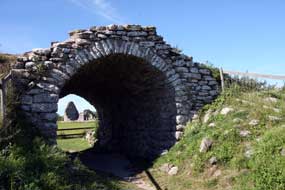 Gråborg
ring-fortress and medieval fortifications: 20kms
south we turned off again on one of the main cross-island roads to find Gråborg,
originally an even larger Iron Age ring fort built around 500 AD but later
adapted with strengthened walls as a medieval fortification. A small chapel
dedicated to St Knut was built nearby, and tax records show both the
fortress and chapel were owned by Vadstena Abbey and used as a trading centre
into the late medieval period; the fortress was used as late as 1677 in the wars
against the Danes. A path led past the ruins of St Knut's chapel and over to the
remains of the ring fort's surviving walls. A vaulted Gråborg
ring-fortress and medieval fortifications: 20kms
south we turned off again on one of the main cross-island roads to find Gråborg,
originally an even larger Iron Age ring fort built around 500 AD but later
adapted with strengthened walls as a medieval fortification. A small chapel
dedicated to St Knut was built nearby, and tax records show both the
fortress and chapel were owned by Vadstena Abbey and used as a trading centre
into the late medieval period; the fortress was used as late as 1677 in the wars
against the Danes. A path led past the ruins of St Knut's chapel and over to the
remains of the ring fort's surviving walls. A vaulted
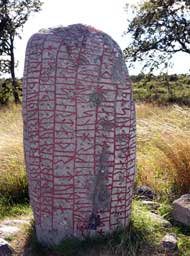 archway,
part of the medieval fortifications led through the massive limestone walls (see
right).
Nothing of the Iron Age fortified settlement or later medieval military works
survives today leaving just the vast open space enclosed by the circular walls.
We clambered up atop the gateway admiring the massively thick structure of the
walls over 4m high and carefully constructed to have survived so long. The
effort and manpower needed to garner and dress the stone and construct the
ring-fortification of this scale defied imagination. How often, we wondered, did
the Iron Age chieftain who controlled these territories need to summon his
peasant farming folk into the security of the walled enclosure in the face of
external threat?
(Photo 10 - Gråborg ring-fortress and medieval fortifications) archway,
part of the medieval fortifications led through the massive limestone walls (see
right).
Nothing of the Iron Age fortified settlement or later medieval military works
survives today leaving just the vast open space enclosed by the circular walls.
We clambered up atop the gateway admiring the massively thick structure of the
walls over 4m high and carefully constructed to have survived so long. The
effort and manpower needed to garner and dress the stone and construct the
ring-fortification of this scale defied imagination. How often, we wondered, did
the Iron Age chieftain who controlled these territories need to summon his
peasant farming folk into the security of the walled enclosure in the face of
external threat?
(Photo 10 - Gråborg ring-fortress and medieval fortifications)
The 10th century Karlevi Runestone: over on the SW side of the island just south of Färjestaden, we followed signs down a side-lane towards the shore of the Kalmar
Sound and located the Karlevi Runestone, a 1.4m high monument covered with
runic script. Dated to the late 10th century at the time of transition from
Norse paganism to Christianity, the Karlevi Runestone is unique in containing
both a prose dedication and a stanza of Viking period Skaldic verse, and on the
reverse side a later non-runic inscription with
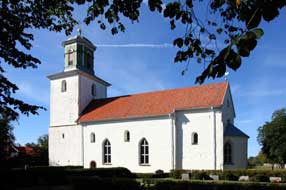 Christian
reference. The stone marks the grave of the Danish chieftain Sibbi Fuldarssson,
killed in battle around 985 AD, and was raised in dedication by his sons. The
prose dedication records the commemoration to Sibbi, and the honorific verse
which follows mentions a female Valkyrie deity Trud and reference to one of names
of Odin; clearly Sibbi still clung to the pagan Æsir beliefs. Christian
reference. The stone marks the grave of the Danish chieftain Sibbi Fuldarssson,
killed in battle around 985 AD, and was raised in dedication by his sons. The
prose dedication records the commemoration to Sibbi, and the honorific verse
which follows mentions a female Valkyrie deity Trud and reference to one of names
of Odin; clearly Sibbi still clung to the pagan Æsir beliefs.
Resmo and
Vickeby medieval churches: the next village south on Route 136 was
Vickeby where the church dated back to the mid-12th century. As with other
medieval Öland churches, the original foundation was strengthened with a sturdy
defensive tower as protection against raiders from across the Baltic (see right). Just down
the road Resmo church is one of Sweden's oldest surviving churches still in use.
It began as a private foundation in the 11th century, endowed by a local wealthy 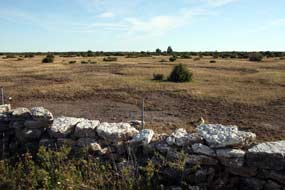 landowner who stood to gain from his investment in the church from fees paid by
parishioners for baptisms, weddings and funerals. Again the tower was
strengthened as a defensive refuge, but the Danish invasions of 1677 wrought
havoc with the decorations, treasures and archives of both Resmo and
Vickeby churches plundered or destroyed. landowner who stood to gain from his investment in the church from fees paid by
parishioners for baptisms, weddings and funerals. Again the tower was
strengthened as a defensive refuge, but the Danish invasions of 1677 wrought
havoc with the decorations, treasures and archives of both Resmo and
Vickeby churches plundered or destroyed.
Southern Öland's Stora Alvaret limestone
plateau: we turned off to cross the Stora Alvaret, the vast, barren
limestone plateau which covers the bulk of southern Öland; at 260km2
it is the largest such limestone expanse in Europe. The Alvar was formed by the
retreating glaciers scouring the limestone deposits, and after Öland's emergence
from the Baltic as the land rose at the end of the Ice Age, over the next
millennia the bare limestone was overlaid by a thin mantle of soil, only 2cms at
its thickest, by plant colonisation and wind-driven deposition. The term
alvar is derived from this thin soil covering and in some places the
limestone
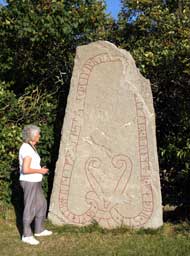 bed-rock
is still entirely bare. The first humans crossed to colonise Öland while there
was still a residual ice-bridge. During the Bronze and Iron Ages, farming
developed on the Alvar which was used to graze animals. During the 18~19th
centuries over-exploitation of the poor soil led to insufficient arable land to
feed the increasing population, and many emigrated to seek a new life overseas
leaving abandoned villages like Dröstorp. Today the barren plateau is
criss-crossed by dry-stone walls and still used for livestock grazing.
We crossed the width of the island over the barren Alvaret plain to the eastern
coast, pausing to look out across this curious landscape (see left). It needed
little to see how thin the top-soil layer was and in places the bare limestone
showed through. Dry-stone walls stretched away in all directions, the plain
covered in places with stunted scrub. bed-rock
is still entirely bare. The first humans crossed to colonise Öland while there
was still a residual ice-bridge. During the Bronze and Iron Ages, farming
developed on the Alvar which was used to graze animals. During the 18~19th
centuries over-exploitation of the poor soil led to insufficient arable land to
feed the increasing population, and many emigrated to seek a new life overseas
leaving abandoned villages like Dröstorp. Today the barren plateau is
criss-crossed by dry-stone walls and still used for livestock grazing.
We crossed the width of the island over the barren Alvaret plain to the eastern
coast, pausing to look out across this curious landscape (see left). It needed
little to see how thin the top-soil layer was and in places the bare limestone
showed through. Dry-stone walls stretched away in all directions, the plain
covered in places with stunted scrub.
 Seby
prehistoric grave-fields and a peaceful night's camp at Gräsgårds Fiskehamn:
we turned south on this lovely eastern coastal road and between the villages of
Segestad and Seby reached our final visit of this long day's explorations: the
prehistoric grave-fields which line the south-eastern ridge of Öland contain
some 300 standing stones and grave-mounds from the early centuries AD through to
the Viking period. The most prominent standing stones were at Seby where 2 large
monoliths marked a series of stone-settings (Photo 11 - Seby early Iron Age grave fields). A further km south a 3m high 11th
century runestone stood by the road side with the inscription Ingjald, Näf
and Sven erected this stone as a memorial to their father Rodmar (see right). Our
planned campsite for tonight at the Ottenby Vandrahem turned out to be a
cheerless and over-expensive place brim-full of statics, but fortunately we had
earlier noticed a straightforward little campsite close to Gräsgårds Fiskehamn
where working boats were moored in the picturesque little fishing harbour (Photo 12 - Gräsgårds Fiskehamn) and
cormorants perched on the rocks drying their outstretched wings.
We exchanged a few words in basic Swedish with one of the fishermen at the quay
who gladly agreed to us camping at this peaceful and charactersome place;
facilities were basic but at 110kr/night with power from a socket covered by a
fishing crate, what could be better; and we settled in to enjoy the last warmth
of the evening sun. It was another dark night with the Milky Way stretching
across a star-filled sky. Seby
prehistoric grave-fields and a peaceful night's camp at Gräsgårds Fiskehamn:
we turned south on this lovely eastern coastal road and between the villages of
Segestad and Seby reached our final visit of this long day's explorations: the
prehistoric grave-fields which line the south-eastern ridge of Öland contain
some 300 standing stones and grave-mounds from the early centuries AD through to
the Viking period. The most prominent standing stones were at Seby where 2 large
monoliths marked a series of stone-settings (Photo 11 - Seby early Iron Age grave fields). A further km south a 3m high 11th
century runestone stood by the road side with the inscription Ingjald, Näf
and Sven erected this stone as a memorial to their father Rodmar (see right). Our
planned campsite for tonight at the Ottenby Vandrahem turned out to be a
cheerless and over-expensive place brim-full of statics, but fortunately we had
earlier noticed a straightforward little campsite close to Gräsgårds Fiskehamn
where working boats were moored in the picturesque little fishing harbour (Photo 12 - Gräsgårds Fiskehamn) and
cormorants perched on the rocks drying their outstretched wings.
We exchanged a few words in basic Swedish with one of the fishermen at the quay
who gladly agreed to us camping at this peaceful and charactersome place;
facilities were basic but at 110kr/night with power from a socket covered by a
fishing crate, what could be better; and we settled in to enjoy the last warmth
of the evening sun. It was another dark night with the Milky Way stretching
across a star-filled sky.
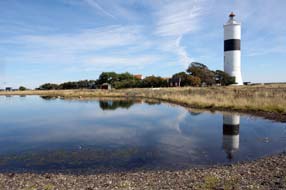 Långe
Jan lighthouse and Ottenby bird reserve at Öland's southernmost tip: a
gloriously pink dawn lit the eastern sky over the Baltic leading to a warm,
sunny morning, and we sat out for breakfast looking across to the little fishing
harbour, cheered by a peaceful night's camp in this charming sitting. We turned
off at Ottenby along a single-track lane leading across the treeless, bleak
sheep pastures of what had once been a royal hunting estate, to the Långe Jan
lighthouse and bird observation station at Öland's southernmost tip. Migrating
birds in their 1000s cross Öland on their incredible journeys and are trapped in
nets at the Ottenby observation station, Långe
Jan lighthouse and Ottenby bird reserve at Öland's southernmost tip: a
gloriously pink dawn lit the eastern sky over the Baltic leading to a warm,
sunny morning, and we sat out for breakfast looking across to the little fishing
harbour, cheered by a peaceful night's camp in this charming sitting. We turned
off at Ottenby along a single-track lane leading across the treeless, bleak
sheep pastures of what had once been a royal hunting estate, to the Långe Jan
lighthouse and bird observation station at Öland's southernmost tip. Migrating
birds in their 1000s cross Öland on their incredible journeys and are trapped in
nets at the Ottenby observation station,
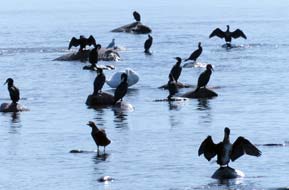 ringed
and sent on their way, and at the Naturum we learned more about bird migration
patterns. We walked out past the enormous base of the lighthouse to the
shore-line at the island's tip where the shallow waters of the immediate
foreshore were filled with birds (see left) (Photo 13 - Cormorants and Mute Swans off Ottenby): cormorants perched on rocks
comically splashing their wings; mute swans glided around serenely, remaining
indifferently aloof to the squawking gulls; a few mallard and grebes paddled
around busily. And further out a line of basking bulky, hump-backed Harbour
Seals made low, contented bellowing sounds to one another. and sleek Grey Seals
swam around in the shallows. We stood for an hour happily watching these
displays through our binoculars across the bay by the lighthouse (see right).
Further back from the Ottenby bird reserve at the lighthouse we walked over to
another early Iron Age burial ground marked by 2 huge monoliths, the
Kungsstenarna (King's Stones). The limestone standing stones and flat slabs were
covered with clearly visible Orthoceratite fossils (see below right). ringed
and sent on their way, and at the Naturum we learned more about bird migration
patterns. We walked out past the enormous base of the lighthouse to the
shore-line at the island's tip where the shallow waters of the immediate
foreshore were filled with birds (see left) (Photo 13 - Cormorants and Mute Swans off Ottenby): cormorants perched on rocks
comically splashing their wings; mute swans glided around serenely, remaining
indifferently aloof to the squawking gulls; a few mallard and grebes paddled
around busily. And further out a line of basking bulky, hump-backed Harbour
Seals made low, contented bellowing sounds to one another. and sleek Grey Seals
swam around in the shallows. We stood for an hour happily watching these
displays through our binoculars across the bay by the lighthouse (see right).
Further back from the Ottenby bird reserve at the lighthouse we walked over to
another early Iron Age burial ground marked by 2 huge monoliths, the
Kungsstenarna (King's Stones). The limestone standing stones and flat slabs were
covered with clearly visible Orthoceratite fossils (see below right).
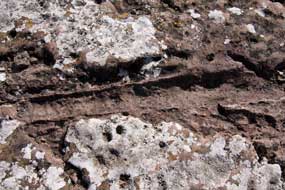 Gettlinge
prehistoric burial grounds and return to the mainland: we drove back
along the south-western side of the island overlooking the Kalmar Sound, and
some 15 kms north reached the village of Gettlinge. A low ridge, the residue of
a raised beach formed by post-glacial land uplift, ran north~south between the
coastal strip and western fringe of the Stora Alvaret limestone plateau, and
would have been the only place with soil layers thick enough for human burials
and creation of burial mounds. As a result, one of Öland's largest prehistoric
burial grounds extends for some 2 kms along this ridge covering the period from
1,000 BC to 1,000 AD, with Bronze Age burial mounds, Iron Age standing stones
and stone ship-settings Gettlinge
prehistoric burial grounds and return to the mainland: we drove back
along the south-western side of the island overlooking the Kalmar Sound, and
some 15 kms north reached the village of Gettlinge. A low ridge, the residue of
a raised beach formed by post-glacial land uplift, ran north~south between the
coastal strip and western fringe of the Stora Alvaret limestone plateau, and
would have been the only place with soil layers thick enough for human burials
and creation of burial mounds. As a result, one of Öland's largest prehistoric
burial grounds extends for some 2 kms along this ridge covering the period from
1,000 BC to 1,000 AD, with Bronze Age burial mounds, Iron Age standing stones
and stone ship-settings 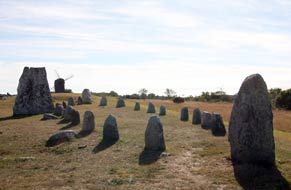 from
the Viking period. Just south of the modern village, we reached the most
prominent grave fields with the close cropped turf emphasising the standing
stones when lit by the low western sun. At the northern end the stone
outline of the Gettlinge ship-setting survived with the entrance to the grave
field marked by 2 large monoliths, making a perfect picture lit by the late
afternoon sun with a 19th century post-windmill and modern wind farm as
background (see left). It was time now to be leaving Öland after such a fruitful
5 days, and after topping up our provisions at the supermarket at Färjestaden,
we re-crossed the high 6km bridge with the western sun streaking across the
Sound and the silhouette of Kalmar Castle visible on the mainland shore. The
busy evening traffic as we entered the outskirts of Kalmar came as a culture
shock after Öland's rural solitude. Our satnav guided us through residential
areas of the city to reach Stensö Camping where a locked reception presented a
total non-welcome; this was a miserable campsite with impossibly sloping ground,
and while the outside world enjoyed bright evening sunshine, Stensö camping
areas were dank, gloomy and cheerless, under the heavy shade of pine and oak
trees. Their web site ironically boasted of facilities last upgraded in
1998 and it showed! limited, antiquated and grubby would be kindest
description. We should stay one night and move on after our visit to the
historic city of Kalmar tomorrow. from
the Viking period. Just south of the modern village, we reached the most
prominent grave fields with the close cropped turf emphasising the standing
stones when lit by the low western sun. At the northern end the stone
outline of the Gettlinge ship-setting survived with the entrance to the grave
field marked by 2 large monoliths, making a perfect picture lit by the late
afternoon sun with a 19th century post-windmill and modern wind farm as
background (see left). It was time now to be leaving Öland after such a fruitful
5 days, and after topping up our provisions at the supermarket at Färjestaden,
we re-crossed the high 6km bridge with the western sun streaking across the
Sound and the silhouette of Kalmar Castle visible on the mainland shore. The
busy evening traffic as we entered the outskirts of Kalmar came as a culture
shock after Öland's rural solitude. Our satnav guided us through residential
areas of the city to reach Stensö Camping where a locked reception presented a
total non-welcome; this was a miserable campsite with impossibly sloping ground,
and while the outside world enjoyed bright evening sunshine, Stensö camping
areas were dank, gloomy and cheerless, under the heavy shade of pine and oak
trees. Their web site ironically boasted of facilities last upgraded in
1998 and it showed! limited, antiquated and grubby would be kindest
description. We should stay one night and move on after our visit to the
historic city of Kalmar tomorrow.
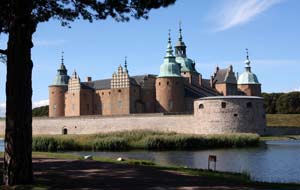 Kalmar's
historic castle and city: morning traffic was light as we drove into
Kalmar and found parking by the railway station It was a beautiful morning with
early autumn sunshine lighting the façade of the castle set on its small island
directly opposite. The original town of Kalmar developed in the shadow of the
castle which had been built in the 12th century and fully fortified by King Magnus Ladulås a century later to defend Sweden's SW coast. It was at Kalmar Castle in
1397 that Queen Margareta instigated the Union of Kalmar which merged the
thrones of Norway, Denmark and Sweden into one realm. But such was the antipathy
between Swedes and Danes that the Union was a fragile arrangement. Kalmar Castle
was in the front line of confrontation, and managed to remain unscathed despite being subjected to 11 sieges
as the 2 states rivalled for power. When Gustav Vasa secured Sweden's independence in 1523, he strengthened Kalmar Castle's
fortifications further to protect the new kingdom, while his degenerate sons
Erik and Johann chose the wall-paper to convert the Slott into a luxuriously
appointed Renaissance palace. The interior remains intact today as one of
Scandinavia's finest palaces of the period. The old town of Kalmar close to the
castle was destroyed by fire in the 1640s, and Kalmar was moved to the nearby
island of Kvarnholmen and rebuilt with Baroque precision by Tessin the Elder in
1660 as a model grid-plan with the domkyrka (cathedral) at its centre.
Being vulnerable to Danish attack during the Scanian Wars of the 1670s, the
town's island was surrounded by fortification walls. The modern city has
expanded inland but overall Kalmar remains small with a population of around
60,000. Kalmar's
historic castle and city: morning traffic was light as we drove into
Kalmar and found parking by the railway station It was a beautiful morning with
early autumn sunshine lighting the façade of the castle set on its small island
directly opposite. The original town of Kalmar developed in the shadow of the
castle which had been built in the 12th century and fully fortified by King Magnus Ladulås a century later to defend Sweden's SW coast. It was at Kalmar Castle in
1397 that Queen Margareta instigated the Union of Kalmar which merged the
thrones of Norway, Denmark and Sweden into one realm. But such was the antipathy
between Swedes and Danes that the Union was a fragile arrangement. Kalmar Castle
was in the front line of confrontation, and managed to remain unscathed despite being subjected to 11 sieges
as the 2 states rivalled for power. When Gustav Vasa secured Sweden's independence in 1523, he strengthened Kalmar Castle's
fortifications further to protect the new kingdom, while his degenerate sons
Erik and Johann chose the wall-paper to convert the Slott into a luxuriously
appointed Renaissance palace. The interior remains intact today as one of
Scandinavia's finest palaces of the period. The old town of Kalmar close to the
castle was destroyed by fire in the 1640s, and Kalmar was moved to the nearby
island of Kvarnholmen and rebuilt with Baroque precision by Tessin the Elder in
1660 as a model grid-plan with the domkyrka (cathedral) at its centre.
Being vulnerable to Danish attack during the Scanian Wars of the 1670s, the
town's island was surrounded by fortification walls. The modern city has
expanded inland but overall Kalmar remains small with a population of around
60,000.
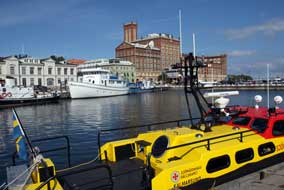 Kalmar Länsmusem exhibiting remains from the
17th century warship Kronan: we crossed to the delightful rose
gardens along the waters edge looking across at the elegant turreted outline of
Kalmar Slott from under the trees with the morning sunlight gleaming on the
fortifications (see above right). This was a delightfully memorable spot to sit
and eat our sandwich lunch gazing across the water to the castle where the Union
of Kalmar had been signed 600 years ago (Photo 14 - Lunch at Kalmar Castle). From here we ambled through the town
past the fortification walls and guest harbour; in the distance the Öland bridge
arched across the Sound as a freighter from Kalmar's commercial docks passed
beneath. Around at the Tullhamnen, the harbour-side was dominated by a 19th
century red brick former steam mill now refurbished as the Kalmar Länsmusem, our
next port of call. The museum's permanent displays exhibit remains recovered
from the 17th century Swedish warship Kronan sunk in a naval engagement
with a Danish fleet 6 kms off the SW coast of Öland in 1676. The wreck of
Kronan was located in 1980 by underwater archaeologist Anders Franzén, who
earlier had discovered the site of the Vasa. Investigation of the 26m
deep sea bed in the Baltic's clear waters immediately revealed a whole section
of the vessel's port side, and subsequent years of underwater archaeology has systematically produced more than 25,000 artefacts ranging from the ship's huge bronze cannons
down to human skeletal remains, Kronan's ornate wooden sculptures, a treasure trove of gold and silver coins,
personal effects, clothing, pewter plates and flasks. Exploration of the
wreck site still continues and there are aspirations one day to recover and restore
the wooden remains of the ship as with Vasa which we had seen in
Stockholm (see
log of our visit to the Vasa Museum). Kalmar Länsmusem exhibiting remains from the
17th century warship Kronan: we crossed to the delightful rose
gardens along the waters edge looking across at the elegant turreted outline of
Kalmar Slott from under the trees with the morning sunlight gleaming on the
fortifications (see above right). This was a delightfully memorable spot to sit
and eat our sandwich lunch gazing across the water to the castle where the Union
of Kalmar had been signed 600 years ago (Photo 14 - Lunch at Kalmar Castle). From here we ambled through the town
past the fortification walls and guest harbour; in the distance the Öland bridge
arched across the Sound as a freighter from Kalmar's commercial docks passed
beneath. Around at the Tullhamnen, the harbour-side was dominated by a 19th
century red brick former steam mill now refurbished as the Kalmar Länsmusem, our
next port of call. The museum's permanent displays exhibit remains recovered
from the 17th century Swedish warship Kronan sunk in a naval engagement
with a Danish fleet 6 kms off the SW coast of Öland in 1676. The wreck of
Kronan was located in 1980 by underwater archaeologist Anders Franzén, who
earlier had discovered the site of the Vasa. Investigation of the 26m
deep sea bed in the Baltic's clear waters immediately revealed a whole section
of the vessel's port side, and subsequent years of underwater archaeology has systematically produced more than 25,000 artefacts ranging from the ship's huge bronze cannons
down to human skeletal remains, Kronan's ornate wooden sculptures, a treasure trove of gold and silver coins,
personal effects, clothing, pewter plates and flasks. Exploration of the
wreck site still continues and there are aspirations one day to recover and restore
the wooden remains of the ship as with Vasa which we had seen in
Stockholm (see
log of our visit to the Vasa Museum).
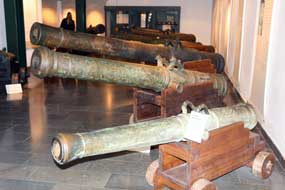 Sinking
of the warship Kronan in 1676: Kronan had been built in
Stockholm's Skeppsholmen navy yard in 1665~68, designed by an English ship-wright
Francis Sheldon, and unlike the bulky rounded keeled Vasa, Kronan had a
deeper draft, V-shaped hull and less lofty stern. At that time she was the
largest and most heavily armed warship afloat, twice the size of the Vasa
with an armament of 126 cannons (compared with Vasa's 64) over 3 decks,
and a crew of 550 officers and men and marine complement of 300 soldiers.
Kronan was commanded by Admiral of the Fleet Lorenz Creutz, personally
appointed by the young Swedish King Karl XI. Creutz was a wealthy and
well-placed aristocrat, an administrator with just one week's naval experience!
The Swedish navy had already suffered catastrophic losses in the early stages of
the Scanian War due to poorly maintained warships, ill-trained crews, Sinking
of the warship Kronan in 1676: Kronan had been built in
Stockholm's Skeppsholmen navy yard in 1665~68, designed by an English ship-wright
Francis Sheldon, and unlike the bulky rounded keeled Vasa, Kronan had a
deeper draft, V-shaped hull and less lofty stern. At that time she was the
largest and most heavily armed warship afloat, twice the size of the Vasa
with an armament of 126 cannons (compared with Vasa's 64) over 3 decks,
and a crew of 550 officers and men and marine complement of 300 soldiers.
Kronan was commanded by Admiral of the Fleet Lorenz Creutz, personally
appointed by the young Swedish King Karl XI. Creutz was a wealthy and
well-placed aristocrat, an administrator with just one week's naval experience!
The Swedish navy had already suffered catastrophic losses in the early stages of
the Scanian War due to poorly maintained warships, ill-trained crews,
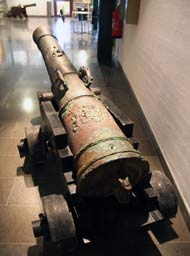 incompetent
seamanship and poor discipline by its aristocratic officers who had little naval
experience. Creutz set sail from Stockholm early in 1676 with 60 heavily armed
men-of-war, and orders from the king to find and destroy the Danish fleet which
some weeks before had landed a force on Gotland. Leading the fleet aboard his
flagship Kronan, Creutz was already in contention with his other
commanders who led the accompanying squadrons. In late May Kronan showed
her overwhelming firepower in a successful action against the Danes, but the
battle also revealed weaknesses of discipline with fellow commanders showing
disregard for their commander-in-chief's authority, near-mutinous discord, and
evident lack of confidence in his competence to lead the fleet. By 31 May the
Swedish fleet was off the SW coast of Öland trailed by the Danish fleet, with a
gusty gale blowing which scattered the vessels. This time, discord and rivalry
among the commanders led to disaster: on the morning of 1 June while Kronan
attempted to avoid action in the blustery conditions, Admiral Uggla ordered his
ship to alter course to face the Danes; Creutz tried to countermand the order
but was obliged to follow suit. There was discord among Kronan's officers
about increasing or decreasing sail as Kronan tacked in the blustery
wind. It was clear that the Vasa disaster of 40 years earlier was still a
vivid memory since Creutz did at least order all the cannon ports closed to
avoid shipping water as she turned. But in the swell the crew could not withdraw
Kronan's cannons; a gust of wind caused her to heave over and she began
shipping water through the still open cannon ports. A lantern ignited the
gunpowder magazine and a mighty explosion ripped Kronan apart. She sank
with the loss of 800 lives including Creutz. Kronan's design was
tried and incompetent
seamanship and poor discipline by its aristocratic officers who had little naval
experience. Creutz set sail from Stockholm early in 1676 with 60 heavily armed
men-of-war, and orders from the king to find and destroy the Danish fleet which
some weeks before had landed a force on Gotland. Leading the fleet aboard his
flagship Kronan, Creutz was already in contention with his other
commanders who led the accompanying squadrons. In late May Kronan showed
her overwhelming firepower in a successful action against the Danes, but the
battle also revealed weaknesses of discipline with fellow commanders showing
disregard for their commander-in-chief's authority, near-mutinous discord, and
evident lack of confidence in his competence to lead the fleet. By 31 May the
Swedish fleet was off the SW coast of Öland trailed by the Danish fleet, with a
gusty gale blowing which scattered the vessels. This time, discord and rivalry
among the commanders led to disaster: on the morning of 1 June while Kronan
attempted to avoid action in the blustery conditions, Admiral Uggla ordered his
ship to alter course to face the Danes; Creutz tried to countermand the order
but was obliged to follow suit. There was discord among Kronan's officers
about increasing or decreasing sail as Kronan tacked in the blustery
wind. It was clear that the Vasa disaster of 40 years earlier was still a
vivid memory since Creutz did at least order all the cannon ports closed to
avoid shipping water as she turned. But in the swell the crew could not withdraw
Kronan's cannons; a gust of wind caused her to heave over and she began
shipping water through the still open cannon ports. A lantern ignited the
gunpowder magazine and a mighty explosion ripped Kronan apart. She sank
with the loss of 800 lives including Creutz. Kronan's design was
tried and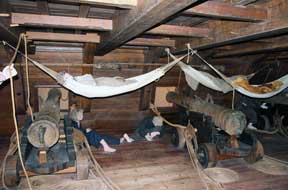 tested and the ship was far more stable than Vasa had ever been. But
again the human factor of incompetent leadership and discord and poor
decision-taking among the officers was a major factor in a second disastrous
loss of a major vessel of the Swedish navy with all her costly armaments in 40
years.
tested and the ship was far more stable than Vasa had ever been. But
again the human factor of incompetent leadership and discord and poor
decision-taking among the officers was a major factor in a second disastrous
loss of a major vessel of the Swedish navy with all her costly armaments in 40
years.
Our visit to the Kronan Museum:
the Kalmar Länsmusem's ground floor displayed some of the Kronan's bronze
cannons recovered from the wreck site, enormous guns the heaviest weighing over
5 tons with a range of up to 2kms ( see above right and left). The main
exhibition opened with a cleverly conceived diorama of the wreck site with
English language explanatory commentary, followed by video
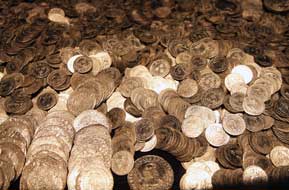 describing
the naval action and Kronan's dramatic sinking, the wreck's discovery and
underwater archaeology to recover materials from the wreck site. The subsequent
series of displays, all well-presented with multi-lingual texts, gave fulsome
explanation of Kronan's scale and armaments, and moving human detail
about the crew and life in 17th century Sweden from osteology studies of
skeletal remains recovered from the wreck. Alongside displays of artefacts such
as personal effects, table-ware and clothing, a reconstruction of the gun-deck
showed conditions on board a 17th century warship (see right); perhaps most
impressive was the treasure trove of gold and silver coins recovered from the
wreck site with ducats and tholars from around Europe and even the middle east
(see left); much of the treasure is believed to have been amassed by Creutz
himself though why he risked his fortune in the vagaries of a naval battle was
not explained. The final film outlined the vision of a future raising of
Kronan's wooden remains, their conservation and display in a purpose-built
museum just like Vasa. All in all, the Kalmar Länsmusem's displays on
Kronan were truly admirable, and although as yet having no actual ship
remains as its centrepiece, the museum certainly ranked with Stockholm's Vasa
Museum, with all the recovered artefacts giving such a memorable insight into
life in Sweden's 17th century great power period. describing
the naval action and Kronan's dramatic sinking, the wreck's discovery and
underwater archaeology to recover materials from the wreck site. The subsequent
series of displays, all well-presented with multi-lingual texts, gave fulsome
explanation of Kronan's scale and armaments, and moving human detail
about the crew and life in 17th century Sweden from osteology studies of
skeletal remains recovered from the wreck. Alongside displays of artefacts such
as personal effects, table-ware and clothing, a reconstruction of the gun-deck
showed conditions on board a 17th century warship (see right); perhaps most
impressive was the treasure trove of gold and silver coins recovered from the
wreck site with ducats and tholars from around Europe and even the middle east
(see left); much of the treasure is believed to have been amassed by Creutz
himself though why he risked his fortune in the vagaries of a naval battle was
not explained. The final film outlined the vision of a future raising of
Kronan's wooden remains, their conservation and display in a purpose-built
museum just like Vasa. All in all, the Kalmar Länsmusem's displays on
Kronan were truly admirable, and although as yet having no actual ship
remains as its centrepiece, the museum certainly ranked with Stockholm's Vasa
Museum, with all the recovered artefacts giving such a memorable insight into
life in Sweden's 17th century great power period.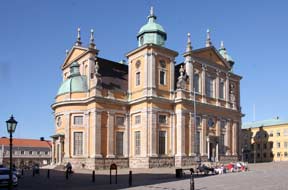
Kalmar Baroque Cathedral and medieval Castle:
in the warm afternoon sunshine, we walked Kalmar's grid of streets into the vast
open space of the cobbled Stortorget where suddenly the enormous Baroque ochre
splendour of the Domkyrka appeared before us, looking more like a bauble-decked
17th century palace than a cathedral (see right) (Photo 15 - Kalmar's Baroque Cathedral). Tessin modelled his design for the new
city's cathedral on Baroque churches he had seen in Rome. On the opposite corner
of the square, the Rådhus, also designed by Tessin, paled into insignificance in comparison with the Domkyrka though in its way
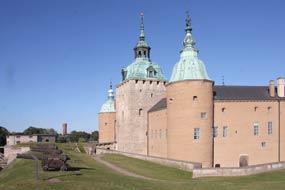 no less
splendid. Inside, the cathedral was indeed a palace of Baroque extravaganza with
an enormous and unsightly (no other word is apt) altar piece backed by a
painting showing the Deposition graphically detailing the dead Christ being
hauled by ropes down from the cross by men on ladders. Equally obscene was the
over-ornate pulpit topped by a triple-decker confection of gnome-like sleeping
soldiers overlooking a gilded figure of Christ. In contrast with all the Baroque
exuberance, the walls were painted in refrained plain cream and covered with
huge coats of arms of aristocratic families. Before leaving Kalmar, we walked
down to the Castle and across the reconstructed drawbridge where Gustav Vasa's
bold coat of arms in limestone relief decorated the panel over the gateway. The
view from the high outer ramparts gave an full impression of the scale of Vasa's
fortifications, and a line of cannons stood in readiness to repel renewed Danish
attacks (see left). no less
splendid. Inside, the cathedral was indeed a palace of Baroque extravaganza with
an enormous and unsightly (no other word is apt) altar piece backed by a
painting showing the Deposition graphically detailing the dead Christ being
hauled by ropes down from the cross by men on ladders. Equally obscene was the
over-ornate pulpit topped by a triple-decker confection of gnome-like sleeping
soldiers overlooking a gilded figure of Christ. In contrast with all the Baroque
exuberance, the walls were painted in refrained plain cream and covered with
huge coats of arms of aristocratic families. Before leaving Kalmar, we walked
down to the Castle and across the reconstructed drawbridge where Gustav Vasa's
bold coat of arms in limestone relief decorated the panel over the gateway. The
view from the high outer ramparts gave an full impression of the scale of Vasa's
fortifications, and a line of cannons stood in readiness to repel renewed Danish
attacks (see left).
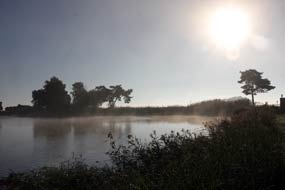 A
delightful welcome at Dalskärs Camping: it was now time to leave the
delightful town of Kalmar after our memorable visit and set off on the E22
motorway down the Småland coast heading for Dalskärs Camping which we had found
in the Swedish Camping Association listing; the owner had responded helpfully to
our telephone enquiry and stayed open to welcome us personally with our late
arrival. The camping areas were spread around reed-fringed lagoons by the
guest-harbour and weary after a long day, we settled into a delightful spot lit
by warm evening sunshine by the water's edge; the blessed St Serendipity had
come to our aid yet again in finding us such a welcoming, well-appointed and
wonderfully placed campsite, a perfect spot for tomorrow's day in camp. After a
chill night, the sun rose mistily across the water in a perfectly clear sky
(Photo 16 - Early morning mist at Dalskärs Camping); it
was a beautiful autumn morning for breakfast outside beside our reed-fringed
lagoon (see right). In such a memorably beautiful setting in perfect weather, we
enjoyed a restful and productive day in camp
(Photo 17 - Reed-fringed lagoons at Dalskärs Camping): a final load of laundry was washed
using Dalskärs' high standard facilities, we completed more writing and read up
on the next phase of our travels through Skåne, enjoyed the campsite's home made
bread, and watched a neighbouring grey heron soaring around and fishing in the
reed-beds
(Photo 18 - Grey Heron in lagoon reeds at Dalskärs Camping); and to conclude such a splendid day's camping, we cooked supper of
Swedish köttbular (meatballs) in a creamy lingonberry sauce as the evening grew
autumnally chill and misty. A
delightful welcome at Dalskärs Camping: it was now time to leave the
delightful town of Kalmar after our memorable visit and set off on the E22
motorway down the Småland coast heading for Dalskärs Camping which we had found
in the Swedish Camping Association listing; the owner had responded helpfully to
our telephone enquiry and stayed open to welcome us personally with our late
arrival. The camping areas were spread around reed-fringed lagoons by the
guest-harbour and weary after a long day, we settled into a delightful spot lit
by warm evening sunshine by the water's edge; the blessed St Serendipity had
come to our aid yet again in finding us such a welcoming, well-appointed and
wonderfully placed campsite, a perfect spot for tomorrow's day in camp. After a
chill night, the sun rose mistily across the water in a perfectly clear sky
(Photo 16 - Early morning mist at Dalskärs Camping); it
was a beautiful autumn morning for breakfast outside beside our reed-fringed
lagoon (see right). In such a memorably beautiful setting in perfect weather, we
enjoyed a restful and productive day in camp
(Photo 17 - Reed-fringed lagoons at Dalskärs Camping): a final load of laundry was washed
using Dalskärs' high standard facilities, we completed more writing and read up
on the next phase of our travels through Skåne, enjoyed the campsite's home made
bread, and watched a neighbouring grey heron soaring around and fishing in the
reed-beds
(Photo 18 - Grey Heron in lagoon reeds at Dalskärs Camping); and to conclude such a splendid day's camping, we cooked supper of
Swedish köttbular (meatballs) in a creamy lingonberry sauce as the evening grew
autumnally chill and misty.
Karlskrona naval port: it's always an
indication of a good campsite when you are sorry to be leaving, and the next day
we did indeed regret having to leave Dalskärs Camping. After a pause at Blomlöfs
Rökeri (fish smoke-house) at Brömsebro village for their renowned smoked salmon
fillets, we continued on to Karlskrona. After the military disasters of the
1675~79 Scanian Wars and loss of the Kronan resulting in the Danish near re-occupation of Skåne, it was clear that an ice-free naval base was needed in
Southern Sweden if the continued Danish threat was to be resisted and Swedish control of the Baltic maintained. In 1789 therefore, King Karl XI selected the
island of Trossö as the site of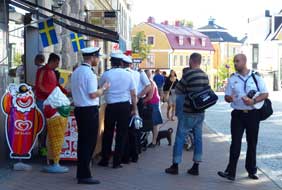 the new naval port of Karlskrona, protected from the new naval port of Karlskrona, protected from
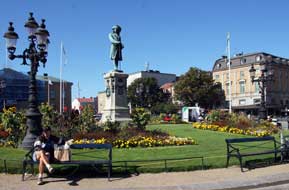 attack by an archipelago of encircling off-shore islands. Tessin the Younger,
along with military engineers laid out the dockyards, harbour, fortifications
and civilian town, all modelled on Baroque design principles; within 30 years
the city with its fortified naval base, shipyards and civilian town were fully
developed under the direction of Admiral-General Count Hans Wachtmeister as
master-engineer. Very much the Pompey of Sweden, Karlskrona remains today
Sweden's foremost naval base with significant parts of Trossö and the outer
islands off-limits as a military zone, and uniformed Naval personnel seen about
the city streets (see right) (Photo 19 - Sailors Ahoy! at Karlskrona naval port). attack by an archipelago of encircling off-shore islands. Tessin the Younger,
along with military engineers laid out the dockyards, harbour, fortifications
and civilian town, all modelled on Baroque design principles; within 30 years
the city with its fortified naval base, shipyards and civilian town were fully
developed under the direction of Admiral-General Count Hans Wachtmeister as
master-engineer. Very much the Pompey of Sweden, Karlskrona remains today
Sweden's foremost naval base with significant parts of Trossö and the outer
islands off-limits as a military zone, and uniformed Naval personnel seen about
the city streets (see right) (Photo 19 - Sailors Ahoy! at Karlskrona naval port).
Our visit to Karlskrona: our stanav
guided us over the now almost unnoticeable causeway linking across onto what
was at the city's foundation Trossö Island, and we parked near the centre to walk
through to the vast open space of Stortorget. At the eastern end of the city
square, we entered Fredriks kyrkan, the church designed in 1697 by Tessin the
Younger in Italianate style with vast Baroque proportions and imposing towers.
Shortage of funds delayed building and the church was not consecrated until
1744. In the 1790 fire which devastated Karlskrona, much of the church's upper
parts were destroyed and rebuilding took until 1806 when the church was named
after the then reigning Fredrik I. The interior was light and airy with an
ornate Baroque pulpit, dark ungainly altar array, grandiose organ and acres of
box-pews. The main west door led out onto the church steps which overlooked the
grand open space of Storporget. On the far side, the domed circular Baroque Trefaldighets kyrkan (Holy Trinity Church), designed by Tessin for the town's
German citizens, was modelled on the Pantheon, but unfortunately locked today. In
the square's centre a bronze statue of Karl XI, Karlskrona's founder, stood
surrounded by market stalls where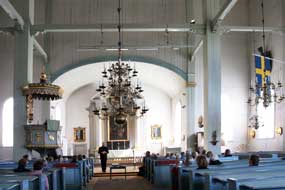 we sat for our sandwiches
(see above left) (Photo 20 - Karlskrona market square). A re we sat for our sandwiches
(see above left) (Photo 20 - Karlskrona market square). A re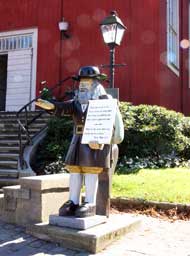 markably
restrained anti-NATO demonstration was being held at the far end of the square
in front of the Rådhus. Down through the gardens of Amiralitets-torget past the
apricot-coloured bell-tower built in 1699 as a clock for civilian dockyard
workers, we reached the main Guardhouse at the entrance to the protected
military zone of the naval base beyond. Razor-wire topped walls and armed
sentries formed an impregnable barrier to further intrusion into the dockyard.
Down past official-looking naval buildings in Vallgatan, a side lane ended at
the four-square wooden church of Amiralitets-kyrkan Ulrica Pia; built in 1685
for the newly established naval base and named after Karl XI's queen-consort
Ulrica Eleonora, the cruciform-shaped church seats a congregation of 4,000 (see
right). Outside by the church steps, the wooden statue of Old Rosenbom stood
waiting to attract tourists' coins for his poor-box (see left): the original
Mats Rosenbom was a shipyard worker who fell on hard times when fever killed his
6 children and left him and his wife too ill to work; reduced to beggary, and
drunk on New Year Eve 1717, he offended a wealthy ship's figurehead carver by
failing to raise his hat in thanks for a few öre; struck over the head, he froze
to death in overnight snow on the church steps. Next morning the wood carver
found his body and in remorse carved the statute of Rosenbom which now stands
where he died. It's a good yarn to entertain the tourists who have to raise his
hat to drop money in his box. markably
restrained anti-NATO demonstration was being held at the far end of the square
in front of the Rådhus. Down through the gardens of Amiralitets-torget past the
apricot-coloured bell-tower built in 1699 as a clock for civilian dockyard
workers, we reached the main Guardhouse at the entrance to the protected
military zone of the naval base beyond. Razor-wire topped walls and armed
sentries formed an impregnable barrier to further intrusion into the dockyard.
Down past official-looking naval buildings in Vallgatan, a side lane ended at
the four-square wooden church of Amiralitets-kyrkan Ulrica Pia; built in 1685
for the newly established naval base and named after Karl XI's queen-consort
Ulrica Eleonora, the cruciform-shaped church seats a congregation of 4,000 (see
right). Outside by the church steps, the wooden statue of Old Rosenbom stood
waiting to attract tourists' coins for his poor-box (see left): the original
Mats Rosenbom was a shipyard worker who fell on hard times when fever killed his
6 children and left him and his wife too ill to work; reduced to beggary, and
drunk on New Year Eve 1717, he offended a wealthy ship's figurehead carver by
failing to raise his hat in thanks for a few öre; struck over the head, he froze
to death in overnight snow on the church steps. Next morning the wood carver
found his body and in remorse carved the statute of Rosenbom which now stands
where he died. It's a good yarn to entertain the tourists who have to raise his
hat to drop money in his box.
We continued down to the Aurora Bastion, part of
the early 18th century fortifications, and peered through the security gates at
Kungsbron where royal visitors to the dockyard are piped ashore. Around the
waterfront we reached the bridge over to the island of Stumholmen which was used
by the Swedish Navy and Naval Air Squadron until 1980. Karlskrona Maritime
Museum is now housed in one of the former dockyard buildings, but rather than pay
to view a collection of figureheads and models, we walked around the quays past
the moored ships. Back on the main island, we continued around the waterfront
to investigate current naval vessels open to public view this weekend as part of
a NATO exercise taking place at Karlskrona; this was the reason for the demo up
in city square. One of the ships was a curiously angular Swedish Navy corvette,
shaped like Stealth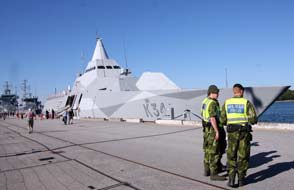 aircraft to avoid radar detection; one of the crew gave us the low down on the
ship which we photographed along with Swedish military police who were too busy
snapping one another to give regard to their duties of guarding the ship (see
right).
aircraft to avoid radar detection; one of the crew gave us the low down on the
ship which we photographed along with Swedish military police who were too busy
snapping one another to give regard to their duties of guarding the ship (see
right).
Up over the crown of Trossö past Stortorget, we
ambled down to Fisketorget on the western side of the island where, since the
only fish to be seen today were those in the basket of the fishwife's statue, we
stopped
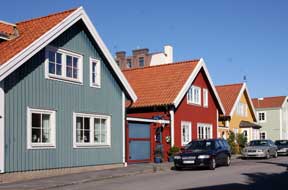 for
an ice cream. After a quick visit to the rocky islet of Stakholmen, a sunbathing
spot for local youngsters, we crossed to Björkholmen, once an impoverished area
of wooden houses for civilian dockyard workers and now yuppified as twee,
roses-round-the-door properties for BMW owners. Quite entertainingly incongruous
however was the sight at the far end of this des-res area where we came face to
face with the 6m high formidable obstacle of the Dockyard Wall (capital D,
capital W); it was like positioning a group of up-market homes in the shadow of
Wormwood Scrubs high security nick! Built in the 18~19th century to divide the
naval base from the civilian town and keep prying eyes from the naval security
zone, the Dockyard Wall still forms an impenetrable barrier. We followed
the wall around, at one point peering curiously through a security gate at the
mysteries beyond. Returning to the town, the market stalls at Stortorget and
anti-NATO demo had all packed up and gone home, replaced by a Turkish burger
bar, immigrant mums with their buggies, and young matelots chatting up the local
totties; Karl XI's statue looked down contemptuously across his Baroque
elegance, and we returned to the camper to find tonight's campsite. for
an ice cream. After a quick visit to the rocky islet of Stakholmen, a sunbathing
spot for local youngsters, we crossed to Björkholmen, once an impoverished area
of wooden houses for civilian dockyard workers and now yuppified as twee,
roses-round-the-door properties for BMW owners. Quite entertainingly incongruous
however was the sight at the far end of this des-res area where we came face to
face with the 6m high formidable obstacle of the Dockyard Wall (capital D,
capital W); it was like positioning a group of up-market homes in the shadow of
Wormwood Scrubs high security nick! Built in the 18~19th century to divide the
naval base from the civilian town and keep prying eyes from the naval security
zone, the Dockyard Wall still forms an impenetrable barrier. We followed
the wall around, at one point peering curiously through a security gate at the
mysteries beyond. Returning to the town, the market stalls at Stortorget and
anti-NATO demo had all packed up and gone home, replaced by a Turkish burger
bar, immigrant mums with their buggies, and young matelots chatting up the local
totties; Karl XI's statue looked down contemptuously across his Baroque
elegance, and we returned to the camper to find tonight's campsite.
Our plan had been to stay at the local campsite
set on Dragsö Island on the western side of the archipelago, but having crossed
the bridges linking the islands, we were faced with the horrendous spectacle of
caravans crammed in like sardines and a seething mass of screaming
holiday-makers; and despite the over-crowding, most of the service buildings
were closed, it now supposedly being out-of-season; this was a total No-No even
for one night! A quick consultation of the Swedish Camping Association listing
identified several other sites along the coast, but on a sunny weekend these
were all likely to be as bad. One inland campsite stood out, and a phone call
produced a welcoming response; although the last thing we needed was a further
hour's drive after a wearying day, we set off along the motorway into the low
western sun, eventually reaching Långgasjönäs Camping deep in the Blekinge Län
countryside. With dusk coming on we thankfully settled in.
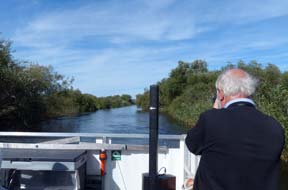 Kristianstad and a boat-trip
in the Vattenriket
wetlands: our plan had been for a leisurely drive this morning to
Kristianstad to book a bird-watching boat-trip on the Vattenriket wetlands for
tomorrow. But on telephoning to enquire, we learnt that the only available
tour along the Helge å river was this afternoon; suddenly a relaxed day hotted
up as we hurried down the motorway to reach Kristianstad in time for today's
boat trip. We arrived with 10 minutes to spare to find the boat landing stage.
The Helge å is Skåne's longest river which rises in S Kristianstad and a boat-trip
in the Vattenriket
wetlands: our plan had been for a leisurely drive this morning to
Kristianstad to book a bird-watching boat-trip on the Vattenriket wetlands for
tomorrow. But on telephoning to enquire, we learnt that the only available
tour along the Helge å river was this afternoon; suddenly a relaxed day hotted
up as we hurried down the motorway to reach Kristianstad in time for today's
boat trip. We arrived with 10 minutes to spare to find the boat landing stage.
The Helge å is Skåne's longest river which rises in S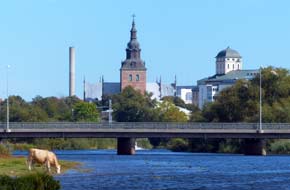 måland
and flows for 190kms through the flat lowlands and lakes around Kristianstad
to the coast at Hanöbuken Bay; the natural outlet of the river is at Åhus, but
in 1775 an artificial channel was cut to drain the lower marshes. The shallow
river is usually just 1m above sea level but in high Spring tides can rise to
over 2m, and gales from the SE can blow salty water and sea fish up into the
river. The Vattenriket wetlands and marshes of the Helge å river now form a UNESCO World Heritage Site, renowned for its rich
vegetation and extensive bird life. The sun was bright with brisk SE gale
blowing as the boat set off down-river to approach the reed-lined river's entry
into the Hammarsjön lake. With the wind whipping up a swell, there was little
bird-life to be seen, and the boatman began a lengthy social history of the
flatlands largely in Swedish. The boat returned up-stream passing flat lowland
riverside meadows and although we were able to see some birds of prey (kestrels,
ospreys, marsh harrier), it was an expensive and disappointing outing (Photo 21 - Kristianstad from Helge å river). By the
time we got back to the mooring, rain was beginning and we drove out to find
tonight's campsite Charlottsborgs Vandrahem and Camping 3 kms west of the town.
Out of season the hostel's warden was only present in the morning, but the
campsite was open and we settled in one of the lawned parkland pitches sheltered
by hedges. måland
and flows for 190kms through the flat lowlands and lakes around Kristianstad
to the coast at Hanöbuken Bay; the natural outlet of the river is at Åhus, but
in 1775 an artificial channel was cut to drain the lower marshes. The shallow
river is usually just 1m above sea level but in high Spring tides can rise to
over 2m, and gales from the SE can blow salty water and sea fish up into the
river. The Vattenriket wetlands and marshes of the Helge å river now form a UNESCO World Heritage Site, renowned for its rich
vegetation and extensive bird life. The sun was bright with brisk SE gale
blowing as the boat set off down-river to approach the reed-lined river's entry
into the Hammarsjön lake. With the wind whipping up a swell, there was little
bird-life to be seen, and the boatman began a lengthy social history of the
flatlands largely in Swedish. The boat returned up-stream passing flat lowland
riverside meadows and although we were able to see some birds of prey (kestrels,
ospreys, marsh harrier), it was an expensive and disappointing outing (Photo 21 - Kristianstad from Helge å river). By the
time we got back to the mooring, rain was beginning and we drove out to find
tonight's campsite Charlottsborgs Vandrahem and Camping 3 kms west of the town.
Out of season the hostel's warden was only present in the morning, but the
campsite was open and we settled in one of the lawned parkland pitches sheltered
by hedges.
Charlottsborgs Vandrahem and Camping:
the following morning we booked in with the warden and were given access codes
for the facilities. We asked about buses along the nearby main road into Kristianstad: yes, #2 bus ran into town; no, you can't buy tickets on the bus;
where from then? from the bus station in town; how do you get into town to buy
tickets? you catch the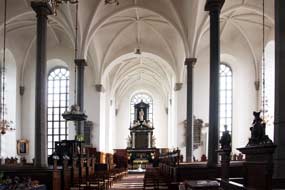 bus! And so it went on - Swedish common sense had finally
broken down! Thankfully when we walked over to the bus stop, the bus driver was
more understanding; he let us aboard and, on arrival at the bus station in the
centre, pointed out the bus! And so it went on - Swedish common sense had finally
broken down! Thankfully when we walked over to the bus stop, the bus driver was
more understanding; he let us aboard and, on arrival at the bus station in the
centre, pointed out the
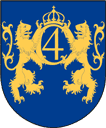 ticket office for our return tickets. We spent the whole
day practising correct pronunciation of Kristianstad; what looked self-evident
was in fact pronounced locally as Kri-SHAN-sta. ticket office for our return tickets. We spent the whole
day practising correct pronunciation of Kristianstad; what looked self-evident
was in fact pronounced locally as Kri-SHAN-sta.
Christian IV's 1614 founding of Kristianstad: Kristianstad
was founded in 1614 by King Christian IV of Denmark. The youthful Gustav II
Adolfus had assumed the Swedish throne in 1610 and one of his first acts was to
conclude peace with Denmark in 1613 recognising Denmark's control of the Skåne
region of SW Sweden. To reinforce Danish control of Skåne, Christian IV built
the fortress-town of Kristianstad which was protected by the marshlands of the
Helge å river. The town within its fortress walls was laid out in model
Renaissance form with elegantly proportioned squares, a broad grid of streets,
and fine buildings, the grandest of which was the glorious Renaissance church of Trefaldighets
(Holy Trinity) kyrkan. But Danish rule lasted only for 44 years: Gustav II
Adolfus harried Skåne, and his successor Karl X forced the defeated Danes to
accept the terms of the 1658 Treaty of Roskilde which finally conceded Skåne
back to Sweden. Many of Christian IV's grandly ambitious buildings in
Kristianstad were
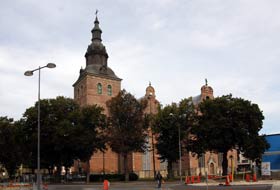 left unfinished when the Swedes took over the fortress-town,
including Holy Trinity Church whose elegant spire never reached its intended
place but finished up decorating Copenhagen Stock Exchange instead. Christian IV's emblem, C4, ironically however still emblazons the town's coat of arms (see
above left). The town remained small during the subsequent centuries, but 19th century demolition of the
confining fortress walls enabled the growing industrial town to extend beyond
into what was formerly the wetlands. Grand Parisian- left unfinished when the Swedes took over the fortress-town,
including Holy Trinity Church whose elegant spire never reached its intended
place but finished up decorating Copenhagen Stock Exchange instead. Christian IV's emblem, C4, ironically however still emblazons the town's coat of arms (see
above left). The town remained small during the subsequent centuries, but 19th century demolition of the
confining fortress walls enabled the growing industrial town to extend beyond
into what was formerly the wetlands. Grand Parisian-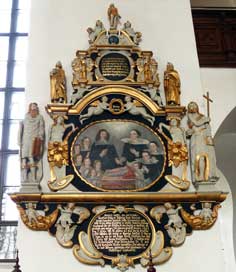 style boulevards were
created in the late 19th century, and although the town centre still retains
many of its original Renaissance buildings, these have been sullied by sordidly
dull concrete blocks of 1960~70s infills. style boulevards were
created in the late 19th century, and although the town centre still retains
many of its original Renaissance buildings, these have been sullied by sordidly
dull concrete blocks of 1960~70s infills.
Our
visit to Kristianstad: with our return bus tickets now assured, we began
our visit to Kristianstad at the church which originally was built between the
river-side city-wall, now the railway station, and Stora torg market-place, on a
diagonal to the town's formal grid-plan layout to ensure its chancel faced east
(see left).
The church's 7 lofty, decorated gable ends were modelled on those at Frederiksborg Castle at Hillerød in Zealand, Denmark which houses the collection of Danish royal
portraits (see log of our 2007 visit).
The church at Kristianstad was consecrated on Holy Trinity Day (8 June) 1628.
The church's vaulted ceiling was supported by 12 slender granite pillars with
light streaming in through 26 plain glass windows (see above right). The most striking feature
however were the 61 high carved wooden pew-ends each one different, some having
heraldic motifs. The west end was dominated by the magnificent 1630 gilded
Renaissance organ. Around the church both inside and out tombstones were set
against the walls, with one macabre stone bearing the Grim Reaper and hour-class
symbolising human mortality. The north and south walls were decorated with
wealthy families' epitaphia memorials. One from 1661 commemorating the Lavesen
family was particularly moving, set up by the wife in memory of her husband who
had died at the age of 42; they had been married for 15 years and had 11
children; the monument's central painting showed the whole family with all
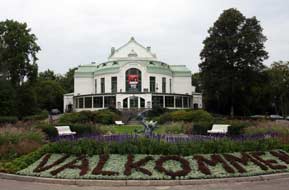 11
children, 5 of whom were crowned with garlands symbolising their deaths in
infancy (see right) (Photo 22 - Lavesen family memorial, Kristianstad). The text records the hope that the family would 'Joyfully meet again at
the resurrection of the righteous'. Of all the large churches visited in Sweden,
this was probably the most beautiful. 11
children, 5 of whom were crowned with garlands symbolising their deaths in
infancy (see right) (Photo 22 - Lavesen family memorial, Kristianstad). The text records the hope that the family would 'Joyfully meet again at
the resurrection of the righteous'. Of all the large churches visited in Sweden,
this was probably the most beautiful.
From the church we crossed the river on a wooden
footbridge to the wood-faced building out in the reed-covered marshes which
houses the Vattenriket Naturum where the staff gave us more details of the
wetlands nature reserve. Of particular interest was the 6kms Linnérunden nature
trail around the wetlands; had we known of this yesterday, this would have given
a far more rewarding means of exploring the Vattenriket wetlands and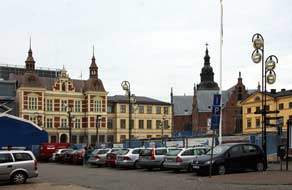 seeing
the birdlife than the over-commercialised boat trip. Back over to the town, we
walked through the English-style gardens of Tivoli Park. The parkland and
avenues of horse chestnut trees were delightful with the 1906 art nouveau
theatre
at the park's centre (see left). But the sky was becoming threatening dark now with
the forecast rain
on its way as we
crossed Västra Boulevarden to walk back through the grid of streets to Stortorget.
But when we reached what ought to have been the elegant centre of Christian IV's
Renaissance town, the entire heart and soul of this charming town had been
ripped out; the whole of the square, the surrounding streets and boulevards, and
access to the Rådhus was in total devastation, being upgraded in readiness for
the 2014 400th anniversary celebrations of the town's foundation (see right). Behind the
1920s twin buildings of the Post Office and Savings Bank, the Regional Museum
was closed today, a further disappointment. The building had been begun by
Christian IV as a palace, but the 1658 re-occupation had interrupted
construction and no more than the single-storey stables which now house the
museum were completed. On the north side of the square, the 19th century
Empire-style Store Kronohuset had been built as the HQ of the Wende Artillery
Regiment and was topped with their motto 'Legibus et Armis', but the elegant
building was now obscured by road works. We tried to gain access to the town
hall to see Christian IV's bust but were prevented by the contractor's site
official, and with rain now starting we took shelter behind the church. With the
sky now dark and gloomy, we walked around for a cursory look at to the Bastion Konungen, a partial reconstruction of the Renaissance town redoubts complete
with cannons. In pouring rain on a chill and gloomy late afternoon, there was
little left now but to plodge back to the station to catch the bus back out to
the campsite.
seeing
the birdlife than the over-commercialised boat trip. Back over to the town, we
walked through the English-style gardens of Tivoli Park. The parkland and
avenues of horse chestnut trees were delightful with the 1906 art nouveau
theatre
at the park's centre (see left). But the sky was becoming threatening dark now with
the forecast rain
on its way as we
crossed Västra Boulevarden to walk back through the grid of streets to Stortorget.
But when we reached what ought to have been the elegant centre of Christian IV's
Renaissance town, the entire heart and soul of this charming town had been
ripped out; the whole of the square, the surrounding streets and boulevards, and
access to the Rådhus was in total devastation, being upgraded in readiness for
the 2014 400th anniversary celebrations of the town's foundation (see right). Behind the
1920s twin buildings of the Post Office and Savings Bank, the Regional Museum
was closed today, a further disappointment. The building had been begun by
Christian IV as a palace, but the 1658 re-occupation had interrupted
construction and no more than the single-storey stables which now house the
museum were completed. On the north side of the square, the 19th century
Empire-style Store Kronohuset had been built as the HQ of the Wende Artillery
Regiment and was topped with their motto 'Legibus et Armis', but the elegant
building was now obscured by road works. We tried to gain access to the town
hall to see Christian IV's bust but were prevented by the contractor's site
official, and with rain now starting we took shelter behind the church. With the
sky now dark and gloomy, we walked around for a cursory look at to the Bastion Konungen, a partial reconstruction of the Renaissance town redoubts complete
with cannons. In pouring rain on a chill and gloomy late afternoon, there was
little left now but to plodge back to the station to catch the bus back out to
the campsite.
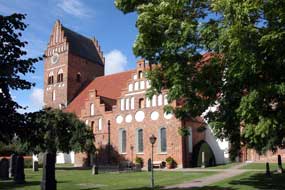 The small port of Åhus: from
Kristianstad we headed south on Route 118 to the small town of Åhus down on the
Skåne coast. Åhus developed as a trading settlement at the mouth of the Helge å
river, fortified with a castle to protect the flourishing port as early as Knut
the Great. The good times for Åhus came to an end in 1617 after Christian IV ordered
the town's tradesman to move to newly founded Kristianstad further inland up the
river, and Åhus lost its town status. Åhus enjoyed a new lease of life when the
arrival of the railway in the late 19th century brought the development of new
industries: the cigar factory rolled cigars The small port of Åhus: from
Kristianstad we headed south on Route 118 to the small town of Åhus down on the
Skåne coast. Åhus developed as a trading settlement at the mouth of the Helge å
river, fortified with a castle to protect the flourishing port as early as Knut
the Great. The good times for Åhus came to an end in 1617 after Christian IV ordered
the town's tradesman to move to newly founded Kristianstad further inland up the
river, and Åhus lost its town status. Åhus enjoyed a new lease of life when the
arrival of the railway in the late 19th century brought the development of new
industries: the cigar factory rolled cigars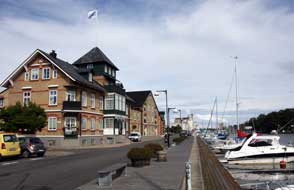 from locally grown tobacco, and
locally caught smoked eels became an export commodity. Åhus became a popular
seaside bathing resort in the 20th century and the Absolut Vodka distillery
began production here and is still a local prominent landmark now owned by the Pernod conglomerate. We walked along the quiet town street towards the Torget
market square where the museum displayed archaeological finds telling Åhus'
early history. The NW corner of the square was dominated by the red brick gabled
tower of the Maria kyrka parts of which date from the 12th century extended over
subsequent centuries (see left) (Photo 23 - Maria kyrka at Åhus). Inside, the irregular shape of the nave and 3 bulky
pillars were evidence of the gradual process of extending the church. Its most
prominent decorations were the 16~17th century beautifully carved and decorated
wooden pulpit and altar retable. Having managed to escape Baroque and 19th
century ornamentation, this was one of Southern Sweden's most beautiful
churches. Across the square we walked along the riverside waterfront past
the Absolut Vodka distillery with its distinctive red brick clock tower (see
right);
reportedly ½ million bottles of the evil stuff are produced here daily. The
industrial harbour at the river's mouth was dominated by enormous grain silos
and the smell of barley hung in the air. from locally grown tobacco, and
locally caught smoked eels became an export commodity. Åhus became a popular
seaside bathing resort in the 20th century and the Absolut Vodka distillery
began production here and is still a local prominent landmark now owned by the Pernod conglomerate. We walked along the quiet town street towards the Torget
market square where the museum displayed archaeological finds telling Åhus'
early history. The NW corner of the square was dominated by the red brick gabled
tower of the Maria kyrka parts of which date from the 12th century extended over
subsequent centuries (see left) (Photo 23 - Maria kyrka at Åhus). Inside, the irregular shape of the nave and 3 bulky
pillars were evidence of the gradual process of extending the church. Its most
prominent decorations were the 16~17th century beautifully carved and decorated
wooden pulpit and altar retable. Having managed to escape Baroque and 19th
century ornamentation, this was one of Southern Sweden's most beautiful
churches. Across the square we walked along the riverside waterfront past
the Absolut Vodka distillery with its distinctive red brick clock tower (see
right);
reportedly ½ million bottles of the evil stuff are produced here daily. The
industrial harbour at the river's mouth was dominated by enormous grain silos
and the smell of barley hung in the air.
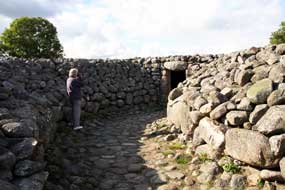 The
Kivik Kungagraven Bronze Age burial mound: Route 118 followed the
coast westwards around the monotonous flatlands of the Helge å estuary whose
various channels ambled through farmland down to the sea. But once we joined
Route 9, the nature of the terrain changed drastically to rolling hilly
countryside. We drove into the little fishing port of Kivik passing the field
where the village's annual market is held each July, and just beyond reached our
second visit for today, the Kivik Kungagraven (King's Grave), a huge Bronze Age
burial mound dating from around 1,000 BC. The site had been exploited during the
early 18th century as a quarrying source of building stone, until 1748 when
local farmers dug into the stone-covered mound and discovered a cist-tomb lined
with 10 stone slabs. Hoping for treasure, they continued digging but found
nothing and were arrested for tomb-robbing. Quarrying continued but then it was
discovered that the The
Kivik Kungagraven Bronze Age burial mound: Route 118 followed the
coast westwards around the monotonous flatlands of the Helge å estuary whose
various channels ambled through farmland down to the sea. But once we joined
Route 9, the nature of the terrain changed drastically to rolling hilly
countryside. We drove into the little fishing port of Kivik passing the field
where the village's annual market is held each July, and just beyond reached our
second visit for today, the Kivik Kungagraven (King's Grave), a huge Bronze Age
burial mound dating from around 1,000 BC. The site had been exploited during the
early 18th century as a quarrying source of building stone, until 1748 when
local farmers dug into the stone-covered mound and discovered a cist-tomb lined
with 10 stone slabs. Hoping for treasure, they continued digging but found
nothing and were arrested for tomb-robbing. Quarrying continued but then it was
discovered that the
 cyst-tomb
slabs were covered with engraved petroglyphs. The site was excavated during the
1930s and 2 tombs were discovered but little in the way of remains, the
tombs having been looted over the centuries. The tombs' stone tumulus was
restored and a new artificial burial chamber created with an access tunnel cut
into the side of the mound for modern-day visitors to see the surviving engraved
upright slabs which had lined the original grave. cyst-tomb
slabs were covered with engraved petroglyphs. The site was excavated during the
1930s and 2 tombs were discovered but little in the way of remains, the
tombs having been looted over the centuries. The tombs' stone tumulus was
restored and a new artificial burial chamber created with an access tunnel cut
into the side of the mound for modern-day visitors to see the surviving engraved
upright slabs which had lined the original grave.
We walked the circumference of the 3.5m high
stone-covered mound which spread for a diameter of 75m; the original tumulus may
have been even higher prior to the quarrying. The winding access 'dromos' cut
into the mound led to a stone-lintelled doorway which gave access to the inner
chamber
 where
the cyst-lining of upright slabs were set up to give an impression of the
original grave. The petroglyphs had been partially coloured in with red paint to
make them more visible. The most evident engravings showed figures playing lures
and drums, a procession of cloak-wearing figures, 2 mysterious Ω symbols (see
right), and most significantly another 2 horse chariot with 4-spoked wheels
and a charioteer holding the reins (see left) (Photo 24 - 2 horse chariot and charioteer engraving), exactly as at Norrköping rock
engravings and Mycenaean paintings from contemporary Bronze Age period. This was
accompanied by a column of sword-carrying male figures perhaps representing a
funeral procession. Other slabs bore geometric patterns, particularly 2 large
sun symbols. We spent time in the gloom of the chamber photographing the
petroglyphs and marvelling at this ancient artwork so remarkably preserved and
so similar in format to other Bronze Age engravings we had seen. where
the cyst-lining of upright slabs were set up to give an impression of the
original grave. The petroglyphs had been partially coloured in with red paint to
make them more visible. The most evident engravings showed figures playing lures
and drums, a procession of cloak-wearing figures, 2 mysterious Ω symbols (see
right), and most significantly another 2 horse chariot with 4-spoked wheels
and a charioteer holding the reins (see left) (Photo 24 - 2 horse chariot and charioteer engraving), exactly as at Norrköping rock
engravings and Mycenaean paintings from contemporary Bronze Age period. This was
accompanied by a column of sword-carrying male figures perhaps representing a
funeral procession. Other slabs bore geometric patterns, particularly 2 large
sun symbols. We spent time in the gloom of the chamber photographing the
petroglyphs and marvelling at this ancient artwork so remarkably preserved and
so similar in format to other Bronze Age engravings we had seen.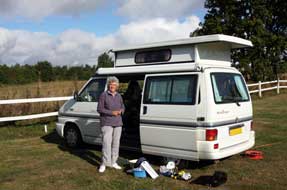
Ängdala
Vandrahem and Camping: after shopping for smoked fish at the Buhres
fiske-rökeri on the quayside at Kivik harbour, we returned along Route 9 to find
tonight's campsite, Ängdala Vandrahem and Camping. Reception was closed at this time of year but a
telephone call brought a welcoming response from the owner; we should make
ourselves at home and she would call round tomorrow. We had the site virtually
to ourselves and pitched over by the far corner of the camping area which spread
across the gently sloping hillside. Ängdala was a lovely peaceful site and we
were looking forward to our 3 nights here with a day in camp after tomorrow's
walking in the Stenshuvud National Park on the Skåne coast just beyond Kivik.
After a wet night, we woke to a clearing sky and were just washing up when a red
kite with its distinctive tawny-brown colouring and forked tail soared high over the
neighbouring meadows. We later learnt that red kites are commonly seen over the rolling open hills of the Österlen coast.
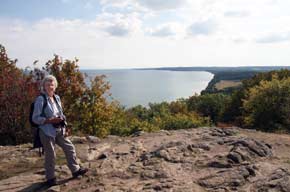 The Stenshuvud National Park:
the
Stenshuvud National Park is a tiny 3kms
long area of prominent wooded
coastal headland 97m at its highest point dropping steeply on its seaward side
with heathland and cattle-grazed meadows to the south. The northern hill
is covered with broad-leafed woodland, mainly beach, hornbeam, oak and
sycamore. Having secured a footpath map at the Naturum, we set off on the
way-marked route onto the main hill for what was going to be a relaxed 2km
walk. In such a woodland setting with the smell of fallen autumnal beech leaves
filling the air,
we could have been in an English county. Up the gently sloping path with
sunlight filtering down through the beech trees, we crossed the remains of an
Iron The Stenshuvud National Park:
the
Stenshuvud National Park is a tiny 3kms
long area of prominent wooded
coastal headland 97m at its highest point dropping steeply on its seaward side
with heathland and cattle-grazed meadows to the south. The northern hill
is covered with broad-leafed woodland, mainly beach, hornbeam, oak and
sycamore. Having secured a footpath map at the Naturum, we set off on the
way-marked route onto the main hill for what was going to be a relaxed 2km
walk. In such a woodland setting with the smell of fallen autumnal beech leaves
filling the air,
we could have been in an English county. Up the gently sloping path with
sunlight filtering down through the beech trees, we crossed the remains of an
Iron Age fort and soon emerged onto the hill's treeless southern high point (södra
huvud). The path continued through juniper bushes and brambles onto the eastern
high point from where glorious distant views looked out across the southern
sweep of beaches around Hanöbukten Bay (see left). A little further and we
reached another viewpoint on the brink of the rocky precipice dropping 90m to
the shore below with a further stunning vista out across the blue Baltic and
the Danish island of Bornholm just visible on the horizon (Photo 25 - Baltic coast-line from Stenshuvud National Park). Across through
hill-top scrub onto the northern high point, the view stretched along the
northwards coast of Hanöbukten Bay with the hill dropping sheer into a wooded
valley. Back down through the beech woods, a path led down to 18th century
shacks on the Baltic shore still used by eel fishermen. Along the shoreline with
a gentle surf lapping over our boots, the wooded headland of Stenshuvud
stood out clearly with its beeches' autumnal colours catching the sunlight (see
right). All around Kivik apple orchards fill every field and cottage garden, the
trees at this time of year laden with red, rosy apples, and on the way back to
camp we called in at Kiviks Musteri, a family-run cider and apple-juice producer
and farm shop, to sample their produce.
Age fort and soon emerged onto the hill's treeless southern high point (södra
huvud). The path continued through juniper bushes and brambles onto the eastern
high point from where glorious distant views looked out across the southern
sweep of beaches around Hanöbukten Bay (see left). A little further and we
reached another viewpoint on the brink of the rocky precipice dropping 90m to
the shore below with a further stunning vista out across the blue Baltic and
the Danish island of Bornholm just visible on the horizon (Photo 25 - Baltic coast-line from Stenshuvud National Park). Across through
hill-top scrub onto the northern high point, the view stretched along the
northwards coast of Hanöbukten Bay with the hill dropping sheer into a wooded
valley. Back down through the beech woods, a path led down to 18th century
shacks on the Baltic shore still used by eel fishermen. Along the shoreline with
a gentle surf lapping over our boots, the wooded headland of Stenshuvud
stood out clearly with its beeches' autumnal colours catching the sunlight (see
right). All around Kivik apple orchards fill every field and cottage garden, the
trees at this time of year laden with red, rosy apples, and on the way back to
camp we called in at Kiviks Musteri, a family-run cider and apple-juice producer
and farm shop, to sample their produce.
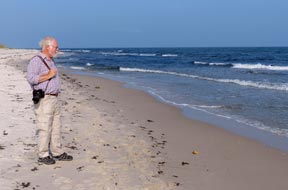 Around
the Österlen coast to Dag Hammarskjöld's Backåkra farmstead: in misty autumn sunshine we continued around the Österlen coast,
passing more apple and plum orchards, into the port of Simrishamn from where
ferries sail to Bornholm. On a sunny autumn weekend Swedish visitors milled
around the port and main street. After a pause to eat our sandwich lunch at the
fishing harbour of Skillinge, we followed the minor Östra Kust vägen which winds
faithfully along the coast, and turned off to Sandhammaren beach. Set at the
angle where Skåne's southern coastline swings NE, this glorious stretch of white
sandy wild strand would be heaving with holiday-makers in the height of summer,
but thankfully in mid-September it was almost deserted. Signs warned of the
dangerous currents which wind and tide sweep around just off-shore. Just west of
here along the lane we turned off again to find the Backåkra farmstead bought by
Dag Hammarskjöld as a summer retreat. Set amid rolling heathland close to the Hagestad
Nature Reserve, the farmhouse and surrounding meadowland was willed by
Hammarskjöld to the Swedish Touring Association (STF) of which he was
vice-president, as a meeting place for cultural activities. After his tragic
death in 1961, the farm was set up by STF as a museum to Hammarskjöld's life and
work and many of the works of art collected by him were gathered there. To STF's
embarrassment however this not-for-profits organisation has found itself
strapped for cash, and last year was forced to close the Backåkra. Around
the Österlen coast to Dag Hammarskjöld's Backåkra farmstead: in misty autumn sunshine we continued around the Österlen coast,
passing more apple and plum orchards, into the port of Simrishamn from where
ferries sail to Bornholm. On a sunny autumn weekend Swedish visitors milled
around the port and main street. After a pause to eat our sandwich lunch at the
fishing harbour of Skillinge, we followed the minor Östra Kust vägen which winds
faithfully along the coast, and turned off to Sandhammaren beach. Set at the
angle where Skåne's southern coastline swings NE, this glorious stretch of white
sandy wild strand would be heaving with holiday-makers in the height of summer,
but thankfully in mid-September it was almost deserted. Signs warned of the
dangerous currents which wind and tide sweep around just off-shore. Just west of
here along the lane we turned off again to find the Backåkra farmstead bought by
Dag Hammarskjöld as a summer retreat. Set amid rolling heathland close to the Hagestad
Nature Reserve, the farmhouse and surrounding meadowland was willed by
Hammarskjöld to the Swedish Touring Association (STF) of which he was
vice-president, as a meeting place for cultural activities. After his tragic
death in 1961, the farm was set up by STF as a museum to Hammarskjöld's life and
work and many of the works of art collected by him were gathered there. To STF's
embarrassment however this not-for-profits organisation has found itself
strapped for cash, and last year was forced to close the Backåkra.
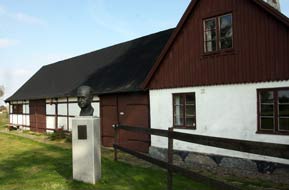
Born in 1905 to a wealthy family (his
father was Swedish PM from 1914~17), Hammarskjöld was educated at Uppsala and
Cambridge and followed a political career. In 1953 he was elected to the post of
UN Secretary General, the 2nd holder of the post since the UN's foundation in
1946, and re-elected for a second term in 1958. His approach to settling world
problems was determined but 'quiet diplomacy', and during the 1956 Suez Crisis,
he instituted UN peace-keeping forces. While on a mission to former Belgian
Congo in 1961 attempting to re-integrate the breakaway mineral-rich province of Katanga to
the Congo's elected Lumumba government, the plane in which he was travelling
mysteriously crashed killing all on board. The cause of the crash has never been
resolved but neither has foul play been ruled out. A
recent BBC report
detailed pressure for the UN to re-open its enquiries into
Hammarskjöld's death, alleging that mining interests who stood to loose if
Katanga was re-integrated into Congo were involved and that the plane had been
shot down; it was also alleged that US and British security agencies had
previously withheld knowledge of radio messages from the plane's pilot saying
 they were being attacked.
Perhaps after 60 years, the shady dealings behind Hammarskjöld's tragic death
will come to light. In the meantime, this peaceful farmstead left by the
post-war diplomat in the care of the STF remains closed; and no one seems
bothered. A bust of the UN Secretary General stands beside the now-locked and
deserted farmhouse (see right). they were being attacked.
Perhaps after 60 years, the shady dealings behind Hammarskjöld's tragic death
will come to light. In the meantime, this peaceful farmstead left by the
post-war diplomat in the care of the STF remains closed; and no one seems
bothered. A bust of the UN Secretary General stands beside the now-locked and
deserted farmhouse (see right).
The Hagestad Nature Reserve: a lane
leads from the farmstead down to the Hagestad Nature Reserve, an area of pine,
beech and oak woodlands standing behind beautiful white sand beaches along the
southern Skåne coast, where during the 19th century 1000s of trees were planted to
bind the sandy soil. Coastal sand continues to be eroded by wind and current,
blown eastwards reducing land area here and piling up on Sandhammaren beach
further round where the coast swings northwards. A path led through beech-woods,
where Lily of the Valley were covered with autumn orange berries (in the early
summer this would be a haven of sweetly scented flowers), to the dunes backing
the beach, with tall grasses outlined against the soft afternoon sunlight. We
crossed the fine sandy beach to stand by the Baltic waterline (see left).
 Löderups Strandbad Camping: the only
campsite along the southern Skåne coast remaining open this late in year was Löderups Strandbad Camping and we had grave reservation from its name that it
would be static-filled and perhaps over-crowded even on a September weekend;
we had no choice but to try it and turned off on a side-lane down to the coast.
We were greeted at reception by a seemingly gruff elderly gent; 150kr a night he
responded with a shrug. The campsite was indeed filled with static caravans but
generally empty and people with trailers were busy with end-of-season demolition
of decking, fencing and garden gnomes. We found a space recently vacated by a
removed static immediately by the shore-side looking straight
out over the Baltic and, with some hesitation about the sand, settled in with a
gentle surf lapping the beach below us. Darkness fell suddenly at 8-00pm and we
enjoyed the final barbecue of the trip with
the light of a half-moon gleaming across the water (see left). Löderups Strandbad Camping: the only
campsite along the southern Skåne coast remaining open this late in year was Löderups Strandbad Camping and we had grave reservation from its name that it
would be static-filled and perhaps over-crowded even on a September weekend;
we had no choice but to try it and turned off on a side-lane down to the coast.
We were greeted at reception by a seemingly gruff elderly gent; 150kr a night he
responded with a shrug. The campsite was indeed filled with static caravans but
generally empty and people with trailers were busy with end-of-season demolition
of decking, fencing and garden gnomes. We found a space recently vacated by a
removed static immediately by the shore-side looking straight
out over the Baltic and, with some hesitation about the sand, settled in with a
gentle surf lapping the beach below us. Darkness fell suddenly at 8-00pm and we
enjoyed the final barbecue of the trip with
the light of a half-moon gleaming across the water (see left).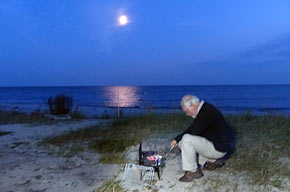
A wet day in camp overlooking the stormy
Baltic: the weather changed drastically overnight and we woke to a
gloomily overcast sky and brisk SW wind driving misty drizzle into the doorway
and the sand outside sodden from overnight rain. In such unpromising weather,
there was little option but to take a rest day today in this glorious shore-side
spot, but with the wind off the sea having swung round 90° from yesterday, the
first thing was to bring George's nose round into the wind to stop rain driving
in to the slider. In contrast with yesterday afternoon, the sea was now leadenly
grey with huge, wind-driven breakers pounding onto the shore and the air filled
with its roaring sound and salty tang of spray. It was best to be gazing out at
the thrilling sight of this savage sea from within the snug warmth of the camper
as rain lashed the front. Gulls flitted over the waves gourging themselves with
beakfuls of elvers in the turbulent shallow waters (Photo 26 - Gulls scooping elvers from surf at Löderups beach).
The rain eased but the vigorous SW wind continued to blow driving a huge surf
onto the shore. Later in the afternoon the rain finally stopped and sky
brightened over the still sullen grey sea, with a breezy sun lighting this
magnificent seascape with white breakers crashing onto the beach below (see
above right) (Photo 27 - Wind-driven breakers at Löderups beach).
The medieval port of Ystad: the gusty
SW gale buffeted George all night and was still blowing this morning driving
rain into the doorway and taking 2 of us to lower the roof. We settled up our 2
days' rent and reserved our space for a return later after our visit to Ystad.
Around the coast through bedraggled farming countryside, we joined Route 9 into
Ystad and parked opposite the railway station and port. Wearing waterproofs
against the
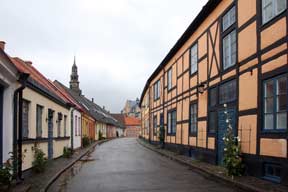 driving rain, we set of on our tour of what in fine weather would
have been a charming medieval market town. Ystad began life as a Baltic herring
fishing port-village in the early 12th century and the herring trade remained a
major local industry for centuries. In the mid-13th century the town's Maria
kyrkan was built and in 1267 Danish Grey Friars founded the monastery. In the
14th century such was Ystad's wealth that the port joined the Hanseatic League.
The monastery was closed by the 1532 Reformation, and in 1569 Ystad was attacked
by Swedes during the years of warfare over Skåne, but the port survived and
continued to flourish. As the herring industry declined, the export trade of
cattle to driving rain, we set of on our tour of what in fine weather would
have been a charming medieval market town. Ystad began life as a Baltic herring
fishing port-village in the early 12th century and the herring trade remained a
major local industry for centuries. In the mid-13th century the town's Maria
kyrkan was built and in 1267 Danish Grey Friars founded the monastery. In the
14th century such was Ystad's wealth that the port joined the Hanseatic League.
The monastery was closed by the 1532 Reformation, and in 1569 Ystad was attacked
by Swedes during the years of warfare over Skåne, but the port survived and
continued to flourish. As the herring industry declined, the export trade of
cattle to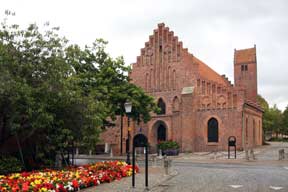 North Germany increased in importance. By the time Skåne became
Swedish in 1658 Ystad had reached a population of 2,000 and a regular post-boat
service to Stralsund began. The trading port increased in size and wealthy
merchants built imposing houses in the town. With the arrival of the railway,
Ystad became a popular seaside resort and the port continued to bring prosperity
to the town. There are still major ferry links to Świnoujście in
Northern Poland and to Bornholm, and Henning Mankell's Wallander detective
novels are set
around Ystad. North Germany increased in importance. By the time Skåne became
Swedish in 1658 Ystad had reached a population of 2,000 and a regular post-boat
service to Stralsund began. The trading port increased in size and wealthy
merchants built imposing houses in the town. With the arrival of the railway,
Ystad became a popular seaside resort and the port continued to bring prosperity
to the town. There are still major ferry links to Świnoujście in
Northern Poland and to Bornholm, and Henning Mankell's Wallander detective
novels are set
around Ystad.
We
walked up to Stortorget, which on a fine day would have been a pleasant market,
but today with driving rain beginning again, we sought shelter in the Maria kyrkan which towered over the square. This was another truly beautiful medieval
church with rich decorative features. The walls were covered with highly ornate
17th century commemorative sepulchral tablets set up by wealthy families, and at
the west end 2 sets of box-pews segregated women awaiting 'Christian cleansing'
after surviving childbirth; this barbaric
tradition of 'Churching' women continued well into the 20th century! The Ystad
Town Watchman continues to blow
his horn from the church tower each evening every 15 minutes, just to let
everyone know that all is well.
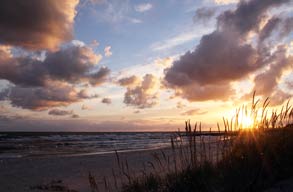 By the time we emerged from the church the rain
had eased for us to walk along Lilla Västergatan to photograph the 16th century
half-timbered cottages (see above left) and stepped-gabled Latin School. Along Stora Östergatan
main street, we called in at the System Bolaget for bottles of the local beer;
the manager put up a brave defence of the Swedish government protected trading
monopoly on alcohol. After viewing the 18th century half-timbered cottages in
Väderägrand, we walked along Norrgatan to admire the beautifully restored 16th
century Änglahuset with its carved, decorated beam-ends of its half-timbering.
Just along a side street, the attractively restored red brick former Klostret
(monastery) now doubles as parish church and museum (see above right). By the time we emerged from the church the rain
had eased for us to walk along Lilla Västergatan to photograph the 16th century
half-timbered cottages (see above left) and stepped-gabled Latin School. Along Stora Östergatan
main street, we called in at the System Bolaget for bottles of the local beer;
the manager put up a brave defence of the Swedish government protected trading
monopoly on alcohol. After viewing the 18th century half-timbered cottages in
Väderägrand, we walked along Norrgatan to admire the beautifully restored 16th
century Änglahuset with its carved, decorated beam-ends of its half-timbering.
Just along a side street, the attractively restored red brick former Klostret
(monastery) now doubles as parish church and museum (see above right).
We returned to Löderups Strandbad Camping and
called in at reception to book; the elderly gent passed
back the proffered 150kr notes saying 'Bonus!' Over the 3 days we had revised
our opinion of him. With the weather now improved with even a hint of sun, it
seemed a pity not to enjoy a a final night by the shore-side looking over
the suf. That evening the setting sun and cloud-scape array produced a
magnificent Big Sky panorama (see left) (Photo 28 - Sunset panorama at Löderups beach).
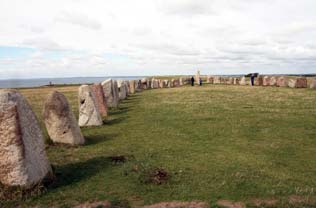 Iron Age stone ship-setting burial monument of
Ales Stenar: despite our initial reservations, Löderups Strandbad
Camping had served us well: its scruffy familiarity, magnificent shore-side
setting with pounding surf, and charactersome owner had endeared themselves to
us; but of course only at this late stage of the year when most of the usual
summer occupants had long departed leaving the site in peace! With brighter sun
and just a thin veil of cloud, we drove westwards around the coast road and
turned off to the car park in Kåseberga fishing village. A path led past the
cottages uphill to the sandy cliff-tops above the little harbour, leading to the
flat-topped meadowland on the breezy hill top. Ahead we could see the Ales
Stenar circle of megaliths silhouetted against the sky: 59 standing stones
arranged in a 67m long ship-setting with larger bow and stern Iron Age stone ship-setting burial monument of
Ales Stenar: despite our initial reservations, Löderups Strandbad
Camping had served us well: its scruffy familiarity, magnificent shore-side
setting with pounding surf, and charactersome owner had endeared themselves to
us; but of course only at this late stage of the year when most of the usual
summer occupants had long departed leaving the site in peace! With brighter sun
and just a thin veil of cloud, we drove westwards around the coast road and
turned off to the car park in Kåseberga fishing village. A path led past the
cottages uphill to the sandy cliff-tops above the little harbour, leading to the
flat-topped meadowland on the breezy hill top. Ahead we could see the Ales
Stenar circle of megaliths silhouetted against the sky: 59 standing stones
arranged in a 67m long ship-setting with larger bow and stern
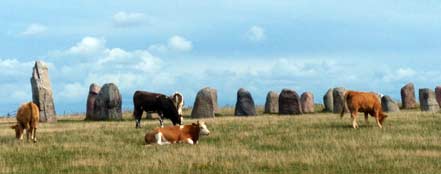 stones make up the
megalithic monument which has been dated to the late Iron Age between 600~1,000
AD. The stones, each weighing over a ton, are not native to these parts and must
have been transported here. Evidence of earlier Bronze Age burials beneath the
stones suggests it had long been a sacred place of worship, assembly and memorial, and looking around the mysterious cliff-top and rolling coastal hills, you
could understand why. Various bizarre theories have been advanced about the
alignment of stones forming a solar calendar. Standing there on the cliff-top
however in the soft, hazy sunlight, looking across the ship-setting with cattle
grazing peacefully around the meadow, it was enough to acknowledge their
timelessness and the beauty of the setting looking out across the Baltic. We
took our photos both of the stones and along the line of sand cliffs stretching
away westwards with the wind driving surf onto the beach below, and returned
downhill to the little fishing harbour of Kåseberga nestled into the sheltered
cove below. Here at the stones make up the
megalithic monument which has been dated to the late Iron Age between 600~1,000
AD. The stones, each weighing over a ton, are not native to these parts and must
have been transported here. Evidence of earlier Bronze Age burials beneath the
stones suggests it had long been a sacred place of worship, assembly and memorial, and looking around the mysterious cliff-top and rolling coastal hills, you
could understand why. Various bizarre theories have been advanced about the
alignment of stones forming a solar calendar. Standing there on the cliff-top
however in the soft, hazy sunlight, looking across the ship-setting with cattle
grazing peacefully around the meadow, it was enough to acknowledge their
timelessness and the beauty of the setting looking out across the Baltic. We
took our photos both of the stones and along the line of sand cliffs stretching
away westwards with the wind driving surf onto the beach below, and returned
downhill to the little fishing harbour of Kåseberga nestled into the sheltered
cove below. Here at the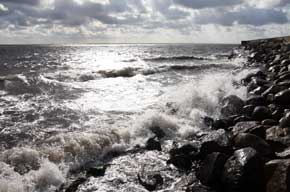 rökeri we bought more smoked fish for our final nights'
suppers. rökeri we bought more smoked fish for our final nights'
suppers.
Smygehuk, Sweden's southernmost point:
we continued westwards past Ystad along the shore-line hugging coast road through a continuous series of dreary holiday
home settlements to reach Smygehamn and Smygehuk. This otherwise unnoteworthy
marina enjoyed the distinction of being Sweden's southernmost point which
in summer draws bus loads of tourists to what is a largely featureless
part Skåne. We pulled in by the little harbour for a token visit
and the sign-board
announced: Smygehuk, Sveriges sydligaste udde - 55° 20' 13" N, 13° 21' 34" O,
with
 distances London 991km, Stockholm 510km, Copenhagen 61km and Treriksröset
1572km, although had we taken a straw-poll of Swedes snapping away here before
piling back into their tour-bus, doubtless not one would have known where the
Three Countries Stone was and its significance! (see
log of our 2012 visit to Treriksröset, Sweden's northernmost point)
A far more impressive and personal touch was the stone set on the sea-wall
inscribed Lisa 2013 - Treriksröset to Smyggehuk and an
outline of her bicycle on which the unknown Lisa had ridden the 1572km from the
northernmost to southernmost points of Sweden. With due admiration we
photographed this record of her achievement (see left) and the magnificent surf
crashing onto the rocks below lit by the now bright afternoon sun (see right) (Photo 29 - Smygehuk, Sweden's southernmost point). distances London 991km, Stockholm 510km, Copenhagen 61km and Treriksröset
1572km, although had we taken a straw-poll of Swedes snapping away here before
piling back into their tour-bus, doubtless not one would have known where the
Three Countries Stone was and its significance! (see
log of our 2012 visit to Treriksröset, Sweden's northernmost point)
A far more impressive and personal touch was the stone set on the sea-wall
inscribed Lisa 2013 - Treriksröset to Smyggehuk and an
outline of her bicycle on which the unknown Lisa had ridden the 1572km from the
northernmost to southernmost points of Sweden. With due admiration we
photographed this record of her achievement (see left) and the magnificent surf
crashing onto the rocks below lit by the now bright afternoon sun (see right) (Photo 29 - Smygehuk, Sweden's southernmost point).
Arrival
at Trelleborg: a few kms west, we parked by the freight-yards of the
port-town of Trelleborg, and consistent with our usual experience that the least
assuming of places generally offer the most thorough and efficient standard of
tourist information service, the lady in Trelleborg's TIC impressed us with her
local knowledge, particularly providing details of Trelleborg's Viking era
fortress. Trelleborg (pronounced Trelleboy) had for centuries been a
prosperous Baltic herring fishing port, attracting merchants from Germany.
Commercial rivalry with Malmö however resulted in the city's merchant status
being revoked in 1619 by the Danish King. It became Swedish again in 1658 along
with the rest of Skåne, but it was only in 1867 that Trelleborg regained its
merchant city status. With the coming of the railways in the late 19th century,
both port and industry expanded, so that today Trelleborg is the 2nd largest sea
port in Sweden after Görteborg, with 10 million tons of freight passing through
the port each year. It is also Sweden's principle ferry passenger link with
Northern Europe with ferry links to Rostock, Travemünde, Lübeck and Sassnitz for
both cars and freight lorries which began in 1909. It was in April 1917 that
Lenin arrived at Trelleborg on the ferry from Sassnitz on his way back from
exile to lead the Revolution in Russia.
Trelleborg's conserved Viking fortress:
guided by the TIC lady's precise directions, we found the Viking era origins
of Trelleborg tucked away in a residential area with a main road cutting through
the remains of the once circular borg-fortress which dated from the time of King
Harold Bluetooth around 980 AD and discovered in 1988. It was That Harold
Bluetooth who united the Danish Viking Kingdom and converted it to Christianity
as his record inscribed on his memorial runestone at Jelling in Jutland had told
us (see
log of our 2007 visit to the Jelling Stone). This was a time of
consolidating the home kingdom rather than grand overseas expeditions of raids
plundering treasures. It was also a time of defending the newly united Danish
kingdom from neighbours both in the North and Germany, hence the need for
ring-fortresses. The borg at Trelleborg shows all the characteristics of other
ring-forts constructed by Harold Bluetooth in Sjæland and Jutland: built astride
significant trade and communications land and marine routes, not for military
occupation but for defending the consolidated kingdom, levying taxes and tolls
and for guarding accumulated wealth. Each of the ring-forts covered a large area
with gates at the cardinal quarters and enclosing significant numbers of long
houses.
 We
had visited 3 of Harold's identically arranged ring-fort at Trelleborg in
Sjæland and at Fyrkat and Aggersborg in North Jutland. Little of these had
survived except the circuit of earthworks which had originally formed the core
of timber-palisade fortification walls. Here in Skåne Trelleborg in 1988, a
quarter-segment of earthworks core had been discovered and excavated after 1,000
years. The rest were now buried under later medieval streets and buildings and a
city street, Bryggaregatan, ran through the middle along the same direction as
the Viking road. By the time of the 13th century when Trelleborg gained its city
status, the Viking fortress had given its name to the place: Trelleborg (borg
meaning fortress, and threlae meaning the timber poles which formed the
outer palisade-cladding of the earthwork walls) had been buried and
forgotten for over 200 years. The surviving quarter-segment of circular
earthworks was reconstructed with their timber palisade cladding and one of the
4 gatehouses, giving a vivid impression of what the original Trelleborg fortress
would have looked like: Harold Bluetooth's Trelleborg had risen from the ashes. We
had visited 3 of Harold's identically arranged ring-fort at Trelleborg in
Sjæland and at Fyrkat and Aggersborg in North Jutland. Little of these had
survived except the circuit of earthworks which had originally formed the core
of timber-palisade fortification walls. Here in Skåne Trelleborg in 1988, a
quarter-segment of earthworks core had been discovered and excavated after 1,000
years. The rest were now buried under later medieval streets and buildings and a
city street, Bryggaregatan, ran through the middle along the same direction as
the Viking road. By the time of the 13th century when Trelleborg gained its city
status, the Viking fortress had given its name to the place: Trelleborg (borg
meaning fortress, and threlae meaning the timber poles which formed the
outer palisade-cladding of the earthwork walls) had been buried and
forgotten for over 200 years. The surviving quarter-segment of circular
earthworks was reconstructed with their timber palisade cladding and one of the
4 gatehouses, giving a vivid impression of what the original Trelleborg fortress
would have looked like: Harold Bluetooth's Trelleborg had risen from the ashes.
The small museum displaying the remains excavated
from the site was now closed, but we walked across to the reconstructed
quarter-segment of the ring-fortress. There in grassland set in the midst of
modern city apartments was the realistic timber-clad palisade and gatehouse of
Harold Bluetooth's Trelleborg (see above right); it was an imposing sight.
Through the fortified gateway surrounding the now empty segment of space once
occupied by longhouses, the inner face of the palisade was reinforced by the
original massive earthwork embankment (Photo 30 - Reconstructed Viking age fortress at Trelleborg). We followed the walkway around the top of
the palisade wall. It was the remains of the earthworks, after the timber
palisade had long rotted away, that we had seen at the Danish ring-fortresses.
And quite incongruously, traffic ran along the modern city street across the far
side.
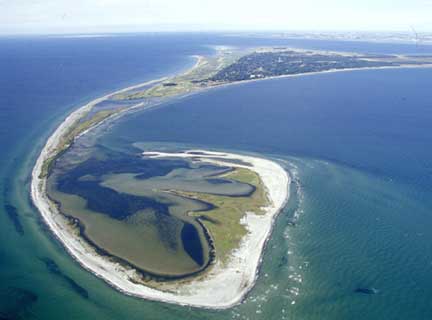 Ljungens Camping
Falsterbo, utterly inhospitable with
graceless owner: we now had the 20km drive around to the Falsterbo
peninsula to find our final campsite in Sweden and passing the trucks heading to
and from Trelleborg's port, we turned off around the final stretch of southern
coast. Crossing the canal which cuts through the peninsula at its narrowest
point, we reached the outskirts of Falsterbo and Ljungens Camping where the
most inhospitable non-welcome ever encountered greeted us. The reception was
closed and a sign said to ring the bell; we did this, and waited ... and waited
... and waited. When the owner eventually bothered to respond, his manner was
offensively surly: what did we want? to begin with, we wanted to be treated like
customers, but it went on from bad to worse. Even out of season, the cost was
240kr/night including coins for showers; the extended rigmarole of booking in
took for ever: did we have a camping card? of course; you'll need to pay a
deposit for the facilities key-card - OK, and so it went on ... and on ... and on,
when weary after a long day, all we wanted was settle in and camp! When we
finally got in, the camping area was vast and characterless, but at least the
pitches under birch trees were peaceful with just a few statics around the
perimeter. But even an Advanced Course at Charm School could do nothing to
modify the owner's utterly graceless manner, doubtless made complacent and
indifferent to any customer awareness by the endless streams of holiday-makers
who frequent this place in summer. It's a place never to return to. Ljungens Camping
Falsterbo, utterly inhospitable with
graceless owner: we now had the 20km drive around to the Falsterbo
peninsula to find our final campsite in Sweden and passing the trucks heading to
and from Trelleborg's port, we turned off around the final stretch of southern
coast. Crossing the canal which cuts through the peninsula at its narrowest
point, we reached the outskirts of Falsterbo and Ljungens Camping where the
most inhospitable non-welcome ever encountered greeted us. The reception was
closed and a sign said to ring the bell; we did this, and waited ... and waited
... and waited. When the owner eventually bothered to respond, his manner was
offensively surly: what did we want? to begin with, we wanted to be treated like
customers, but it went on from bad to worse. Even out of season, the cost was
240kr/night including coins for showers; the extended rigmarole of booking in
took for ever: did we have a camping card? of course; you'll need to pay a
deposit for the facilities key-card - OK, and so it went on ... and on ... and on,
when weary after a long day, all we wanted was settle in and camp! When we
finally got in, the camping area was vast and characterless, but at least the
pitches under birch trees were peaceful with just a few statics around the
perimeter. But even an Advanced Course at Charm School could do nothing to
modify the owner's utterly graceless manner, doubtless made complacent and
indifferent to any customer awareness by the endless streams of holiday-makers
who frequent this place in summer. It's a place never to return to.
Bird
watching on the Falsterbo sand-spit: our plan was to spend our penultimate day bird
watching down at the Falsterbo sand-spit at the tip of the peninsula. The
Falsterbo headland is formed mainly of sand built up around ridges of moraine,
with the sand-spits constantly changing shape and size as the sand is moved
around by wind and sea currents (see right). For centuries it was barren treeless heathland
with sand dunes, grazed meadows and marshes; today this open landscape is mixed
with woodland, residential areas and gardens. It is estimated that an
unbelievable 500 million birds migrate from Scandinavia every autumn following
the west and south coasts of Sweden before crossing the Baltic, the first
hazardous obstacle on their long journey south. Nabben, the SW tip of Falsterbo
is therefore the last land that birds will reach before attempting the Baltic
crossing. The shallow shores of the peninsula provide ideal feeding grounds as
the migrating birds prepare for their journey south, and in late summer and
autumn 100s thousands of birds cross the peninsula daily; the most spectacular
are the migrating raptors sometimes seen soaring around in flocks over the
heathland.
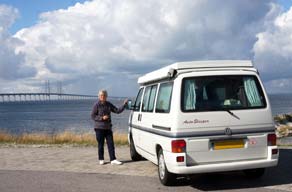 Leaving the campsite the next morning and unsure
of where the
Falsterbo bird observation station
(select the 'Bird sites' tab at left of top strip menu)
was, we wound a way through the maze of
narrow streets eventually reaching a parking area by the golf course which
spreads across the peninsula's tip; a pathway led across to the Nabben sand-spit
and the defunct lighthouse which now houses the bird station. The hazy sun
of earlier was now lost behind increasingly ominous cloud as we headed across
the golf course to the lighthouse, keeping a careful look out for flying golf
balls. The combined presence here of both golfers and twitchers, both odd
species in their own ways, seemed an uncomfortable coincidence! The bird
observation station was locked but TV monitors outside displayed information on
recent bird sightings and numbers. But the approaching thunder head of cloud Leaving the campsite the next morning and unsure
of where the
Falsterbo bird observation station
(select the 'Bird sites' tab at left of top strip menu)
was, we wound a way through the maze of
narrow streets eventually reaching a parking area by the golf course which
spreads across the peninsula's tip; a pathway led across to the Nabben sand-spit
and the defunct lighthouse which now houses the bird station. The hazy sun
of earlier was now lost behind increasingly ominous cloud as we headed across
the golf course to the lighthouse, keeping a careful look out for flying golf
balls. The combined presence here of both golfers and twitchers, both odd
species in their own ways, seemed an uncomfortable coincidence! The bird
observation station was locked but TV monitors outside displayed information on
recent bird sightings and numbers. But the approaching thunder head of cloud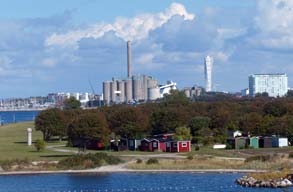 threatened a downpour and we hurried back to the camper before the storm hit.
Having sat out the lashing rain, we kitted up with waterproofs and headed back
across towards the sandbar beyond the lighthouse where cross-bills were chomping
at cones in the pine trees with their eponymous crossed bills. With the rain
starting again we headed out along the sandbar, seeing kestrels, honey
buzzards, marsh harriers and ospreys soaring over the shallow lagoons on the outer side of the sand-spit.
When we reached the far end, the gathered twitchers reluctantly made room for us
amateurs under their partial rain-shelter and with the storm finally passed, we
stood for an hour peering through our binoculars across the outer lagoons,
seeing a lone avocet foraging for food in the shallows, lapwings, mute swans,
and brent geese; along the enclosing sand-spit cormorants stood drying their
wings and soaring in flocks low over the Öresund towards the Danish coast; a
pair of grey herons stood with their heads tucked in after the rain. After our
soaking out on the Falsterbo sandpsit, we returned for a reluctant second night
at Ljungens Camping, the only site open here
threatened a downpour and we hurried back to the camper before the storm hit.
Having sat out the lashing rain, we kitted up with waterproofs and headed back
across towards the sandbar beyond the lighthouse where cross-bills were chomping
at cones in the pine trees with their eponymous crossed bills. With the rain
starting again we headed out along the sandbar, seeing kestrels, honey
buzzards, marsh harriers and ospreys soaring over the shallow lagoons on the outer side of the sand-spit.
When we reached the far end, the gathered twitchers reluctantly made room for us
amateurs under their partial rain-shelter and with the storm finally passed, we
stood for an hour peering through our binoculars across the outer lagoons,
seeing a lone avocet foraging for food in the shallows, lapwings, mute swans,
and brent geese; along the enclosing sand-spit cormorants stood drying their
wings and soaring in flocks low over the Öresund towards the Danish coast; a
pair of grey herons stood with their heads tucked in after the rain. After our
soaking out on the Falsterbo sandpsit, we returned for a reluctant second night
at Ljungens Camping, the only site open here
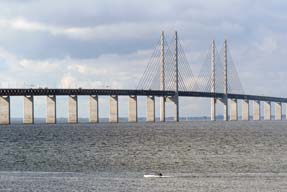 this late in the year, to dry all
our wet kit; birch leaves were now falling in increasing numbers giving the
ground a golden covering and the air that characteristic smell of autumn. this late in the year, to dry all
our wet kit; birch leaves were now falling in increasing numbers giving the
ground a golden covering and the air that characteristic smell of autumn.
The Öresund Bridge and Turning Torso at
Malmö: the our
final day in Sweden, Sheila's birthday, brought us back to where we had begun 5
months ago at the Öresund Bridge, but before re-crossing to Denmark, we
had first to visit Malmö. Before going into the city however, we planned to find
the look-out point on the appropriately named Utsiktsvägen from where we had
viewed the sweeping line of the beautiful Öresund-bro (see above left) on our first crossing of the
bridge from Denmark in 2007 (see
log of our first crossing of the Öresund Bridge in 2007). Those currently
watching the BBC4 Swedish~Danish co-production of The Bridge will be
familiar with views of the Öresund Bridge around Malmö (see left) (Photo 31 - The Öresund Bridge). From Falsterbo we joined the E6/E20 motorway to Malmö, turning westwards towards
the bridge and taking the last exit in Sweden, and the minor road leading
out to the Öresund shore-line on the swedish side. The parking area at the end
of the lane gave the perfect vantage point looking out along the elegantly
graceful curve of the bridge (Photo 32 - The Öresund Bridge viewed from the Swedish shore).
Before going into the centre of Malmö, we needed to do final provisions shopping
and recalled from 2007 a supermarket in the Västra Hamnen district close to
Scandinavia's tallest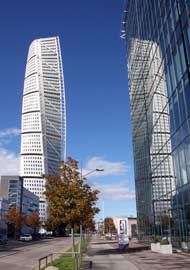 skyscraper, the 190m high Turning Torso. This had been the area once
dominated by the massive Kockums shipyards that brought Malmö prosperity during
its 19th century industrial recovery from stagnation after the medieval herring
industry declined and the city had sunk into obscurity after being cut off from
Copenhagen by Swedish re-acquisition of Skåne in 1658. Today all the industry
and shipyards are long gone, leaving a wasteland of dereliction and demolition
which developers are slowly refilling with sordid modern dereliction of office
and apartment blocks, vast car parks, and empty open nothingness of
skyscraper, the 190m high Turning Torso. This had been the area once
dominated by the massive Kockums shipyards that brought Malmö prosperity during
its 19th century industrial recovery from stagnation after the medieval herring
industry declined and the city had sunk into obscurity after being cut off from
Copenhagen by Swedish re-acquisition of Skåne in 1658. Today all the industry
and shipyards are long gone, leaving a wasteland of dereliction and demolition
which developers are slowly refilling with sordid modern dereliction of office
and apartment blocks, vast car parks, and empty open nothingness of 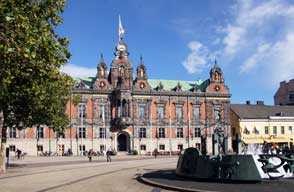 redevelopments
which only exist on the drawing boards of designers lacking any aesthetic sense. Turning Torso over-towers it all
as if to symbolise this 21st century
renaissance. redevelopments
which only exist on the drawing boards of designers lacking any aesthetic sense. Turning Torso over-towers it all
as if to symbolise this 21st century
renaissance.
We wound our way around into the former industrial
area, and found the Maxi-ICA supermarket expecting to see marked change over the
6 years. The rapid pace of regeneration however had stalled: progress seemed
little further forward since we had last been here in 2007. The demolished areas
were still a wasteland of incomplete emptiness, the vast supermarket still being
built exactly as remembered from 2007, and the air filled with the thumping of
pile-drivers from a building site opposite; it was as if we had stepped into a
time-warp where the last 6 years had stood still. Inside, the supermarket was in
the same state of incompleteness exactly as in 2007 with sections partitioned
off where builders were still working; the time-warp effect produced an oddly
eerie sensation. Around the corner looking along Västra Varvagatan,
there stood the overshadowing contorted skyscraper of Turning Torso, the
5 sides of its sleek citadel twisting through 90° over its height giving the
tower of luxury apartments a curiously oblique perspective when viewed close up
from street level. As in 2007 we took our photos using the plate-glass fronted
office building opposite to create the perfect mirror reflections of
Turning Torso (see above right) (Photo 33 - Turning Torso in Malmö).
Our visit to Malmö: fighting our way
through the chaos of incomplete redevelopment, we managed to find street parking
close to Malmö's city centre for our brief visit before finally leaving Sweden
across the Bridge. The red-brick Gothic exterior of St Petri cathedral with its
lofty spire looked Germanically forbidding, reflecting the influence of German
herring merchants attracted to Malmö in the 14~15th century when the church was
built. The interior walls had their beautiful medieval wall-paintings
white-washed over by puritanical protestant vandalism at the time of the 1532
Reformation, the only the artwork to survive being in a small side-chapel. We
walked around to the market square of Stortorget, laid out in the mid-16th century
with some of the buildings of that period surviving, notably the ornate Rådhus
and Lion Pharmacy (see above left). The square was presided over by a
domineering equestrian statue of Karl X whose armies had crossed the frozen
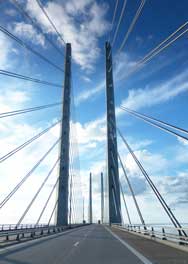 Öresund
to threaten Copenhagen, resulting in the Swedish recovery of Skåne from Danish
occupation by the 1658 Treaty of Roskilde. Round at Lilla Torget, the square was
surrounded by crowded restaurant-terraces and attractive half-timbered houses.
Having managed to change the last of our Swedish currency for Danish kroner,
albeit at a disadvantaged exchange rate, it was time to extricate the camper
from the narrow city-centre Öresund
to threaten Copenhagen, resulting in the Swedish recovery of Skåne from Danish
occupation by the 1658 Treaty of Roskilde. Round at Lilla Torget, the square was
surrounded by crowded restaurant-terraces and attractive half-timbered houses.
Having managed to change the last of our Swedish currency for Danish kroner,
albeit at a disadvantaged exchange rate, it was time to extricate the camper
from the narrow city-centre
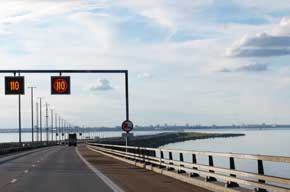 streets
and head for the Bridge. streets
and head for the Bridge.
Farewell Sweden: clearing the late
afternoon city traffic, we reached the E20 motorway and swung westwards
onto the Bridge approaches, and just before the toll-booths, paused to record
our mileage: we had driven 6,600 miles within Sweden. Driving into the western
sun we rose up to the spectacular pylons of the bridge and at its apex
re-crossed the frontier into Denmark (see left) (Photo 35 & 36 - Crossing Öresund Bridge - Farewell Sweden). Down the long sweep of causeway
towards the artificial island of Peberholm, we entered the 3.5km tunnel (see
right) to emerge into the late afternoon sunlight by Copenhagen airport for the
return drive over to Esbjerg for the ferry back to UK and a winter of writing
and catching up at home.
Our time in Sweden has given us unique experiences and
opportunity for learning as our web travelogues will, we hope, show. This is
still an enviably civilised country which has used the affluence generated in part by its
WW2 neutrality and exploitation of its vast mineral wealth to good effect to
create a society which was a delight to share during the 5 months we lived
there. Having said that, Swedish society has had to face much change brought
about by the financial stringencies of the 1990's, and
today faces the combined
challenges of
the
widening
financial gulf between the 'haves' and the 'have-nots' and of inequalities due
to increased immigration. The result is that the egalitarian culture that has
proverbially characterised Swedish society from 40 years of Social Democratic
rule has begun to break down with increased expressions of overt of materialism.
The traditional concept of lagom as an embodiment of Swedish social
values, a term with no translatable equivalent in English the nearest sense
being 'just enough' or 'moderate sufficiency', is perhaps beginning to feel less
relevant. The cultural divide also between Southern and Northern Sweden perhaps should
not have surprised us, with most Southern Swedes never having been 'north of
Watford' (in their case Uppsala), having little knowledge of all the wonderful
places we had visited in the sparsely populated north of their country. The
recollection of these travels we shall long savour and, despite the social
changes now being felt, will doubtless encourage us to
revisit Sweden in future years.
In our final edition we shall present our
customary review of all the many campsites used throughout Sweden.
Final edition
with our review of campsites to be published in 2 weeks
|
Sheila and Paul |
Published: 9 February 2013 |
|
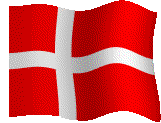
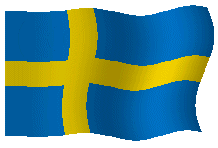
 CAMPING
IN SWEDEN 2013 - Baltic Island of Öland, Kalmar, Karlskrona, Kristianstad, Åhus,
Kivik, Stenshuvud National Park, SW coast
of Skåne,
Ystad,
Falsterbo peninsula, Malmö, Öresund Bridge for
return to Denmark and UK:
CAMPING
IN SWEDEN 2013 - Baltic Island of Öland, Kalmar, Karlskrona, Kristianstad, Åhus,
Kivik, Stenshuvud National Park, SW coast
of Skåne,
Ystad,
Falsterbo peninsula, Malmö, Öresund Bridge for
return to Denmark and UK: The
island of Öland: at
Kalmar we crossed the 6km long, high-arching toll-free bridge over the Kalmar
Sound to the Baltic Island of Öland which was to be our home for the next 5 days
(see left). The slender island is one long limestone plateau, scoured by the
last Ice Age's retreating ice, leaving a unique geology and flora. Öland had
been a royal hunting ground from the mid-16th century until 1801, ruled with
scant regard for its native peasant farmers who were barred from chopping wood,
hunting animals or selling their produce on the open market. Danish attacks
added to the Ölanders' miseries, and a series of disastrous harvests in
mid-19th century led to a quarter of the population emigrating to seek a new
life in America. Wooden windmills dating from the 18th century still cover Öland, and as we drove northwards from the bridge towards the
island's main town of Borgholm, we passed a number of these conserved by the
roadside.
The
island of Öland: at
Kalmar we crossed the 6km long, high-arching toll-free bridge over the Kalmar
Sound to the Baltic Island of Öland which was to be our home for the next 5 days
(see left). The slender island is one long limestone plateau, scoured by the
last Ice Age's retreating ice, leaving a unique geology and flora. Öland had
been a royal hunting ground from the mid-16th century until 1801, ruled with
scant regard for its native peasant farmers who were barred from chopping wood,
hunting animals or selling their produce on the open market. Danish attacks
added to the Ölanders' miseries, and a series of disastrous harvests in
mid-19th century led to a quarter of the population emigrating to seek a new
life in America. Wooden windmills dating from the 18th century still cover Öland, and as we drove northwards from the bridge towards the
island's main town of Borgholm, we passed a number of these conserved by the
roadside. Borgholm Castle: the surviving ruins of Borgholm Slott (Castle)
were silhouetted on the cliff tops as we approached the southern end of the town
(see right). Construction of the original fortress was begun in the late 12th
century by King Knut Eriksson, and when Gustav Vasa secured Swedish independence
in 1523 he strengthened the huge castle to protect his new realm, and his sons
prettified it as a Renaissance palace. In the mid-17th century Tessin the Elder
further enlarged the royal palace, but by the 18th century the disused castle
fell into ruins, finally being destroyed by fire in 1806. Today the roofless
ruins still stand proudly atop the cliffs near to one of the Swedish royal
family's summer residences, and we walked around the stark towers and redoubts
among scrub-covered meadows (Photo 1 - The ruins of Borgholm Castle).
Borgholm Castle: the surviving ruins of Borgholm Slott (Castle)
were silhouetted on the cliff tops as we approached the southern end of the town
(see right). Construction of the original fortress was begun in the late 12th
century by King Knut Eriksson, and when Gustav Vasa secured Swedish independence
in 1523 he strengthened the huge castle to protect his new realm, and his sons
prettified it as a Renaissance palace. In the mid-17th century Tessin the Elder
further enlarged the royal palace, but by the 18th century the disused castle
fell into ruins, finally being destroyed by fire in 1806. Today the roofless
ruins still stand proudly atop the cliffs near to one of the Swedish royal
family's summer residences, and we walked around the stark towers and redoubts
among scrub-covered meadows (Photo 1 - The ruins of Borgholm Castle). Wikegårds
Camping overlooking the Baltic shore-line: in
the northern outskirts of Borgholm we turned off to find the Bronze Age 3m high,
40m diameter burial mound of Blå Rör, tucked away in a sheep paddock, then
continued north on Route 136 passing some of Öland's distinctive exposed
limestone escarpments and the dry-stone walls criss-crossing the bare limestone
plateau landscape. Reaching the village of Högby, we turned off onto a
single-track lane leading across to the island's east coast to find tonight's
campsite, Wikegårds Camping. Set on a 19th century croft-farm with the camping
areas spread among the former pasture land, it was truly delightful place, but
with a tragic history so typical of the desperately hard life endured by Öland's
crofting families many of whom emigrated: the mother died early and the eldest
daughter brought up her younger siblings while father worked the farm. The 5
younger children eventually emigrated and Alma the eldest daughter
maintained the farm until she died in 1959, and the farm became a campsite in 1980. We were
welcomed by the elderly lady owner who, speaking in limited English suggested we
camp in the shelter of large juniper bushes from the brisk Öland wind, looking
out to the Baltic shoreline; it was a truly magnificent spot. Dusk was now
falling even earlier and by 8-30pm it was pitch dark; with the only lights being from an array of wind-farms out in the Baltic,
the night sky was studded with a multitude of stars and the Milky Way clearly
visible.
Wikegårds
Camping overlooking the Baltic shore-line: in
the northern outskirts of Borgholm we turned off to find the Bronze Age 3m high,
40m diameter burial mound of Blå Rör, tucked away in a sheep paddock, then
continued north on Route 136 passing some of Öland's distinctive exposed
limestone escarpments and the dry-stone walls criss-crossing the bare limestone
plateau landscape. Reaching the village of Högby, we turned off onto a
single-track lane leading across to the island's east coast to find tonight's
campsite, Wikegårds Camping. Set on a 19th century croft-farm with the camping
areas spread among the former pasture land, it was truly delightful place, but
with a tragic history so typical of the desperately hard life endured by Öland's
crofting families many of whom emigrated: the mother died early and the eldest
daughter brought up her younger siblings while father worked the farm. The 5
younger children eventually emigrated and Alma the eldest daughter
maintained the farm until she died in 1959, and the farm became a campsite in 1980. We were
welcomed by the elderly lady owner who, speaking in limited English suggested we
camp in the shelter of large juniper bushes from the brisk Öland wind, looking
out to the Baltic shoreline; it was a truly magnificent spot. Dusk was now
falling even earlier and by 8-30pm it was pitch dark; with the only lights being from an array of wind-farms out in the Baltic,
the night sky was studded with a multitude of stars and the Milky Way clearly
visible. The
gloomy cloud and drizzle had blown itself out over night and with a clear sky
and bright sun we were able to sit out for breakfast looking out across the
pastures enclosed by dry-stone walls to the distant shimmering Baltic (see
above left). One of Öland's post-windmills stood by the farm gateway, and down at the
Baltic shoreline we could gaze out across the calm seascape and spectacular Baltic sky (see right).
The
gloomy cloud and drizzle had blown itself out over night and with a clear sky
and bright sun we were able to sit out for breakfast looking out across the
pastures enclosed by dry-stone walls to the distant shimmering Baltic (see
above left). One of Öland's post-windmills stood by the farm gateway, and down at the
Baltic shoreline we could gaze out across the calm seascape and spectacular Baltic sky (see right). Öland's
windmills: our
exploration of the northern part of Öland began at Sandvik Kvarn (Mill), a
preserved Dutch windmill built originally in 1856 in Småland, transported
piecemeal and reassembled here in 1885 on a 2-storey sandstone base. It
remained in use as a working mill until 1950 when it was converted to a café.
Some 20 Dutch windmills still survive in Öland, with sails attached to a revolving
cap, unlike post-mills where the mill-cabin and sails are turned manually into
the wind on the post-pivot. The smaller post-mills would have served individual
farms, whereas the bigger Dutch mills would have been operated by a miller as a
toll mill with reimbursement made by farmers bringing their grain for grinding.
Today we decided to treat ourselves at the mill to a traditional Öland lunch of Kroppkakor, potato dumplings filled with chopped pork and onion, and
after lunch we clambered up the mill's rickety stairs to admire the intricacies
of
its wooden cog mechanism connecting the sails to the grinding wheels (see left).
Öland's
windmills: our
exploration of the northern part of Öland began at Sandvik Kvarn (Mill), a
preserved Dutch windmill built originally in 1856 in Småland, transported
piecemeal and reassembled here in 1885 on a 2-storey sandstone base. It
remained in use as a working mill until 1950 when it was converted to a café.
Some 20 Dutch windmills still survive in Öland, with sails attached to a revolving
cap, unlike post-mills where the mill-cabin and sails are turned manually into
the wind on the post-pivot. The smaller post-mills would have served individual
farms, whereas the bigger Dutch mills would have been operated by a miller as a
toll mill with reimbursement made by farmers bringing their grain for grinding.
Today we decided to treat ourselves at the mill to a traditional Öland lunch of Kroppkakor, potato dumplings filled with chopped pork and onion, and
after lunch we clambered up the mill's rickety stairs to admire the intricacies
of
its wooden cog mechanism connecting the sails to the grinding wheels (see left). We
moved on to the nearby Knisa Mosse nature reserve, an area of coastal wetlands
once used for cutting reeds and hay but now conserved, where a 500m stretch of
path led from the parking area through an oak copse to a bird observation tower
overlooking the marshes. Crossing the board-walk we found a beautiful patch of
Grass of Parnassus flowers in the moist land (see right); we had seen this
magnificent flower from way up in the Arctic right down to here in the very
south of Scandinavia. Unfortunately there was little bird life to be seen on the
marshes other than a lone grey heron fishing among the reeds.
We
moved on to the nearby Knisa Mosse nature reserve, an area of coastal wetlands
once used for cutting reeds and hay but now conserved, where a 500m stretch of
path led from the parking area through an oak copse to a bird observation tower
overlooking the marshes. Crossing the board-walk we found a beautiful patch of
Grass of Parnassus flowers in the moist land (see right); we had seen this
magnificent flower from way up in the Arctic right down to here in the very
south of Scandinavia. Unfortunately there was little bird life to be seen on the
marshes other than a lone grey heron fishing among the reeds. local population at times of
attack by raiders from across the Baltic. Further north at Källa, a single-track
lane led down to the harbour where the huge barn-like structure of Källa Gamla
Kyrka (Old Church) stood. This had been a place of worship from ancient times
close to a pagan sacred well near to the east coast port which had long been one of
the most important trading centres on Öland. With frequent attacks on the
harbour by Baltic pirates, the stone church was built in the 12th century to
double as a refuge with a further storey added later above the formerly
barrel-vaulted nave, with defensive windows to resist attackers. When the new Källa church was built in the modern village in the 19th century, the church
furnishings were transferred from the old
local population at times of
attack by raiders from across the Baltic. Further north at Källa, a single-track
lane led down to the harbour where the huge barn-like structure of Källa Gamla
Kyrka (Old Church) stood. This had been a place of worship from ancient times
close to a pagan sacred well near to the east coast port which had long been one of
the most important trading centres on Öland. With frequent attacks on the
harbour by Baltic pirates, the stone church was built in the 12th century to
double as a refuge with a further storey added later above the formerly
barrel-vaulted nave, with defensive windows to resist attackers. When the new Källa church was built in the modern village in the 19th century, the church
furnishings were transferred from the old church which fell into disuse and was conserved as a state monument. The elderly
attendant showed us the church's features and told us of its history; without
doubt this was the most impressive of the island's fortress-churches standing so
starkly by the little harbour.
church which fell into disuse and was conserved as a state monument. The elderly
attendant showed us the church's features and told us of its history; without
doubt this was the most impressive of the island's fortress-churches standing so
starkly by the little harbour. cross
to Oskarhamn on the mainland and to the Kalmar Sound islet of Blå Jungfrau, we
reached the wide rubble-field of Neptuni Åkrar, a barren beach of wave-pounded
rubble-banks above the flat slabs of bed-rock limestone along the waterline. The
flat upper surface of the slabs was scored with linear Orthoceratite
fossils, a marine cephalopod with external tubular shell. Labelled 'Neptune's
Fields' by Linné after his 1741 visit, the 200m wide rubble embankments above
the sea stretch for over 1km. Today the SW gale drove breakers crashing onto the
shoreline of limestone slabs with the bright sun lighting the pounding surf and
blue sea (see above right) (Photo
2 - Waves breaking onto Neptuni Åkrar beach). There was little plant life among the beach's barren rubble
but what did grow here in abundance were the blue-purple-pink flowers of the
spiky-leaved Viper's Bugloss (Photo 3 - Viper's Bugloss - Echium vulgare) and we were soon
cross
to Oskarhamn on the mainland and to the Kalmar Sound islet of Blå Jungfrau, we
reached the wide rubble-field of Neptuni Åkrar, a barren beach of wave-pounded
rubble-banks above the flat slabs of bed-rock limestone along the waterline. The
flat upper surface of the slabs was scored with linear Orthoceratite
fossils, a marine cephalopod with external tubular shell. Labelled 'Neptune's
Fields' by Linné after his 1741 visit, the 200m wide rubble embankments above
the sea stretch for over 1km. Today the SW gale drove breakers crashing onto the
shoreline of limestone slabs with the bright sun lighting the pounding surf and
blue sea (see above right) (Photo
2 - Waves breaking onto Neptuni Åkrar beach). There was little plant life among the beach's barren rubble
but what did grow here in abundance were the blue-purple-pink flowers of the
spiky-leaved Viper's Bugloss (Photo 3 - Viper's Bugloss - Echium vulgare) and we were soon down on hands and knees photographing the curiously attractive flowers (see
left). Not a native of Öland, the seeds are thought to have originated in a
ship-load of gravel landed at Byxelkrok in 1934 which in the absence of
competition spread along the barren limestone rubble of the Neptuni Åkrar beach.
down on hands and knees photographing the curiously attractive flowers (see
left). Not a native of Öland, the seeds are thought to have originated in a
ship-load of gravel landed at Byxelkrok in 1934 which in the absence of
competition spread along the barren limestone rubble of the Neptuni Åkrar beach. width
through forests of pine and venerable oaks out to the eastern coastline looking
across the Baltic. Sheltered from the brisk SW wind, the sea was peaceful and
lit by bright sunshine; with not a soul in sight, this was a truly beautiful
setting. The path continued northwards along the pine-fringed shingle beach,
reaching the wreck of the wooden schooner Swiks beached here in a storm
in 1926 while sailing from Wismar back to the Ålands, leaving the wreck to moulder
here ever since (see left). The ribbed carcass of the wooden boat stood on the
shingle like a beached whale. The path turned inland from the beach through pine
woods passing a gnarled oak said to be 100s year old and still thriving, and
width
through forests of pine and venerable oaks out to the eastern coastline looking
across the Baltic. Sheltered from the brisk SW wind, the sea was peaceful and
lit by bright sunshine; with not a soul in sight, this was a truly beautiful
setting. The path continued northwards along the pine-fringed shingle beach,
reaching the wreck of the wooden schooner Swiks beached here in a storm
in 1926 while sailing from Wismar back to the Ålands, leaving the wreck to moulder
here ever since (see left). The ribbed carcass of the wooden boat stood on the
shingle like a beached whale. The path turned inland from the beach through pine
woods passing a gnarled oak said to be 100s year old and still thriving, and
 crossed
back towards the eastern shore with the increasingly loud sound of wind-driven
waves on this side; looking across the bay we could see the islets and
lighthouse where we had been earlier. Re-entering the forest, we passed pine
trees twisted into convoluted shapes by wild winds in this exposed area (see
right) (Photo 4 - Wind contorted pines at Trollskogen), and turned back through shore-side woodland meadows to complete the circuit of the
forest nature trail.
crossed
back towards the eastern shore with the increasingly loud sound of wind-driven
waves on this side; looking across the bay we could see the islets and
lighthouse where we had been earlier. Re-entering the forest, we passed pine
trees twisted into convoluted shapes by wild winds in this exposed area (see
right) (Photo 4 - Wind contorted pines at Trollskogen), and turned back through shore-side woodland meadows to complete the circuit of the
forest nature trail.  along
the 1 km long stretch of coast. Looking westwards, the low sun cast a long silvery
tail across the sea lighting the silhouetted grey limestone stacks. After our
fulsome day of exploration around northern Öland, we returned
for a second night at Tokenäs Camping and quickly settled in with the SW gale
now blowing up a chill driving drizzle and the windmill silhouetted against the
evening sky
(Photo 6 - Tokenäs Camping post-windmill at sunset). The
following morning we returned to the peacefulness of Wikegårds Camping for a day
in camp, sheltered from the wind behind the juniper bushes and looking out at
the spectacular cloud-scape over the Baltic.
along
the 1 km long stretch of coast. Looking westwards, the low sun cast a long silvery
tail across the sea lighting the silhouetted grey limestone stacks. After our
fulsome day of exploration around northern Öland, we returned
for a second night at Tokenäs Camping and quickly settled in with the SW gale
now blowing up a chill driving drizzle and the windmill silhouetted against the
evening sky
(Photo 6 - Tokenäs Camping post-windmill at sunset). The
following morning we returned to the peacefulness of Wikegårds Camping for a day
in camp, sheltered from the wind behind the juniper bushes and looking out at
the spectacular cloud-scape over the Baltic. Southern Öland's
medieval fortress-churches: the following morning, after a pause along
the lane to photograph the post windmill,
we returned south through Borgholm to stock up with provisions at the ICA
supermarket, and turned off across the width of the island. The lane running
south down the east coast was a peaceful delight to drive, passing attractive
villages and farms. Our first stop was at the village of Gärdslösa to visit Öland's
best preserved medieval church with its sturdy former defensive tower and
stepped west-end gable. In bright morning sunlight we took our photos of this
beautiful church from under the trees in the carefully tended grave-yard
(Photo 7 - Öland's best preserved medieval church at Gärdslösa).
The interior was notable for its magnificent painted chancel arches (see right),
restored 17th century wall paintings and decorated pulpit carved in the 17th
century by Kalmar craftsmen. Thankfully the interior decoration had been spared
Baroque or 19th century over-elaboration, allowing the glorious simplicity of
medieval and 16~17th century artwork to speak for itself. In the west-end
porch several runic graffiti had been uncovered in the plasterwork, one
translating as 'Johann made me'. Gärdslösa was certainly a good start to today's
ecclesiastical and historical tour of southern Öland,
Southern Öland's
medieval fortress-churches: the following morning, after a pause along
the lane to photograph the post windmill,
we returned south through Borgholm to stock up with provisions at the ICA
supermarket, and turned off across the width of the island. The lane running
south down the east coast was a peaceful delight to drive, passing attractive
villages and farms. Our first stop was at the village of Gärdslösa to visit Öland's
best preserved medieval church with its sturdy former defensive tower and
stepped west-end gable. In bright morning sunlight we took our photos of this
beautiful church from under the trees in the carefully tended grave-yard
(Photo 7 - Öland's best preserved medieval church at Gärdslösa).
The interior was notable for its magnificent painted chancel arches (see right),
restored 17th century wall paintings and decorated pulpit carved in the 17th
century by Kalmar craftsmen. Thankfully the interior decoration had been spared
Baroque or 19th century over-elaboration, allowing the glorious simplicity of
medieval and 16~17th century artwork to speak for itself. In the west-end
porch several runic graffiti had been uncovered in the plasterwork, one
translating as 'Johann made me'. Gärdslösa was certainly a good start to today's
ecclesiastical and historical tour of southern Öland,
 especially
on such a sunny morning.
especially
on such a sunny morning. Gråborg
ring-fortress and medieval fortifications: 20kms
south we turned off again on one of the main cross-island roads to find Gråborg,
originally an even larger Iron Age ring fort built around 500 AD but later
adapted with strengthened walls as a medieval fortification. A small chapel
dedicated to St Knut was built nearby, and tax records show both the
fortress and chapel were owned by Vadstena Abbey and used as a trading centre
into the late medieval period; the fortress was used as late as 1677 in the wars
against the Danes. A path led past the ruins of St Knut's chapel and over to the
remains of the ring fort's surviving walls. A vaulted
Gråborg
ring-fortress and medieval fortifications: 20kms
south we turned off again on one of the main cross-island roads to find Gråborg,
originally an even larger Iron Age ring fort built around 500 AD but later
adapted with strengthened walls as a medieval fortification. A small chapel
dedicated to St Knut was built nearby, and tax records show both the
fortress and chapel were owned by Vadstena Abbey and used as a trading centre
into the late medieval period; the fortress was used as late as 1677 in the wars
against the Danes. A path led past the ruins of St Knut's chapel and over to the
remains of the ring fort's surviving walls. A vaulted
 archway,
part of the medieval fortifications led through the massive limestone walls (see
right).
Nothing of the Iron Age fortified settlement or later medieval military works
survives today leaving just the vast open space enclosed by the circular walls.
We clambered up atop the gateway admiring the massively thick structure of the
walls over 4m high and carefully constructed to have survived so long. The
effort and manpower needed to garner and dress the stone and construct the
ring-fortification of this scale defied imagination. How often, we wondered, did
the Iron Age chieftain who controlled these territories need to summon his
peasant farming folk into the security of the walled enclosure in the face of
external threat?
(Photo 10 - Gråborg ring-fortress and medieval fortifications)
archway,
part of the medieval fortifications led through the massive limestone walls (see
right).
Nothing of the Iron Age fortified settlement or later medieval military works
survives today leaving just the vast open space enclosed by the circular walls.
We clambered up atop the gateway admiring the massively thick structure of the
walls over 4m high and carefully constructed to have survived so long. The
effort and manpower needed to garner and dress the stone and construct the
ring-fortification of this scale defied imagination. How often, we wondered, did
the Iron Age chieftain who controlled these territories need to summon his
peasant farming folk into the security of the walled enclosure in the face of
external threat?
(Photo 10 - Gråborg ring-fortress and medieval fortifications) Christian
reference. The stone marks the grave of the Danish chieftain Sibbi Fuldarssson,
killed in battle around 985 AD, and was raised in dedication by his sons. The
prose dedication records the commemoration to Sibbi, and the honorific verse
which follows mentions a female Valkyrie deity Trud and reference to one of names
of Odin; clearly Sibbi still clung to the pagan Æsir beliefs.
Christian
reference. The stone marks the grave of the Danish chieftain Sibbi Fuldarssson,
killed in battle around 985 AD, and was raised in dedication by his sons. The
prose dedication records the commemoration to Sibbi, and the honorific verse
which follows mentions a female Valkyrie deity Trud and reference to one of names
of Odin; clearly Sibbi still clung to the pagan Æsir beliefs.
 landowner who stood to gain from his investment in the church from fees paid by
parishioners for baptisms, weddings and funerals. Again the tower was
strengthened as a defensive refuge, but the Danish invasions of 1677 wrought
havoc with the decorations, treasures and archives of both Resmo and
Vickeby churches plundered or destroyed.
landowner who stood to gain from his investment in the church from fees paid by
parishioners for baptisms, weddings and funerals. Again the tower was
strengthened as a defensive refuge, but the Danish invasions of 1677 wrought
havoc with the decorations, treasures and archives of both Resmo and
Vickeby churches plundered or destroyed.  bed-rock
is still entirely bare. The first humans crossed to colonise Öland while there
was still a residual ice-bridge. During the Bronze and Iron Ages, farming
developed on the Alvar which was used to graze animals. During the 18~19th
centuries over-exploitation of the poor soil led to insufficient arable land to
feed the increasing population, and many emigrated to seek a new life overseas
leaving abandoned villages like Dröstorp. Today the barren plateau is
criss-crossed by dry-stone walls and still used for livestock grazing.
We crossed the width of the island over the barren Alvaret plain to the eastern
coast, pausing to look out across this curious landscape (see left). It needed
little to see how thin the top-soil layer was and in places the bare limestone
showed through. Dry-stone walls stretched away in all directions, the plain
covered in places with stunted scrub.
bed-rock
is still entirely bare. The first humans crossed to colonise Öland while there
was still a residual ice-bridge. During the Bronze and Iron Ages, farming
developed on the Alvar which was used to graze animals. During the 18~19th
centuries over-exploitation of the poor soil led to insufficient arable land to
feed the increasing population, and many emigrated to seek a new life overseas
leaving abandoned villages like Dröstorp. Today the barren plateau is
criss-crossed by dry-stone walls and still used for livestock grazing.
We crossed the width of the island over the barren Alvaret plain to the eastern
coast, pausing to look out across this curious landscape (see left). It needed
little to see how thin the top-soil layer was and in places the bare limestone
showed through. Dry-stone walls stretched away in all directions, the plain
covered in places with stunted scrub. Seby
prehistoric grave-fields and a peaceful night's camp at Gräsgårds Fiskehamn:
we turned south on this lovely eastern coastal road and between the villages of
Segestad and Seby reached our final visit of this long day's explorations: the
prehistoric grave-fields which line the south-eastern ridge of Öland contain
some 300 standing stones and grave-mounds from the early centuries AD through to
the Viking period. The most prominent standing stones were at Seby where 2 large
monoliths marked a series of stone-settings (Photo 11 - Seby early Iron Age grave fields). A further km south a 3m high 11th
century runestone stood by the road side with the inscription Ingjald, Näf
and Sven erected this stone as a memorial to their father Rodmar (see right). Our
planned campsite for tonight at the Ottenby Vandrahem turned out to be a
cheerless and over-expensive place brim-full of statics, but fortunately we had
earlier noticed a straightforward little campsite close to Gräsgårds Fiskehamn
where working boats were moored in the picturesque little fishing harbour (Photo 12 - Gräsgårds Fiskehamn) and
cormorants perched on the rocks drying their outstretched wings.
We exchanged a few words in basic Swedish with one of the fishermen at the quay
who gladly agreed to us camping at this peaceful and charactersome place;
facilities were basic but at 110kr/night with power from a socket covered by a
fishing crate, what could be better; and we settled in to enjoy the last warmth
of the evening sun. It was another dark night with the Milky Way stretching
across a star-filled sky.
Seby
prehistoric grave-fields and a peaceful night's camp at Gräsgårds Fiskehamn:
we turned south on this lovely eastern coastal road and between the villages of
Segestad and Seby reached our final visit of this long day's explorations: the
prehistoric grave-fields which line the south-eastern ridge of Öland contain
some 300 standing stones and grave-mounds from the early centuries AD through to
the Viking period. The most prominent standing stones were at Seby where 2 large
monoliths marked a series of stone-settings (Photo 11 - Seby early Iron Age grave fields). A further km south a 3m high 11th
century runestone stood by the road side with the inscription Ingjald, Näf
and Sven erected this stone as a memorial to their father Rodmar (see right). Our
planned campsite for tonight at the Ottenby Vandrahem turned out to be a
cheerless and over-expensive place brim-full of statics, but fortunately we had
earlier noticed a straightforward little campsite close to Gräsgårds Fiskehamn
where working boats were moored in the picturesque little fishing harbour (Photo 12 - Gräsgårds Fiskehamn) and
cormorants perched on the rocks drying their outstretched wings.
We exchanged a few words in basic Swedish with one of the fishermen at the quay
who gladly agreed to us camping at this peaceful and charactersome place;
facilities were basic but at 110kr/night with power from a socket covered by a
fishing crate, what could be better; and we settled in to enjoy the last warmth
of the evening sun. It was another dark night with the Milky Way stretching
across a star-filled sky. Långe
Jan lighthouse and Ottenby bird reserve at Öland's southernmost tip: a
gloriously pink dawn lit the eastern sky over the Baltic leading to a warm,
sunny morning, and we sat out for breakfast looking across to the little fishing
harbour, cheered by a peaceful night's camp in this charming sitting. We turned
off at Ottenby along a single-track lane leading across the treeless, bleak
sheep pastures of what had once been a royal hunting estate, to the Långe Jan
lighthouse and bird observation station at Öland's southernmost tip. Migrating
birds in their 1000s cross Öland on their incredible journeys and are trapped in
nets at the Ottenby observation station,
Långe
Jan lighthouse and Ottenby bird reserve at Öland's southernmost tip: a
gloriously pink dawn lit the eastern sky over the Baltic leading to a warm,
sunny morning, and we sat out for breakfast looking across to the little fishing
harbour, cheered by a peaceful night's camp in this charming sitting. We turned
off at Ottenby along a single-track lane leading across the treeless, bleak
sheep pastures of what had once been a royal hunting estate, to the Långe Jan
lighthouse and bird observation station at Öland's southernmost tip. Migrating
birds in their 1000s cross Öland on their incredible journeys and are trapped in
nets at the Ottenby observation station,
 ringed
and sent on their way, and at the Naturum we learned more about bird migration
patterns. We walked out past the enormous base of the lighthouse to the
shore-line at the island's tip where the shallow waters of the immediate
foreshore were filled with birds (see left) (Photo 13 - Cormorants and Mute Swans off Ottenby): cormorants perched on rocks
comically splashing their wings; mute swans glided around serenely, remaining
indifferently aloof to the squawking gulls; a few mallard and grebes paddled
around busily. And further out a line of basking bulky, hump-backed Harbour
Seals made low, contented bellowing sounds to one another. and sleek Grey Seals
swam around in the shallows. We stood for an hour happily watching these
displays through our binoculars across the bay by the lighthouse (see right).
Further back from the Ottenby bird reserve at the lighthouse we walked over to
another early Iron Age burial ground marked by 2 huge monoliths, the
Kungsstenarna (King's Stones). The limestone standing stones and flat slabs were
covered with clearly visible Orthoceratite fossils (see below right).
ringed
and sent on their way, and at the Naturum we learned more about bird migration
patterns. We walked out past the enormous base of the lighthouse to the
shore-line at the island's tip where the shallow waters of the immediate
foreshore were filled with birds (see left) (Photo 13 - Cormorants and Mute Swans off Ottenby): cormorants perched on rocks
comically splashing their wings; mute swans glided around serenely, remaining
indifferently aloof to the squawking gulls; a few mallard and grebes paddled
around busily. And further out a line of basking bulky, hump-backed Harbour
Seals made low, contented bellowing sounds to one another. and sleek Grey Seals
swam around in the shallows. We stood for an hour happily watching these
displays through our binoculars across the bay by the lighthouse (see right).
Further back from the Ottenby bird reserve at the lighthouse we walked over to
another early Iron Age burial ground marked by 2 huge monoliths, the
Kungsstenarna (King's Stones). The limestone standing stones and flat slabs were
covered with clearly visible Orthoceratite fossils (see below right). Gettlinge
prehistoric burial grounds and return to the mainland: we drove back
along the south-western side of the island overlooking the Kalmar Sound, and
some 15 kms north reached the village of Gettlinge. A low ridge, the residue of
a raised beach formed by post-glacial land uplift, ran north~south between the
coastal strip and western fringe of the Stora Alvaret limestone plateau, and
would have been the only place with soil layers thick enough for human burials
and creation of burial mounds. As a result, one of Öland's largest prehistoric
burial grounds extends for some 2 kms along this ridge covering the period from
1,000 BC to 1,000 AD, with Bronze Age burial mounds, Iron Age standing stones
and stone ship-settings
Gettlinge
prehistoric burial grounds and return to the mainland: we drove back
along the south-western side of the island overlooking the Kalmar Sound, and
some 15 kms north reached the village of Gettlinge. A low ridge, the residue of
a raised beach formed by post-glacial land uplift, ran north~south between the
coastal strip and western fringe of the Stora Alvaret limestone plateau, and
would have been the only place with soil layers thick enough for human burials
and creation of burial mounds. As a result, one of Öland's largest prehistoric
burial grounds extends for some 2 kms along this ridge covering the period from
1,000 BC to 1,000 AD, with Bronze Age burial mounds, Iron Age standing stones
and stone ship-settings  from
the Viking period. Just south of the modern village, we reached the most
prominent grave fields with the close cropped turf emphasising the standing
stones when lit by the low western sun. At the northern end the stone
outline of the Gettlinge ship-setting survived with the entrance to the grave
field marked by 2 large monoliths, making a perfect picture lit by the late
afternoon sun with a 19th century post-windmill and modern wind farm as
background (see left). It was time now to be leaving Öland after such a fruitful
5 days, and after topping up our provisions at the supermarket at Färjestaden,
we re-crossed the high 6km bridge with the western sun streaking across the
Sound and the silhouette of Kalmar Castle visible on the mainland shore. The
busy evening traffic as we entered the outskirts of Kalmar came as a culture
shock after Öland's rural solitude. Our satnav guided us through residential
areas of the city to reach Stensö Camping where a locked reception presented a
total non-welcome; this was a miserable campsite with impossibly sloping ground,
and while the outside world enjoyed bright evening sunshine, Stensö camping
areas were dank, gloomy and cheerless, under the heavy shade of pine and oak
trees. Their web site ironically boasted of facilities last upgraded in
1998 and it showed! limited, antiquated and grubby would be kindest
description. We should stay one night and move on after our visit to the
historic city of Kalmar tomorrow.
from
the Viking period. Just south of the modern village, we reached the most
prominent grave fields with the close cropped turf emphasising the standing
stones when lit by the low western sun. At the northern end the stone
outline of the Gettlinge ship-setting survived with the entrance to the grave
field marked by 2 large monoliths, making a perfect picture lit by the late
afternoon sun with a 19th century post-windmill and modern wind farm as
background (see left). It was time now to be leaving Öland after such a fruitful
5 days, and after topping up our provisions at the supermarket at Färjestaden,
we re-crossed the high 6km bridge with the western sun streaking across the
Sound and the silhouette of Kalmar Castle visible on the mainland shore. The
busy evening traffic as we entered the outskirts of Kalmar came as a culture
shock after Öland's rural solitude. Our satnav guided us through residential
areas of the city to reach Stensö Camping where a locked reception presented a
total non-welcome; this was a miserable campsite with impossibly sloping ground,
and while the outside world enjoyed bright evening sunshine, Stensö camping
areas were dank, gloomy and cheerless, under the heavy shade of pine and oak
trees. Their web site ironically boasted of facilities last upgraded in
1998 and it showed! limited, antiquated and grubby would be kindest
description. We should stay one night and move on after our visit to the
historic city of Kalmar tomorrow.
 Kalmar's
historic castle and city: morning traffic was light as we drove into
Kalmar and found parking by the railway station It was a beautiful morning with
early autumn sunshine lighting the façade of the castle set on its small island
directly opposite. The original town of Kalmar developed in the shadow of the
castle which had been built in the 12th century and fully fortified by King Magnus Ladulås a century later to defend Sweden's SW coast. It was at Kalmar Castle in
1397 that Queen Margareta instigated the Union of Kalmar which merged the
thrones of Norway, Denmark and Sweden into one realm. But such was the antipathy
between Swedes and Danes that the Union was a fragile arrangement. Kalmar Castle
was in the front line of confrontation, and managed to remain unscathed despite being subjected to 11 sieges
as the 2 states rivalled for power. When Gustav Vasa secured Sweden's independence in 1523, he strengthened Kalmar Castle's
fortifications further to protect the new kingdom, while his degenerate sons
Erik and Johann chose the wall-paper to convert the Slott into a luxuriously
appointed Renaissance palace. The interior remains intact today as one of
Scandinavia's finest palaces of the period. The old town of Kalmar close to the
castle was destroyed by fire in the 1640s, and Kalmar was moved to the nearby
island of Kvarnholmen and rebuilt with Baroque precision by Tessin the Elder in
1660 as a model grid-plan with the domkyrka (cathedral) at its centre.
Being vulnerable to Danish attack during the Scanian Wars of the 1670s, the
town's island was surrounded by fortification walls. The modern city has
expanded inland but overall Kalmar remains small with a population of around
60,000.
Kalmar's
historic castle and city: morning traffic was light as we drove into
Kalmar and found parking by the railway station It was a beautiful morning with
early autumn sunshine lighting the façade of the castle set on its small island
directly opposite. The original town of Kalmar developed in the shadow of the
castle which had been built in the 12th century and fully fortified by King Magnus Ladulås a century later to defend Sweden's SW coast. It was at Kalmar Castle in
1397 that Queen Margareta instigated the Union of Kalmar which merged the
thrones of Norway, Denmark and Sweden into one realm. But such was the antipathy
between Swedes and Danes that the Union was a fragile arrangement. Kalmar Castle
was in the front line of confrontation, and managed to remain unscathed despite being subjected to 11 sieges
as the 2 states rivalled for power. When Gustav Vasa secured Sweden's independence in 1523, he strengthened Kalmar Castle's
fortifications further to protect the new kingdom, while his degenerate sons
Erik and Johann chose the wall-paper to convert the Slott into a luxuriously
appointed Renaissance palace. The interior remains intact today as one of
Scandinavia's finest palaces of the period. The old town of Kalmar close to the
castle was destroyed by fire in the 1640s, and Kalmar was moved to the nearby
island of Kvarnholmen and rebuilt with Baroque precision by Tessin the Elder in
1660 as a model grid-plan with the domkyrka (cathedral) at its centre.
Being vulnerable to Danish attack during the Scanian Wars of the 1670s, the
town's island was surrounded by fortification walls. The modern city has
expanded inland but overall Kalmar remains small with a population of around
60,000. Kalmar Länsmusem exhibiting remains from the
17th century warship Kronan: we crossed to the delightful rose
gardens along the waters edge looking across at the elegant turreted outline of
Kalmar Slott from under the trees with the morning sunlight gleaming on the
fortifications (see above right). This was a delightfully memorable spot to sit
and eat our sandwich lunch gazing across the water to the castle where the Union
of Kalmar had been signed 600 years ago (Photo 14 - Lunch at Kalmar Castle). From here we ambled through the town
past the fortification walls and guest harbour; in the distance the Öland bridge
arched across the Sound as a freighter from Kalmar's commercial docks passed
beneath. Around at the Tullhamnen, the harbour-side was dominated by a 19th
century red brick former steam mill now refurbished as the Kalmar Länsmusem, our
next port of call. The museum's permanent displays exhibit remains recovered
from the 17th century Swedish warship Kronan sunk in a naval engagement
with a Danish fleet 6 kms off the SW coast of Öland in 1676. The wreck of
Kronan was located in 1980 by underwater archaeologist Anders Franzén, who
earlier had discovered the site of the Vasa. Investigation of the 26m
deep sea bed in the Baltic's clear waters immediately revealed a whole section
of the vessel's port side, and subsequent years of underwater archaeology has systematically produced more than 25,000 artefacts ranging from the ship's huge bronze cannons
down to human skeletal remains, Kronan's ornate wooden sculptures, a treasure trove of gold and silver coins,
personal effects, clothing, pewter plates and flasks. Exploration of the
wreck site still continues and there are aspirations one day to recover and restore
the wooden remains of the ship as with Vasa which we had seen in
Stockholm (
Kalmar Länsmusem exhibiting remains from the
17th century warship Kronan: we crossed to the delightful rose
gardens along the waters edge looking across at the elegant turreted outline of
Kalmar Slott from under the trees with the morning sunlight gleaming on the
fortifications (see above right). This was a delightfully memorable spot to sit
and eat our sandwich lunch gazing across the water to the castle where the Union
of Kalmar had been signed 600 years ago (Photo 14 - Lunch at Kalmar Castle). From here we ambled through the town
past the fortification walls and guest harbour; in the distance the Öland bridge
arched across the Sound as a freighter from Kalmar's commercial docks passed
beneath. Around at the Tullhamnen, the harbour-side was dominated by a 19th
century red brick former steam mill now refurbished as the Kalmar Länsmusem, our
next port of call. The museum's permanent displays exhibit remains recovered
from the 17th century Swedish warship Kronan sunk in a naval engagement
with a Danish fleet 6 kms off the SW coast of Öland in 1676. The wreck of
Kronan was located in 1980 by underwater archaeologist Anders Franzén, who
earlier had discovered the site of the Vasa. Investigation of the 26m
deep sea bed in the Baltic's clear waters immediately revealed a whole section
of the vessel's port side, and subsequent years of underwater archaeology has systematically produced more than 25,000 artefacts ranging from the ship's huge bronze cannons
down to human skeletal remains, Kronan's ornate wooden sculptures, a treasure trove of gold and silver coins,
personal effects, clothing, pewter plates and flasks. Exploration of the
wreck site still continues and there are aspirations one day to recover and restore
the wooden remains of the ship as with Vasa which we had seen in
Stockholm ( Sinking
of the warship Kronan in 1676: Kronan had been built in
Stockholm's Skeppsholmen navy yard in 1665~68, designed by an English ship-wright
Francis Sheldon, and unlike the bulky rounded keeled Vasa, Kronan had a
deeper draft, V-shaped hull and less lofty stern. At that time she was the
largest and most heavily armed warship afloat, twice the size of the Vasa
with an armament of 126 cannons (compared with Vasa's 64) over 3 decks,
and a crew of 550 officers and men and marine complement of 300 soldiers.
Kronan was commanded by Admiral of the Fleet Lorenz Creutz, personally
appointed by the young Swedish King Karl XI. Creutz was a wealthy and
well-placed aristocrat, an administrator with just one week's naval experience!
The Swedish navy had already suffered catastrophic losses in the early stages of
the Scanian War due to poorly maintained warships, ill-trained crews,
Sinking
of the warship Kronan in 1676: Kronan had been built in
Stockholm's Skeppsholmen navy yard in 1665~68, designed by an English ship-wright
Francis Sheldon, and unlike the bulky rounded keeled Vasa, Kronan had a
deeper draft, V-shaped hull and less lofty stern. At that time she was the
largest and most heavily armed warship afloat, twice the size of the Vasa
with an armament of 126 cannons (compared with Vasa's 64) over 3 decks,
and a crew of 550 officers and men and marine complement of 300 soldiers.
Kronan was commanded by Admiral of the Fleet Lorenz Creutz, personally
appointed by the young Swedish King Karl XI. Creutz was a wealthy and
well-placed aristocrat, an administrator with just one week's naval experience!
The Swedish navy had already suffered catastrophic losses in the early stages of
the Scanian War due to poorly maintained warships, ill-trained crews,
 incompetent
seamanship and poor discipline by its aristocratic officers who had little naval
experience. Creutz set sail from Stockholm early in 1676 with 60 heavily armed
men-of-war, and orders from the king to find and destroy the Danish fleet which
some weeks before had landed a force on Gotland. Leading the fleet aboard his
flagship Kronan, Creutz was already in contention with his other
commanders who led the accompanying squadrons. In late May Kronan showed
her overwhelming firepower in a successful action against the Danes, but the
battle also revealed weaknesses of discipline with fellow commanders showing
disregard for their commander-in-chief's authority, near-mutinous discord, and
evident lack of confidence in his competence to lead the fleet. By 31 May the
Swedish fleet was off the SW coast of Öland trailed by the Danish fleet, with a
gusty gale blowing which scattered the vessels. This time, discord and rivalry
among the commanders led to disaster: on the morning of 1 June while Kronan
attempted to avoid action in the blustery conditions, Admiral Uggla ordered his
ship to alter course to face the Danes; Creutz tried to countermand the order
but was obliged to follow suit. There was discord among Kronan's officers
about increasing or decreasing sail as Kronan tacked in the blustery
wind. It was clear that the Vasa disaster of 40 years earlier was still a
vivid memory since Creutz did at least order all the cannon ports closed to
avoid shipping water as she turned. But in the swell the crew could not withdraw
Kronan's cannons; a gust of wind caused her to heave over and she began
shipping water through the still open cannon ports. A lantern ignited the
gunpowder magazine and a mighty explosion ripped Kronan apart. She sank
with the loss of 800 lives including Creutz. Kronan's design was
tried and
incompetent
seamanship and poor discipline by its aristocratic officers who had little naval
experience. Creutz set sail from Stockholm early in 1676 with 60 heavily armed
men-of-war, and orders from the king to find and destroy the Danish fleet which
some weeks before had landed a force on Gotland. Leading the fleet aboard his
flagship Kronan, Creutz was already in contention with his other
commanders who led the accompanying squadrons. In late May Kronan showed
her overwhelming firepower in a successful action against the Danes, but the
battle also revealed weaknesses of discipline with fellow commanders showing
disregard for their commander-in-chief's authority, near-mutinous discord, and
evident lack of confidence in his competence to lead the fleet. By 31 May the
Swedish fleet was off the SW coast of Öland trailed by the Danish fleet, with a
gusty gale blowing which scattered the vessels. This time, discord and rivalry
among the commanders led to disaster: on the morning of 1 June while Kronan
attempted to avoid action in the blustery conditions, Admiral Uggla ordered his
ship to alter course to face the Danes; Creutz tried to countermand the order
but was obliged to follow suit. There was discord among Kronan's officers
about increasing or decreasing sail as Kronan tacked in the blustery
wind. It was clear that the Vasa disaster of 40 years earlier was still a
vivid memory since Creutz did at least order all the cannon ports closed to
avoid shipping water as she turned. But in the swell the crew could not withdraw
Kronan's cannons; a gust of wind caused her to heave over and she began
shipping water through the still open cannon ports. A lantern ignited the
gunpowder magazine and a mighty explosion ripped Kronan apart. She sank
with the loss of 800 lives including Creutz. Kronan's design was
tried and tested and the ship was far more stable than Vasa had ever been. But
again the human factor of incompetent leadership and discord and poor
decision-taking among the officers was a major factor in a second disastrous
loss of a major vessel of the Swedish navy with all her costly armaments in 40
years.
tested and the ship was far more stable than Vasa had ever been. But
again the human factor of incompetent leadership and discord and poor
decision-taking among the officers was a major factor in a second disastrous
loss of a major vessel of the Swedish navy with all her costly armaments in 40
years. describing
the naval action and Kronan's dramatic sinking, the wreck's discovery and
underwater archaeology to recover materials from the wreck site. The subsequent
series of displays, all well-presented with multi-lingual texts, gave fulsome
explanation of Kronan's scale and armaments, and moving human detail
about the crew and life in 17th century Sweden from osteology studies of
skeletal remains recovered from the wreck. Alongside displays of artefacts such
as personal effects, table-ware and clothing, a reconstruction of the gun-deck
showed conditions on board a 17th century warship (see right); perhaps most
impressive was the treasure trove of gold and silver coins recovered from the
wreck site with ducats and tholars from around Europe and even the middle east
(see left); much of the treasure is believed to have been amassed by Creutz
himself though why he risked his fortune in the vagaries of a naval battle was
not explained. The final film outlined the vision of a future raising of
Kronan's wooden remains, their conservation and display in a purpose-built
museum just like Vasa. All in all, the Kalmar Länsmusem's displays on
Kronan were truly admirable, and although as yet having no actual ship
remains as its centrepiece, the museum certainly ranked with Stockholm's Vasa
Museum, with all the recovered artefacts giving such a memorable insight into
life in Sweden's 17th century great power period.
describing
the naval action and Kronan's dramatic sinking, the wreck's discovery and
underwater archaeology to recover materials from the wreck site. The subsequent
series of displays, all well-presented with multi-lingual texts, gave fulsome
explanation of Kronan's scale and armaments, and moving human detail
about the crew and life in 17th century Sweden from osteology studies of
skeletal remains recovered from the wreck. Alongside displays of artefacts such
as personal effects, table-ware and clothing, a reconstruction of the gun-deck
showed conditions on board a 17th century warship (see right); perhaps most
impressive was the treasure trove of gold and silver coins recovered from the
wreck site with ducats and tholars from around Europe and even the middle east
(see left); much of the treasure is believed to have been amassed by Creutz
himself though why he risked his fortune in the vagaries of a naval battle was
not explained. The final film outlined the vision of a future raising of
Kronan's wooden remains, their conservation and display in a purpose-built
museum just like Vasa. All in all, the Kalmar Länsmusem's displays on
Kronan were truly admirable, and although as yet having no actual ship
remains as its centrepiece, the museum certainly ranked with Stockholm's Vasa
Museum, with all the recovered artefacts giving such a memorable insight into
life in Sweden's 17th century great power period.
 no less
splendid. Inside, the cathedral was indeed a palace of Baroque extravaganza with
an enormous and unsightly (no other word is apt) altar piece backed by a
painting showing the Deposition graphically detailing the dead Christ being
hauled by ropes down from the cross by men on ladders. Equally obscene was the
over-ornate pulpit topped by a triple-decker confection of gnome-like sleeping
soldiers overlooking a gilded figure of Christ. In contrast with all the Baroque
exuberance, the walls were painted in refrained plain cream and covered with
huge coats of arms of aristocratic families. Before leaving Kalmar, we walked
down to the Castle and across the reconstructed drawbridge where Gustav Vasa's
bold coat of arms in limestone relief decorated the panel over the gateway. The
view from the high outer ramparts gave an full impression of the scale of Vasa's
fortifications, and a line of cannons stood in readiness to repel renewed Danish
attacks (see left).
no less
splendid. Inside, the cathedral was indeed a palace of Baroque extravaganza with
an enormous and unsightly (no other word is apt) altar piece backed by a
painting showing the Deposition graphically detailing the dead Christ being
hauled by ropes down from the cross by men on ladders. Equally obscene was the
over-ornate pulpit topped by a triple-decker confection of gnome-like sleeping
soldiers overlooking a gilded figure of Christ. In contrast with all the Baroque
exuberance, the walls were painted in refrained plain cream and covered with
huge coats of arms of aristocratic families. Before leaving Kalmar, we walked
down to the Castle and across the reconstructed drawbridge where Gustav Vasa's
bold coat of arms in limestone relief decorated the panel over the gateway. The
view from the high outer ramparts gave an full impression of the scale of Vasa's
fortifications, and a line of cannons stood in readiness to repel renewed Danish
attacks (see left). A
delightful welcome at Dalskärs Camping: it was now time to leave the
delightful town of Kalmar after our memorable visit and set off on the E22
motorway down the Småland coast heading for Dalskärs Camping which we had found
in the Swedish Camping Association listing; the owner had responded helpfully to
our telephone enquiry and stayed open to welcome us personally with our late
arrival. The camping areas were spread around reed-fringed lagoons by the
guest-harbour and weary after a long day, we settled into a delightful spot lit
by warm evening sunshine by the water's edge; the blessed St Serendipity had
come to our aid yet again in finding us such a welcoming, well-appointed and
wonderfully placed campsite, a perfect spot for tomorrow's day in camp. After a
chill night, the sun rose mistily across the water in a perfectly clear sky
(Photo 16 - Early morning mist at Dalskärs Camping); it
was a beautiful autumn morning for breakfast outside beside our reed-fringed
lagoon (see right). In such a memorably beautiful setting in perfect weather, we
enjoyed a restful and productive day in camp
(Photo 17 - Reed-fringed lagoons at Dalskärs Camping): a final load of laundry was washed
using Dalskärs' high standard facilities, we completed more writing and read up
on the next phase of our travels through Skåne, enjoyed the campsite's home made
bread, and watched a neighbouring grey heron soaring around and fishing in the
reed-beds
(Photo 18 - Grey Heron in lagoon reeds at Dalskärs Camping); and to conclude such a splendid day's camping, we cooked supper of
Swedish köttbular (meatballs) in a creamy lingonberry sauce as the evening grew
autumnally chill and misty.
A
delightful welcome at Dalskärs Camping: it was now time to leave the
delightful town of Kalmar after our memorable visit and set off on the E22
motorway down the Småland coast heading for Dalskärs Camping which we had found
in the Swedish Camping Association listing; the owner had responded helpfully to
our telephone enquiry and stayed open to welcome us personally with our late
arrival. The camping areas were spread around reed-fringed lagoons by the
guest-harbour and weary after a long day, we settled into a delightful spot lit
by warm evening sunshine by the water's edge; the blessed St Serendipity had
come to our aid yet again in finding us such a welcoming, well-appointed and
wonderfully placed campsite, a perfect spot for tomorrow's day in camp. After a
chill night, the sun rose mistily across the water in a perfectly clear sky
(Photo 16 - Early morning mist at Dalskärs Camping); it
was a beautiful autumn morning for breakfast outside beside our reed-fringed
lagoon (see right). In such a memorably beautiful setting in perfect weather, we
enjoyed a restful and productive day in camp
(Photo 17 - Reed-fringed lagoons at Dalskärs Camping): a final load of laundry was washed
using Dalskärs' high standard facilities, we completed more writing and read up
on the next phase of our travels through Skåne, enjoyed the campsite's home made
bread, and watched a neighbouring grey heron soaring around and fishing in the
reed-beds
(Photo 18 - Grey Heron in lagoon reeds at Dalskärs Camping); and to conclude such a splendid day's camping, we cooked supper of
Swedish köttbular (meatballs) in a creamy lingonberry sauce as the evening grew
autumnally chill and misty. the new naval port of Karlskrona, protected from
the new naval port of Karlskrona, protected from
 attack by an archipelago of encircling off-shore islands. Tessin the Younger,
along with military engineers laid out the dockyards, harbour, fortifications
and civilian town, all modelled on Baroque design principles; within 30 years
the city with its fortified naval base, shipyards and civilian town were fully
developed under the direction of Admiral-General Count Hans Wachtmeister as
master-engineer. Very much the Pompey of Sweden, Karlskrona remains today
Sweden's foremost naval base with significant parts of Trossö and the outer
islands off-limits as a military zone, and uniformed Naval personnel seen about
the city streets (see right) (Photo 19 - Sailors Ahoy! at Karlskrona naval port).
attack by an archipelago of encircling off-shore islands. Tessin the Younger,
along with military engineers laid out the dockyards, harbour, fortifications
and civilian town, all modelled on Baroque design principles; within 30 years
the city with its fortified naval base, shipyards and civilian town were fully
developed under the direction of Admiral-General Count Hans Wachtmeister as
master-engineer. Very much the Pompey of Sweden, Karlskrona remains today
Sweden's foremost naval base with significant parts of Trossö and the outer
islands off-limits as a military zone, and uniformed Naval personnel seen about
the city streets (see right) (Photo 19 - Sailors Ahoy! at Karlskrona naval port). we sat for our sandwiches
(see above left) (Photo 20 - Karlskrona market square). A re
we sat for our sandwiches
(see above left) (Photo 20 - Karlskrona market square). A re markably
restrained anti-NATO demonstration was being held at the far end of the square
in front of the Rådhus. Down through the gardens of Amiralitets-torget past the
apricot-coloured bell-tower built in 1699 as a clock for civilian dockyard
workers, we reached the main Guardhouse at the entrance to the protected
military zone of the naval base beyond. Razor-wire topped walls and armed
sentries formed an impregnable barrier to further intrusion into the dockyard.
Down past official-looking naval buildings in Vallgatan, a side lane ended at
the four-square wooden church of Amiralitets-kyrkan Ulrica Pia; built in 1685
for the newly established naval base and named after Karl XI's queen-consort
Ulrica Eleonora, the cruciform-shaped church seats a congregation of 4,000 (see
right). Outside by the church steps, the wooden statue of Old Rosenbom stood
waiting to attract tourists' coins for his poor-box (see left): the original
Mats Rosenbom was a shipyard worker who fell on hard times when fever killed his
6 children and left him and his wife too ill to work; reduced to beggary, and
drunk on New Year Eve 1717, he offended a wealthy ship's figurehead carver by
failing to raise his hat in thanks for a few öre; struck over the head, he froze
to death in overnight snow on the church steps. Next morning the wood carver
found his body and in remorse carved the statute of Rosenbom which now stands
where he died. It's a good yarn to entertain the tourists who have to raise his
hat to drop money in his box.
markably
restrained anti-NATO demonstration was being held at the far end of the square
in front of the Rådhus. Down through the gardens of Amiralitets-torget past the
apricot-coloured bell-tower built in 1699 as a clock for civilian dockyard
workers, we reached the main Guardhouse at the entrance to the protected
military zone of the naval base beyond. Razor-wire topped walls and armed
sentries formed an impregnable barrier to further intrusion into the dockyard.
Down past official-looking naval buildings in Vallgatan, a side lane ended at
the four-square wooden church of Amiralitets-kyrkan Ulrica Pia; built in 1685
for the newly established naval base and named after Karl XI's queen-consort
Ulrica Eleonora, the cruciform-shaped church seats a congregation of 4,000 (see
right). Outside by the church steps, the wooden statue of Old Rosenbom stood
waiting to attract tourists' coins for his poor-box (see left): the original
Mats Rosenbom was a shipyard worker who fell on hard times when fever killed his
6 children and left him and his wife too ill to work; reduced to beggary, and
drunk on New Year Eve 1717, he offended a wealthy ship's figurehead carver by
failing to raise his hat in thanks for a few öre; struck over the head, he froze
to death in overnight snow on the church steps. Next morning the wood carver
found his body and in remorse carved the statute of Rosenbom which now stands
where he died. It's a good yarn to entertain the tourists who have to raise his
hat to drop money in his box. aircraft to avoid radar detection; one of the crew gave us the low down on the
ship which we photographed along with Swedish military police who were too busy
snapping one another to give regard to their duties of guarding the ship (see
right).
aircraft to avoid radar detection; one of the crew gave us the low down on the
ship which we photographed along with Swedish military police who were too busy
snapping one another to give regard to their duties of guarding the ship (see
right). for
an ice cream. After a quick visit to the rocky islet of Stakholmen, a sunbathing
spot for local youngsters, we crossed to Björkholmen, once an impoverished area
of wooden houses for civilian dockyard workers and now yuppified as twee,
roses-round-the-door properties for BMW owners. Quite entertainingly incongruous
however was the sight at the far end of this des-res area where we came face to
face with the 6m high formidable obstacle of the Dockyard Wall (capital D,
capital W); it was like positioning a group of up-market homes in the shadow of
Wormwood Scrubs high security nick! Built in the 18~19th century to divide the
naval base from the civilian town and keep prying eyes from the naval security
zone, the Dockyard Wall still forms an impenetrable barrier. We followed
the wall around, at one point peering curiously through a security gate at the
mysteries beyond. Returning to the town, the market stalls at Stortorget and
anti-NATO demo had all packed up and gone home, replaced by a Turkish burger
bar, immigrant mums with their buggies, and young matelots chatting up the local
totties; Karl XI's statue looked down contemptuously across his Baroque
elegance, and we returned to the camper to find tonight's campsite.
for
an ice cream. After a quick visit to the rocky islet of Stakholmen, a sunbathing
spot for local youngsters, we crossed to Björkholmen, once an impoverished area
of wooden houses for civilian dockyard workers and now yuppified as twee,
roses-round-the-door properties for BMW owners. Quite entertainingly incongruous
however was the sight at the far end of this des-res area where we came face to
face with the 6m high formidable obstacle of the Dockyard Wall (capital D,
capital W); it was like positioning a group of up-market homes in the shadow of
Wormwood Scrubs high security nick! Built in the 18~19th century to divide the
naval base from the civilian town and keep prying eyes from the naval security
zone, the Dockyard Wall still forms an impenetrable barrier. We followed
the wall around, at one point peering curiously through a security gate at the
mysteries beyond. Returning to the town, the market stalls at Stortorget and
anti-NATO demo had all packed up and gone home, replaced by a Turkish burger
bar, immigrant mums with their buggies, and young matelots chatting up the local
totties; Karl XI's statue looked down contemptuously across his Baroque
elegance, and we returned to the camper to find tonight's campsite. Kristianstad and a boat-trip
in the Vattenriket
wetlands: our plan had been for a leisurely drive this morning to
Kristianstad to book a bird-watching boat-trip on the Vattenriket wetlands for
tomorrow. But on telephoning to enquire, we learnt that the only available
tour along the Helge å river was this afternoon; suddenly a relaxed day hotted
up as we hurried down the motorway to reach Kristianstad in time for today's
boat trip. We arrived with 10 minutes to spare to find the boat landing stage.
The Helge å is Skåne's longest river which rises in S
Kristianstad and a boat-trip
in the Vattenriket
wetlands: our plan had been for a leisurely drive this morning to
Kristianstad to book a bird-watching boat-trip on the Vattenriket wetlands for
tomorrow. But on telephoning to enquire, we learnt that the only available
tour along the Helge å river was this afternoon; suddenly a relaxed day hotted
up as we hurried down the motorway to reach Kristianstad in time for today's
boat trip. We arrived with 10 minutes to spare to find the boat landing stage.
The Helge å is Skåne's longest river which rises in S måland
and flows for 190kms through the flat lowlands and lakes around Kristianstad
to the coast at Hanöbuken Bay; the natural outlet of the river is at Åhus, but
in 1775 an artificial channel was cut to drain the lower marshes. The shallow
river is usually just 1m above sea level but in high Spring tides can rise to
over 2m, and gales from the SE can blow salty water and sea fish up into the
river. The Vattenriket wetlands and marshes of the Helge å river now form a UNESCO World Heritage Site, renowned for its rich
vegetation and extensive bird life. The sun was bright with brisk SE gale
blowing as the boat set off down-river to approach the reed-lined river's entry
into the Hammarsjön lake. With the wind whipping up a swell, there was little
bird-life to be seen, and the boatman began a lengthy social history of the
flatlands largely in Swedish. The boat returned up-stream passing flat lowland
riverside meadows and although we were able to see some birds of prey (kestrels,
ospreys, marsh harrier), it was an expensive and disappointing outing (Photo 21 - Kristianstad from Helge å river). By the
time we got back to the mooring, rain was beginning and we drove out to find
tonight's campsite Charlottsborgs Vandrahem and Camping 3 kms west of the town.
Out of season the hostel's warden was only present in the morning, but the
campsite was open and we settled in one of the lawned parkland pitches sheltered
by hedges.
måland
and flows for 190kms through the flat lowlands and lakes around Kristianstad
to the coast at Hanöbuken Bay; the natural outlet of the river is at Åhus, but
in 1775 an artificial channel was cut to drain the lower marshes. The shallow
river is usually just 1m above sea level but in high Spring tides can rise to
over 2m, and gales from the SE can blow salty water and sea fish up into the
river. The Vattenriket wetlands and marshes of the Helge å river now form a UNESCO World Heritage Site, renowned for its rich
vegetation and extensive bird life. The sun was bright with brisk SE gale
blowing as the boat set off down-river to approach the reed-lined river's entry
into the Hammarsjön lake. With the wind whipping up a swell, there was little
bird-life to be seen, and the boatman began a lengthy social history of the
flatlands largely in Swedish. The boat returned up-stream passing flat lowland
riverside meadows and although we were able to see some birds of prey (kestrels,
ospreys, marsh harrier), it was an expensive and disappointing outing (Photo 21 - Kristianstad from Helge å river). By the
time we got back to the mooring, rain was beginning and we drove out to find
tonight's campsite Charlottsborgs Vandrahem and Camping 3 kms west of the town.
Out of season the hostel's warden was only present in the morning, but the
campsite was open and we settled in one of the lawned parkland pitches sheltered
by hedges.
 bus! And so it went on - Swedish common sense had finally
broken down! Thankfully when we walked over to the bus stop, the bus driver was
more understanding; he let us aboard and, on arrival at the bus station in the
centre, pointed out the
bus! And so it went on - Swedish common sense had finally
broken down! Thankfully when we walked over to the bus stop, the bus driver was
more understanding; he let us aboard and, on arrival at the bus station in the
centre, pointed out the
 ticket office for our return tickets. We spent the whole
day practising correct pronunciation of Kristianstad; what looked self-evident
was in fact pronounced locally as Kri-SHAN-sta.
ticket office for our return tickets. We spent the whole
day practising correct pronunciation of Kristianstad; what looked self-evident
was in fact pronounced locally as Kri-SHAN-sta. left unfinished when the Swedes took over the fortress-town,
including Holy Trinity Church whose elegant spire never reached its intended
place but finished up decorating Copenhagen Stock Exchange instead. Christian IV's emblem, C4, ironically however still emblazons the town's coat of arms (see
above left). The town remained small during the subsequent centuries, but 19th century demolition of the
confining fortress walls enabled the growing industrial town to extend beyond
into what was formerly the wetlands. Grand Parisian-
left unfinished when the Swedes took over the fortress-town,
including Holy Trinity Church whose elegant spire never reached its intended
place but finished up decorating Copenhagen Stock Exchange instead. Christian IV's emblem, C4, ironically however still emblazons the town's coat of arms (see
above left). The town remained small during the subsequent centuries, but 19th century demolition of the
confining fortress walls enabled the growing industrial town to extend beyond
into what was formerly the wetlands. Grand Parisian- style boulevards were
created in the late 19th century, and although the town centre still retains
many of its original Renaissance buildings, these have been sullied by sordidly
dull concrete blocks of 1960~70s infills.
style boulevards were
created in the late 19th century, and although the town centre still retains
many of its original Renaissance buildings, these have been sullied by sordidly
dull concrete blocks of 1960~70s infills. 11
children, 5 of whom were crowned with garlands symbolising their deaths in
infancy (see right) (Photo 22 - Lavesen family memorial, Kristianstad). The text records the hope that the family would 'Joyfully meet again at
the resurrection of the righteous'. Of all the large churches visited in Sweden,
this was probably the most beautiful.
11
children, 5 of whom were crowned with garlands symbolising their deaths in
infancy (see right) (Photo 22 - Lavesen family memorial, Kristianstad). The text records the hope that the family would 'Joyfully meet again at
the resurrection of the righteous'. Of all the large churches visited in Sweden,
this was probably the most beautiful. seeing
the birdlife than the over-commercialised boat trip. Back over to the town, we
walked through the English-style gardens of Tivoli Park. The parkland and
avenues of horse chestnut trees were delightful with the 1906 art nouveau
theatre
at the park's centre (see left). But the sky was becoming threatening dark now with
the forecast rain
on its way as we
crossed Västra Boulevarden to walk back through the grid of streets to Stortorget.
But when we reached what ought to have been the elegant centre of Christian IV's
Renaissance town, the entire heart and soul of this charming town had been
ripped out; the whole of the square, the surrounding streets and boulevards, and
access to the Rådhus was in total devastation, being upgraded in readiness for
the 2014 400th anniversary celebrations of the town's foundation (see right). Behind the
1920s twin buildings of the Post Office and Savings Bank, the Regional Museum
was closed today, a further disappointment. The building had been begun by
Christian IV as a palace, but the 1658 re-occupation had interrupted
construction and no more than the single-storey stables which now house the
museum were completed. On the north side of the square, the 19th century
Empire-style Store Kronohuset had been built as the HQ of the Wende Artillery
Regiment and was topped with their motto 'Legibus et Armis', but the elegant
building was now obscured by road works. We tried to gain access to the town
hall to see Christian IV's bust but were prevented by the contractor's site
official, and with rain now starting we took shelter behind the church. With the
sky now dark and gloomy, we walked around for a cursory look at to the Bastion Konungen, a partial reconstruction of the Renaissance town redoubts complete
with cannons. In pouring rain on a chill and gloomy late afternoon, there was
little left now but to plodge back to the station to catch the bus back out to
the campsite.
seeing
the birdlife than the over-commercialised boat trip. Back over to the town, we
walked through the English-style gardens of Tivoli Park. The parkland and
avenues of horse chestnut trees were delightful with the 1906 art nouveau
theatre
at the park's centre (see left). But the sky was becoming threatening dark now with
the forecast rain
on its way as we
crossed Västra Boulevarden to walk back through the grid of streets to Stortorget.
But when we reached what ought to have been the elegant centre of Christian IV's
Renaissance town, the entire heart and soul of this charming town had been
ripped out; the whole of the square, the surrounding streets and boulevards, and
access to the Rådhus was in total devastation, being upgraded in readiness for
the 2014 400th anniversary celebrations of the town's foundation (see right). Behind the
1920s twin buildings of the Post Office and Savings Bank, the Regional Museum
was closed today, a further disappointment. The building had been begun by
Christian IV as a palace, but the 1658 re-occupation had interrupted
construction and no more than the single-storey stables which now house the
museum were completed. On the north side of the square, the 19th century
Empire-style Store Kronohuset had been built as the HQ of the Wende Artillery
Regiment and was topped with their motto 'Legibus et Armis', but the elegant
building was now obscured by road works. We tried to gain access to the town
hall to see Christian IV's bust but were prevented by the contractor's site
official, and with rain now starting we took shelter behind the church. With the
sky now dark and gloomy, we walked around for a cursory look at to the Bastion Konungen, a partial reconstruction of the Renaissance town redoubts complete
with cannons. In pouring rain on a chill and gloomy late afternoon, there was
little left now but to plodge back to the station to catch the bus back out to
the campsite. The small port of Åhus: from
Kristianstad we headed south on Route 118 to the small town of Åhus down on the
Skåne coast. Åhus developed as a trading settlement at the mouth of the Helge å
river, fortified with a castle to protect the flourishing port as early as Knut
the Great. The good times for Åhus came to an end in 1617 after Christian IV ordered
the town's tradesman to move to newly founded Kristianstad further inland up the
river, and Åhus lost its town status. Åhus enjoyed a new lease of life when the
arrival of the railway in the late 19th century brought the development of new
industries: the cigar factory rolled cigars
The small port of Åhus: from
Kristianstad we headed south on Route 118 to the small town of Åhus down on the
Skåne coast. Åhus developed as a trading settlement at the mouth of the Helge å
river, fortified with a castle to protect the flourishing port as early as Knut
the Great. The good times for Åhus came to an end in 1617 after Christian IV ordered
the town's tradesman to move to newly founded Kristianstad further inland up the
river, and Åhus lost its town status. Åhus enjoyed a new lease of life when the
arrival of the railway in the late 19th century brought the development of new
industries: the cigar factory rolled cigars from locally grown tobacco, and
locally caught smoked eels became an export commodity. Åhus became a popular
seaside bathing resort in the 20th century and the Absolut Vodka distillery
began production here and is still a local prominent landmark now owned by the Pernod conglomerate. We walked along the quiet town street towards the Torget
market square where the museum displayed archaeological finds telling Åhus'
early history. The NW corner of the square was dominated by the red brick gabled
tower of the Maria kyrka parts of which date from the 12th century extended over
subsequent centuries (see left) (Photo 23 - Maria kyrka at Åhus). Inside, the irregular shape of the nave and 3 bulky
pillars were evidence of the gradual process of extending the church. Its most
prominent decorations were the 16~17th century beautifully carved and decorated
wooden pulpit and altar retable. Having managed to escape Baroque and 19th
century ornamentation, this was one of Southern Sweden's most beautiful
churches. Across the square we walked along the riverside waterfront past
the Absolut Vodka distillery with its distinctive red brick clock tower (see
right);
reportedly ½ million bottles of the evil stuff are produced here daily. The
industrial harbour at the river's mouth was dominated by enormous grain silos
and the smell of barley hung in the air.
from locally grown tobacco, and
locally caught smoked eels became an export commodity. Åhus became a popular
seaside bathing resort in the 20th century and the Absolut Vodka distillery
began production here and is still a local prominent landmark now owned by the Pernod conglomerate. We walked along the quiet town street towards the Torget
market square where the museum displayed archaeological finds telling Åhus'
early history. The NW corner of the square was dominated by the red brick gabled
tower of the Maria kyrka parts of which date from the 12th century extended over
subsequent centuries (see left) (Photo 23 - Maria kyrka at Åhus). Inside, the irregular shape of the nave and 3 bulky
pillars were evidence of the gradual process of extending the church. Its most
prominent decorations were the 16~17th century beautifully carved and decorated
wooden pulpit and altar retable. Having managed to escape Baroque and 19th
century ornamentation, this was one of Southern Sweden's most beautiful
churches. Across the square we walked along the riverside waterfront past
the Absolut Vodka distillery with its distinctive red brick clock tower (see
right);
reportedly ½ million bottles of the evil stuff are produced here daily. The
industrial harbour at the river's mouth was dominated by enormous grain silos
and the smell of barley hung in the air. The
Kivik Kungagraven Bronze Age burial mound: Route 118 followed the
coast westwards around the monotonous flatlands of the Helge å estuary whose
various channels ambled through farmland down to the sea. But once we joined
Route 9, the nature of the terrain changed drastically to rolling hilly
countryside. We drove into the little fishing port of Kivik passing the field
where the village's annual market is held each July, and just beyond reached our
second visit for today, the Kivik Kungagraven (King's Grave), a huge Bronze Age
burial mound dating from around 1,000 BC. The site had been exploited during the
early 18th century as a quarrying source of building stone, until 1748 when
local farmers dug into the stone-covered mound and discovered a cist-tomb lined
with 10 stone slabs. Hoping for treasure, they continued digging but found
nothing and were arrested for tomb-robbing. Quarrying continued but then it was
discovered that the
The
Kivik Kungagraven Bronze Age burial mound: Route 118 followed the
coast westwards around the monotonous flatlands of the Helge å estuary whose
various channels ambled through farmland down to the sea. But once we joined
Route 9, the nature of the terrain changed drastically to rolling hilly
countryside. We drove into the little fishing port of Kivik passing the field
where the village's annual market is held each July, and just beyond reached our
second visit for today, the Kivik Kungagraven (King's Grave), a huge Bronze Age
burial mound dating from around 1,000 BC. The site had been exploited during the
early 18th century as a quarrying source of building stone, until 1748 when
local farmers dug into the stone-covered mound and discovered a cist-tomb lined
with 10 stone slabs. Hoping for treasure, they continued digging but found
nothing and were arrested for tomb-robbing. Quarrying continued but then it was
discovered that the
 cyst-tomb
slabs were covered with engraved petroglyphs. The site was excavated during the
1930s and 2 tombs were discovered but little in the way of remains, the
tombs having been looted over the centuries. The tombs' stone tumulus was
restored and a new artificial burial chamber created with an access tunnel cut
into the side of the mound for modern-day visitors to see the surviving engraved
upright slabs which had lined the original grave.
cyst-tomb
slabs were covered with engraved petroglyphs. The site was excavated during the
1930s and 2 tombs were discovered but little in the way of remains, the
tombs having been looted over the centuries. The tombs' stone tumulus was
restored and a new artificial burial chamber created with an access tunnel cut
into the side of the mound for modern-day visitors to see the surviving engraved
upright slabs which had lined the original grave. where
the cyst-lining of upright slabs were set up to give an impression of the
original grave. The petroglyphs had been partially coloured in with red paint to
make them more visible. The most evident engravings showed figures playing lures
and drums, a procession of cloak-wearing figures, 2 mysterious Ω symbols (see
right), and most significantly another 2 horse chariot with 4-spoked wheels
and a charioteer holding the reins (see left) (Photo 24 - 2 horse chariot and charioteer engraving), exactly as at Norrköping rock
engravings and Mycenaean paintings from contemporary Bronze Age period. This was
accompanied by a column of sword-carrying male figures perhaps representing a
funeral procession. Other slabs bore geometric patterns, particularly 2 large
sun symbols. We spent time in the gloom of the chamber photographing the
petroglyphs and marvelling at this ancient artwork so remarkably preserved and
so similar in format to other Bronze Age engravings we had seen.
where
the cyst-lining of upright slabs were set up to give an impression of the
original grave. The petroglyphs had been partially coloured in with red paint to
make them more visible. The most evident engravings showed figures playing lures
and drums, a procession of cloak-wearing figures, 2 mysterious Ω symbols (see
right), and most significantly another 2 horse chariot with 4-spoked wheels
and a charioteer holding the reins (see left) (Photo 24 - 2 horse chariot and charioteer engraving), exactly as at Norrköping rock
engravings and Mycenaean paintings from contemporary Bronze Age period. This was
accompanied by a column of sword-carrying male figures perhaps representing a
funeral procession. Other slabs bore geometric patterns, particularly 2 large
sun symbols. We spent time in the gloom of the chamber photographing the
petroglyphs and marvelling at this ancient artwork so remarkably preserved and
so similar in format to other Bronze Age engravings we had seen.
 The Stenshuvud National Park:
the
The Stenshuvud National Park:
the
 Age fort and soon emerged onto the hill's treeless southern high point (södra
huvud). The path continued through juniper bushes and brambles onto the eastern
high point from where glorious distant views looked out across the southern
sweep of beaches around Hanöbukten Bay (see left). A little further and we
reached another viewpoint on the brink of the rocky precipice dropping 90m to
the shore below with a further stunning vista out across the blue Baltic and
the Danish island of Bornholm just visible on the horizon (Photo 25 - Baltic coast-line from Stenshuvud National Park). Across through
hill-top scrub onto the northern high point, the view stretched along the
northwards coast of Hanöbukten Bay with the hill dropping sheer into a wooded
valley. Back down through the beech woods, a path led down to 18th century
shacks on the Baltic shore still used by eel fishermen. Along the shoreline with
a gentle surf lapping over our boots, the wooded headland of Stenshuvud
stood out clearly with its beeches' autumnal colours catching the sunlight (see
right). All around Kivik apple orchards fill every field and cottage garden, the
trees at this time of year laden with red, rosy apples, and on the way back to
camp we called in at Kiviks Musteri, a family-run cider and apple-juice producer
and farm shop, to sample their produce.
Age fort and soon emerged onto the hill's treeless southern high point (södra
huvud). The path continued through juniper bushes and brambles onto the eastern
high point from where glorious distant views looked out across the southern
sweep of beaches around Hanöbukten Bay (see left). A little further and we
reached another viewpoint on the brink of the rocky precipice dropping 90m to
the shore below with a further stunning vista out across the blue Baltic and
the Danish island of Bornholm just visible on the horizon (Photo 25 - Baltic coast-line from Stenshuvud National Park). Across through
hill-top scrub onto the northern high point, the view stretched along the
northwards coast of Hanöbukten Bay with the hill dropping sheer into a wooded
valley. Back down through the beech woods, a path led down to 18th century
shacks on the Baltic shore still used by eel fishermen. Along the shoreline with
a gentle surf lapping over our boots, the wooded headland of Stenshuvud
stood out clearly with its beeches' autumnal colours catching the sunlight (see
right). All around Kivik apple orchards fill every field and cottage garden, the
trees at this time of year laden with red, rosy apples, and on the way back to
camp we called in at Kiviks Musteri, a family-run cider and apple-juice producer
and farm shop, to sample their produce. Around
the Österlen coast to Dag Hammarskjöld's Backåkra farmstead: in misty autumn sunshine we continued around the Österlen coast,
passing more apple and plum orchards, into the port of Simrishamn from where
ferries sail to Bornholm. On a sunny autumn weekend Swedish visitors milled
around the port and main street. After a pause to eat our sandwich lunch at the
fishing harbour of Skillinge, we followed the minor Östra Kust vägen which winds
faithfully along the coast, and turned off to Sandhammaren beach. Set at the
angle where Skåne's southern coastline swings NE, this glorious stretch of white
sandy wild strand would be heaving with holiday-makers in the height of summer,
but thankfully in mid-September it was almost deserted. Signs warned of the
dangerous currents which wind and tide sweep around just off-shore. Just west of
here along the lane we turned off again to find the Backåkra farmstead bought by
Dag Hammarskjöld as a summer retreat. Set amid rolling heathland close to the Hagestad
Nature Reserve, the farmhouse and surrounding meadowland was willed by
Hammarskjöld to the Swedish Touring Association (STF) of which he was
vice-president, as a meeting place for cultural activities. After his tragic
death in 1961, the farm was set up by STF as a museum to Hammarskjöld's life and
work and many of the works of art collected by him were gathered there. To STF's
embarrassment however this not-for-profits organisation has found itself
strapped for cash, and last year was forced to close the Backåkra.
Around
the Österlen coast to Dag Hammarskjöld's Backåkra farmstead: in misty autumn sunshine we continued around the Österlen coast,
passing more apple and plum orchards, into the port of Simrishamn from where
ferries sail to Bornholm. On a sunny autumn weekend Swedish visitors milled
around the port and main street. After a pause to eat our sandwich lunch at the
fishing harbour of Skillinge, we followed the minor Östra Kust vägen which winds
faithfully along the coast, and turned off to Sandhammaren beach. Set at the
angle where Skåne's southern coastline swings NE, this glorious stretch of white
sandy wild strand would be heaving with holiday-makers in the height of summer,
but thankfully in mid-September it was almost deserted. Signs warned of the
dangerous currents which wind and tide sweep around just off-shore. Just west of
here along the lane we turned off again to find the Backåkra farmstead bought by
Dag Hammarskjöld as a summer retreat. Set amid rolling heathland close to the Hagestad
Nature Reserve, the farmhouse and surrounding meadowland was willed by
Hammarskjöld to the Swedish Touring Association (STF) of which he was
vice-president, as a meeting place for cultural activities. After his tragic
death in 1961, the farm was set up by STF as a museum to Hammarskjöld's life and
work and many of the works of art collected by him were gathered there. To STF's
embarrassment however this not-for-profits organisation has found itself
strapped for cash, and last year was forced to close the Backåkra.

 they were being attacked.
Perhaps after 60 years, the shady dealings behind Hammarskjöld's tragic death
will come to light. In the meantime, this peaceful farmstead left by the
post-war diplomat in the care of the STF remains closed; and no one seems
bothered. A bust of the UN Secretary General stands beside the now-locked and
deserted farmhouse (see right).
they were being attacked.
Perhaps after 60 years, the shady dealings behind Hammarskjöld's tragic death
will come to light. In the meantime, this peaceful farmstead left by the
post-war diplomat in the care of the STF remains closed; and no one seems
bothered. A bust of the UN Secretary General stands beside the now-locked and
deserted farmhouse (see right). Löderups Strandbad Camping: the only
campsite along the southern Skåne coast remaining open this late in year was Löderups Strandbad Camping and we had grave reservation from its name that it
would be static-filled and perhaps over-crowded even on a September weekend;
we had no choice but to try it and turned off on a side-lane down to the coast.
We were greeted at reception by a seemingly gruff elderly gent; 150kr a night he
responded with a shrug. The campsite was indeed filled with static caravans but
generally empty and people with trailers were busy with end-of-season demolition
of decking, fencing and garden gnomes. We found a space recently vacated by a
removed static immediately by the shore-side looking straight
out over the Baltic and, with some hesitation about the sand, settled in with a
gentle surf lapping the beach below us. Darkness fell suddenly at 8-00pm and we
enjoyed the final barbecue of the trip with
the light of a half-moon gleaming across the water (see left).
Löderups Strandbad Camping: the only
campsite along the southern Skåne coast remaining open this late in year was Löderups Strandbad Camping and we had grave reservation from its name that it
would be static-filled and perhaps over-crowded even on a September weekend;
we had no choice but to try it and turned off on a side-lane down to the coast.
We were greeted at reception by a seemingly gruff elderly gent; 150kr a night he
responded with a shrug. The campsite was indeed filled with static caravans but
generally empty and people with trailers were busy with end-of-season demolition
of decking, fencing and garden gnomes. We found a space recently vacated by a
removed static immediately by the shore-side looking straight
out over the Baltic and, with some hesitation about the sand, settled in with a
gentle surf lapping the beach below us. Darkness fell suddenly at 8-00pm and we
enjoyed the final barbecue of the trip with
the light of a half-moon gleaming across the water (see left).
 driving rain, we set of on our tour of what in fine weather would
have been a charming medieval market town. Ystad began life as a Baltic herring
fishing port-village in the early 12th century and the herring trade remained a
major local industry for centuries. In the mid-13th century the town's Maria
kyrkan was built and in 1267 Danish Grey Friars founded the monastery. In the
14th century such was Ystad's wealth that the port joined the Hanseatic League.
The monastery was closed by the 1532 Reformation, and in 1569 Ystad was attacked
by Swedes during the years of warfare over Skåne, but the port survived and
continued to flourish. As the herring industry declined, the export trade of
cattle to
driving rain, we set of on our tour of what in fine weather would
have been a charming medieval market town. Ystad began life as a Baltic herring
fishing port-village in the early 12th century and the herring trade remained a
major local industry for centuries. In the mid-13th century the town's Maria
kyrkan was built and in 1267 Danish Grey Friars founded the monastery. In the
14th century such was Ystad's wealth that the port joined the Hanseatic League.
The monastery was closed by the 1532 Reformation, and in 1569 Ystad was attacked
by Swedes during the years of warfare over Skåne, but the port survived and
continued to flourish. As the herring industry declined, the export trade of
cattle to North Germany increased in importance. By the time Skåne became
Swedish in 1658 Ystad had reached a population of 2,000 and a regular post-boat
service to Stralsund began. The trading port increased in size and wealthy
merchants built imposing houses in the town. With the arrival of the railway,
Ystad became a popular seaside resort and the port continued to bring prosperity
to the town. There are still major ferry links to Świnoujście in
Northern Poland and to Bornholm, and Henning Mankell's Wallander detective
novels are set
around Ystad.
North Germany increased in importance. By the time Skåne became
Swedish in 1658 Ystad had reached a population of 2,000 and a regular post-boat
service to Stralsund began. The trading port increased in size and wealthy
merchants built imposing houses in the town. With the arrival of the railway,
Ystad became a popular seaside resort and the port continued to bring prosperity
to the town. There are still major ferry links to Świnoujście in
Northern Poland and to Bornholm, and Henning Mankell's Wallander detective
novels are set
around Ystad. By the time we emerged from the church the rain
had eased for us to walk along Lilla Västergatan to photograph the 16th century
half-timbered cottages (see above left) and stepped-gabled Latin School. Along Stora Östergatan
main street, we called in at the System Bolaget for bottles of the local beer;
the manager put up a brave defence of the Swedish government protected trading
monopoly on alcohol. After viewing the 18th century half-timbered cottages in
Väderägrand, we walked along Norrgatan to admire the beautifully restored 16th
century Änglahuset with its carved, decorated beam-ends of its half-timbering.
Just along a side street, the attractively restored red brick former Klostret
(monastery) now doubles as parish church and museum (see above right).
By the time we emerged from the church the rain
had eased for us to walk along Lilla Västergatan to photograph the 16th century
half-timbered cottages (see above left) and stepped-gabled Latin School. Along Stora Östergatan
main street, we called in at the System Bolaget for bottles of the local beer;
the manager put up a brave defence of the Swedish government protected trading
monopoly on alcohol. After viewing the 18th century half-timbered cottages in
Väderägrand, we walked along Norrgatan to admire the beautifully restored 16th
century Änglahuset with its carved, decorated beam-ends of its half-timbering.
Just along a side street, the attractively restored red brick former Klostret
(monastery) now doubles as parish church and museum (see above right). Iron Age stone ship-setting burial monument of
Ales Stenar: despite our initial reservations, Löderups Strandbad
Camping had served us well: its scruffy familiarity, magnificent shore-side
setting with pounding surf, and charactersome owner had endeared themselves to
us; but of course only at this late stage of the year when most of the usual
summer occupants had long departed leaving the site in peace! With brighter sun
and just a thin veil of cloud, we drove westwards around the coast road and
turned off to the car park in Kåseberga fishing village. A path led past the
cottages uphill to the sandy cliff-tops above the little harbour, leading to the
flat-topped meadowland on the breezy hill top. Ahead we could see the Ales
Stenar circle of megaliths silhouetted against the sky: 59 standing stones
arranged in a 67m long ship-setting with larger bow and stern
Iron Age stone ship-setting burial monument of
Ales Stenar: despite our initial reservations, Löderups Strandbad
Camping had served us well: its scruffy familiarity, magnificent shore-side
setting with pounding surf, and charactersome owner had endeared themselves to
us; but of course only at this late stage of the year when most of the usual
summer occupants had long departed leaving the site in peace! With brighter sun
and just a thin veil of cloud, we drove westwards around the coast road and
turned off to the car park in Kåseberga fishing village. A path led past the
cottages uphill to the sandy cliff-tops above the little harbour, leading to the
flat-topped meadowland on the breezy hill top. Ahead we could see the Ales
Stenar circle of megaliths silhouetted against the sky: 59 standing stones
arranged in a 67m long ship-setting with larger bow and stern
 stones make up the
megalithic monument which has been dated to the late Iron Age between 600~1,000
AD. The stones, each weighing over a ton, are not native to these parts and must
have been transported here. Evidence of earlier Bronze Age burials beneath the
stones suggests it had long been a sacred place of worship, assembly and memorial, and looking around the mysterious cliff-top and rolling coastal hills, you
could understand why. Various bizarre theories have been advanced about the
alignment of stones forming a solar calendar. Standing there on the cliff-top
however in the soft, hazy sunlight, looking across the ship-setting with cattle
grazing peacefully around the meadow, it was enough to acknowledge their
timelessness and the beauty of the setting looking out across the Baltic. We
took our photos both of the stones and along the line of sand cliffs stretching
away westwards with the wind driving surf onto the beach below, and returned
downhill to the little fishing harbour of Kåseberga nestled into the sheltered
cove below. Here at the
stones make up the
megalithic monument which has been dated to the late Iron Age between 600~1,000
AD. The stones, each weighing over a ton, are not native to these parts and must
have been transported here. Evidence of earlier Bronze Age burials beneath the
stones suggests it had long been a sacred place of worship, assembly and memorial, and looking around the mysterious cliff-top and rolling coastal hills, you
could understand why. Various bizarre theories have been advanced about the
alignment of stones forming a solar calendar. Standing there on the cliff-top
however in the soft, hazy sunlight, looking across the ship-setting with cattle
grazing peacefully around the meadow, it was enough to acknowledge their
timelessness and the beauty of the setting looking out across the Baltic. We
took our photos both of the stones and along the line of sand cliffs stretching
away westwards with the wind driving surf onto the beach below, and returned
downhill to the little fishing harbour of Kåseberga nestled into the sheltered
cove below. Here at the rökeri we bought more smoked fish for our final nights'
suppers.
rökeri we bought more smoked fish for our final nights'
suppers. distances London 991km, Stockholm 510km, Copenhagen 61km and Treriksröset
1572km, although had we taken a straw-poll of Swedes snapping away here before
piling back into their tour-bus, doubtless not one would have known where the
Three Countries Stone was and its significance! (
distances London 991km, Stockholm 510km, Copenhagen 61km and Treriksröset
1572km, although had we taken a straw-poll of Swedes snapping away here before
piling back into their tour-bus, doubtless not one would have known where the
Three Countries Stone was and its significance! (
 We
had visited 3 of Harold's identically arranged ring-fort at Trelleborg in
Sjæland and at Fyrkat and Aggersborg in North Jutland. Little of these had
survived except the circuit of earthworks which had originally formed the core
of timber-palisade fortification walls. Here in Skåne Trelleborg in 1988, a
quarter-segment of earthworks core had been discovered and excavated after 1,000
years. The rest were now buried under later medieval streets and buildings and a
city street, Bryggaregatan, ran through the middle along the same direction as
the Viking road. By the time of the 13th century when Trelleborg gained its city
status, the Viking fortress had given its name to the place: Trelleborg (borg
meaning fortress, and threlae meaning the timber poles which formed the
outer palisade-cladding of the earthwork walls) had been buried and
forgotten for over 200 years. The surviving quarter-segment of circular
earthworks was reconstructed with their timber palisade cladding and one of the
4 gatehouses, giving a vivid impression of what the original Trelleborg fortress
would have looked like: Harold Bluetooth's Trelleborg had risen from the ashes.
We
had visited 3 of Harold's identically arranged ring-fort at Trelleborg in
Sjæland and at Fyrkat and Aggersborg in North Jutland. Little of these had
survived except the circuit of earthworks which had originally formed the core
of timber-palisade fortification walls. Here in Skåne Trelleborg in 1988, a
quarter-segment of earthworks core had been discovered and excavated after 1,000
years. The rest were now buried under later medieval streets and buildings and a
city street, Bryggaregatan, ran through the middle along the same direction as
the Viking road. By the time of the 13th century when Trelleborg gained its city
status, the Viking fortress had given its name to the place: Trelleborg (borg
meaning fortress, and threlae meaning the timber poles which formed the
outer palisade-cladding of the earthwork walls) had been buried and
forgotten for over 200 years. The surviving quarter-segment of circular
earthworks was reconstructed with their timber palisade cladding and one of the
4 gatehouses, giving a vivid impression of what the original Trelleborg fortress
would have looked like: Harold Bluetooth's Trelleborg had risen from the ashes. Ljungens Camping
Falsterbo, utterly inhospitable with
graceless owner: we now had the 20km drive around to the Falsterbo
peninsula to find our final campsite in Sweden and passing the trucks heading to
and from Trelleborg's port, we turned off around the final stretch of southern
coast. Crossing the canal which cuts through the peninsula at its narrowest
point, we reached the outskirts of Falsterbo and Ljungens Camping where the
most inhospitable non-welcome ever encountered greeted us. The reception was
closed and a sign said to ring the bell; we did this, and waited ... and waited
... and waited. When the owner eventually bothered to respond, his manner was
offensively surly: what did we want? to begin with, we wanted to be treated like
customers, but it went on from bad to worse. Even out of season, the cost was
240kr/night including coins for showers; the extended rigmarole of booking in
took for ever: did we have a camping card? of course; you'll need to pay a
deposit for the facilities key-card - OK, and so it went on ... and on ... and on,
when weary after a long day, all we wanted was settle in and camp! When we
finally got in, the camping area was vast and characterless, but at least the
pitches under birch trees were peaceful with just a few statics around the
perimeter. But even an Advanced Course at Charm School could do nothing to
modify the owner's utterly graceless manner, doubtless made complacent and
indifferent to any customer awareness by the endless streams of holiday-makers
who frequent this place in summer. It's a place never to return to.
Ljungens Camping
Falsterbo, utterly inhospitable with
graceless owner: we now had the 20km drive around to the Falsterbo
peninsula to find our final campsite in Sweden and passing the trucks heading to
and from Trelleborg's port, we turned off around the final stretch of southern
coast. Crossing the canal which cuts through the peninsula at its narrowest
point, we reached the outskirts of Falsterbo and Ljungens Camping where the
most inhospitable non-welcome ever encountered greeted us. The reception was
closed and a sign said to ring the bell; we did this, and waited ... and waited
... and waited. When the owner eventually bothered to respond, his manner was
offensively surly: what did we want? to begin with, we wanted to be treated like
customers, but it went on from bad to worse. Even out of season, the cost was
240kr/night including coins for showers; the extended rigmarole of booking in
took for ever: did we have a camping card? of course; you'll need to pay a
deposit for the facilities key-card - OK, and so it went on ... and on ... and on,
when weary after a long day, all we wanted was settle in and camp! When we
finally got in, the camping area was vast and characterless, but at least the
pitches under birch trees were peaceful with just a few statics around the
perimeter. But even an Advanced Course at Charm School could do nothing to
modify the owner's utterly graceless manner, doubtless made complacent and
indifferent to any customer awareness by the endless streams of holiday-makers
who frequent this place in summer. It's a place never to return to. Leaving the campsite the next morning and unsure
of where the
Leaving the campsite the next morning and unsure
of where the
 threatened a downpour and we hurried back to the camper before the storm hit.
Having sat out the lashing rain, we kitted up with waterproofs and headed back
across towards the sandbar beyond the lighthouse where cross-bills were chomping
at cones in the pine trees with their eponymous crossed bills. With the rain
starting again we headed out along the sandbar, seeing kestrels, honey
buzzards, marsh harriers and ospreys soaring over the shallow lagoons on the outer side of the sand-spit.
When we reached the far end, the gathered twitchers reluctantly made room for us
amateurs under their partial rain-shelter and with the storm finally passed, we
stood for an hour peering through our binoculars across the outer lagoons,
seeing a lone avocet foraging for food in the shallows, lapwings, mute swans,
and brent geese; along the enclosing sand-spit cormorants stood drying their
wings and soaring in flocks low over the Öresund towards the Danish coast; a
pair of grey herons stood with their heads tucked in after the rain. After our
soaking out on the Falsterbo sandpsit, we returned for a reluctant second night
at Ljungens Camping, the only site open here
threatened a downpour and we hurried back to the camper before the storm hit.
Having sat out the lashing rain, we kitted up with waterproofs and headed back
across towards the sandbar beyond the lighthouse where cross-bills were chomping
at cones in the pine trees with their eponymous crossed bills. With the rain
starting again we headed out along the sandbar, seeing kestrels, honey
buzzards, marsh harriers and ospreys soaring over the shallow lagoons on the outer side of the sand-spit.
When we reached the far end, the gathered twitchers reluctantly made room for us
amateurs under their partial rain-shelter and with the storm finally passed, we
stood for an hour peering through our binoculars across the outer lagoons,
seeing a lone avocet foraging for food in the shallows, lapwings, mute swans,
and brent geese; along the enclosing sand-spit cormorants stood drying their
wings and soaring in flocks low over the Öresund towards the Danish coast; a
pair of grey herons stood with their heads tucked in after the rain. After our
soaking out on the Falsterbo sandpsit, we returned for a reluctant second night
at Ljungens Camping, the only site open here
 this late in the year, to dry all
our wet kit; birch leaves were now falling in increasing numbers giving the
ground a golden covering and the air that characteristic smell of autumn.
this late in the year, to dry all
our wet kit; birch leaves were now falling in increasing numbers giving the
ground a golden covering and the air that characteristic smell of autumn. skyscraper, the 190m high Turning Torso. This had been the area once
dominated by the massive Kockums shipyards that brought Malmö prosperity during
its 19th century industrial recovery from stagnation after the medieval herring
industry declined and the city had sunk into obscurity after being cut off from
Copenhagen by Swedish re-acquisition of Skåne in 1658. Today all the industry
and shipyards are long gone, leaving a wasteland of dereliction and demolition
which developers are slowly refilling with sordid modern dereliction of office
and apartment blocks, vast car parks, and empty open nothingness of
skyscraper, the 190m high Turning Torso. This had been the area once
dominated by the massive Kockums shipyards that brought Malmö prosperity during
its 19th century industrial recovery from stagnation after the medieval herring
industry declined and the city had sunk into obscurity after being cut off from
Copenhagen by Swedish re-acquisition of Skåne in 1658. Today all the industry
and shipyards are long gone, leaving a wasteland of dereliction and demolition
which developers are slowly refilling with sordid modern dereliction of office
and apartment blocks, vast car parks, and empty open nothingness of  redevelopments
which only exist on the drawing boards of designers lacking any aesthetic sense. Turning Torso over-towers it all
as if to symbolise this 21st century
renaissance.
redevelopments
which only exist on the drawing boards of designers lacking any aesthetic sense. Turning Torso over-towers it all
as if to symbolise this 21st century
renaissance. Öresund
to threaten Copenhagen, resulting in the Swedish recovery of Skåne from Danish
occupation by the 1658 Treaty of Roskilde. Round at Lilla Torget, the square was
surrounded by crowded restaurant-terraces and attractive half-timbered houses.
Having managed to change the last of our Swedish currency for Danish kroner,
albeit at a disadvantaged exchange rate, it was time to extricate the camper
from the narrow city-centre
Öresund
to threaten Copenhagen, resulting in the Swedish recovery of Skåne from Danish
occupation by the 1658 Treaty of Roskilde. Round at Lilla Torget, the square was
surrounded by crowded restaurant-terraces and attractive half-timbered houses.
Having managed to change the last of our Swedish currency for Danish kroner,
albeit at a disadvantaged exchange rate, it was time to extricate the camper
from the narrow city-centre
 streets
and head for the Bridge.
streets
and head for the Bridge.